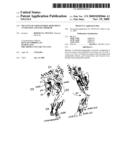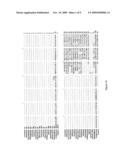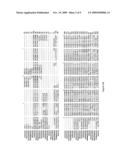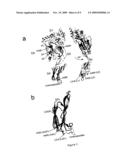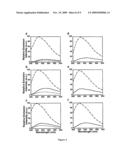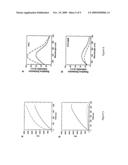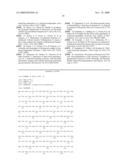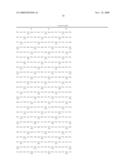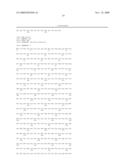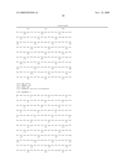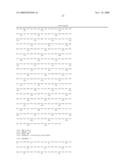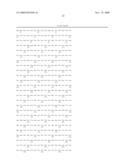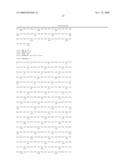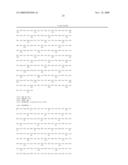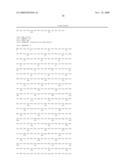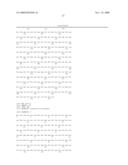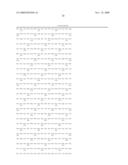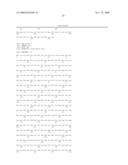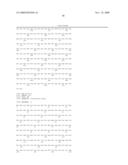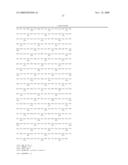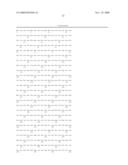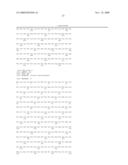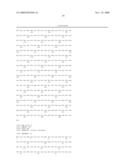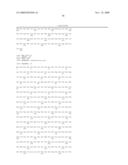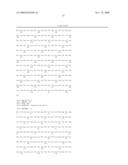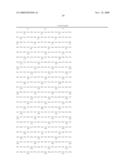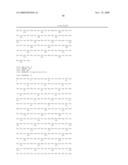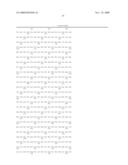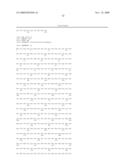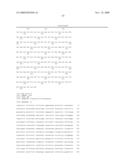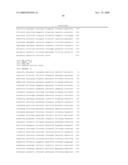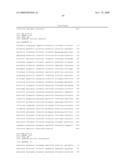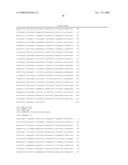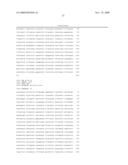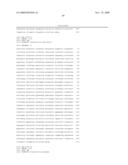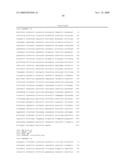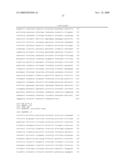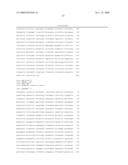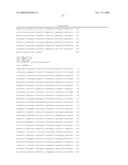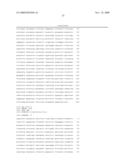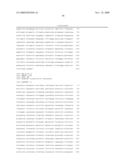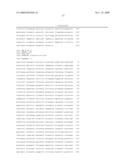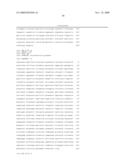Patent application title: MUTANTS OF CHOLESTEROL-DEPENDENT CYTOLYSINS AND USES THEREOF
Inventors:
Rodney K. Tweten (Edmond, OK, US)
IPC8 Class: AA61K3902FI
USPC Class:
4241901
Class name: Antigen, epitope, or other immunospecific immunoeffector (e.g., immunospecific vaccine, immunospecific stimulator of cell-mediated immunity, immunospecific tolerogen, immunospecific immunosuppressor, etc.) amino acid sequence disclosed in whole or in part; or conjugate, complex, or fusion protein or fusion polypeptide including the same disclosed amino acid sequence derived from bacterium (e.g., mycoplasma, anaplasma, etc.)
Publication date: 2009-11-19
Patent application number: 20090285846
Claims:
1. A purified mutant cholesterol-dependent cytolysin, comprising:a
polypeptide having at least one amino acid substitution in at least one
of a first loop, a second loop, or a third loop of an amino acid sequence
comprising SEQ ID NO:1, SEQ ID NO:9, SEQ ID NO:13, SEQ ID NO:17 or SEQ ID
NO:18, wherein in SEQ ID NO:1, the first loop, second loop, and third
loop comprise amino acid positions 457-463, 367-373, and 403-409,
respectively, and wherein in SEQ ID NO:9, the first loop, second loop,
and third loop comprise amino acid positions 559-565, 469-475, and
505-511, respectively, and wherein in SEQ ID NO:13, the first loop,
second loop and third loop comprise amino acid positions 513-519,
423-429, and 459-465, respectively, and wherein in SEQ ID NO:17, the
first loop, second loop, and third loop comprise amino acid positions
515-521, 425-431, and 461-467, respectively, and wherein in SEQ ID NO:18,
the first loop, second loop, and third loop comprise amino acid positions
651-657, 561-567, and 597-603, respectively, and wherein when the amino
acid sequence is SEQ ID NO:1, the at least one amino acid substitution is
in at least one of the first loop or third loop thereof.
2. The purified mutant cholesterol-dependent cytolysin of claim 1 wherein the amino acid sequence is SEQ ID NO:1 and comprises 1 to 7 amino acid substitutions in at least one of the first loop and the third loop.
3. The purified mutant cholesterol-dependent cytolysin of claim 2 further comprising 1 to 7 amino acid substitutions in the second loop.
4. The purified mutant cholesterol-dependent cytolysin of claim 1 wherein the amino acid sequence is SEQ ID NO:9 and comprises 1 to 7 amino acid substitutions in at least one of the first loop, the second loop, and the third loop.
5. The purified mutant cholesterol-dependent cytolysin of claim 1 wherein the amino acid sequence is SEQ ID NO:13 and comprises 1 to 7 amino acid substitutions in at least one of the first loop, the second loop, and the third loop.
6. The purified mutant cholesterol-dependent cytolysin of claim 1 wherein the amino acid sequence is SEQ ID NO:17 and comprises 1 to 7 amino acid substitutions in at least one of the first loop, the second loop, and the third loop.
7. The purified mutant cholesterol-dependent cytolysin of claim 1 wherein the amino acid sequence is SEQ ID NO:18 and comprises 1 to 7 amino acid substitutions in at least one of the first loop, the second loop, and the third loop.
8. The purified mutant cholesterol-dependent cytolysin of claim 1 wherein the polypeptide is substantially non-hemolytic, non-pore forming, and non-binding to cell membranes.
9. A composition comprising the purified mutant cholesterol-dependent cytolysin of claim 1, and a pharmaceutically-acceptable carrier or vehicle.
10. A vaccine comprising the purified mutant cholesterol-dependent cytolysin of claim 1.
11. The vaccine of claim 10 further comprising capsular polysaccharide serotypes, or immunogenic proteins or protein subunits or fragments.
12. A method vaccinating a subject, comprising:providing the vaccine of claim 10 and administering the vaccine to the subject wherein an immunogenic response is induced in the subject.
13. A purified mutant cholesterol-dependent cytolysin, comprising:a polypeptide having at least one amino acid substitution in at least one of a first loop, a second loop, or a third loop of an amino acid sequence comprising SEQ ID NO:2, SEQ ID NO:3, SEQ ID NO:4, SEQ ID NO:5, or SEQ ID NO:6, wherein in SEQ ID NO:2, the first loop, second loop, and third loop comprise amino acid positions 498-504, 408-414, and 444-450, respectively, and wherein in SEQ ID NO:3, the first loop, second loop, and third loop comprise amino acid positions 501-507, 411-417, and 447-453, respectively, and wherein in SEQ ID NO:4, the first loop, second loop and third loop comprise amino acid positions 501-507, 411-417, and 447-453, respectively, and wherein in SEQ ID NO:5, the first loop, second loop, and third loop comprise amino acid positions 488-494, 398-404, and 434-440, respectively, and wherein in SEQ ID NO:6, the first loop, second loop, and third loop comprise amino acid positions 490-496, 400-406, and 436-442, respectively.
14. The purified mutant cholesterol-dependent cytolysin of claim 13 wherein the amino acid sequence is SEQ ID NO:2 and comprises 1 to 7 amino acid substitutions in at least one of the first loop, the second loop, and the third loop.
15. The purified mutant cholesterol-dependent cytolysin of claim 13 wherein the amino acid sequence is SEQ ID NO:3 and comprises 1 to 7 amino acid substitutions in at least one of the first loop, the second loop, and the third loop.
16. The purified mutant cholesterol-dependent cytolysin of claim 13 wherein the amino acid sequence is SEQ ID NO:4 and comprises 1 to 7 amino acid substitutions in at least one of the first loop, the second loop, and the third loop.
17. The purified mutant cholesterol-dependent cytolysin of claim 13 wherein the amino acid sequence is SEQ ID NO:5 and comprises 1 to 7 amino acid substitutions in at least one of the first loop, the second loop, and the third loop.
18. The purified mutant cholesterol-dependent cytolysin of claim 13 wherein the amino acid sequence is SEQ ID NO:6 and comprises 1 to 7 amino acid substitutions in at least one of the first loop, the second loop, and the third loop.
19. A purified mutant cholesterol-dependent cytolysin, comprising:a polypeptide having at least one amino acid substitution in at least one of a first loop, a second loop, or a third loop of an amino acid sequence comprising SEQ ID NO:7, SEQ ID NO:8, SEQ ID NO:10, SEQ ID NO:11, or SEQ ID NO:12, wherein in SEQ ID NO:7, the first loop, second loop, and third loop comprise amino acid positions 562-568, 472-478, and 508-514, respectively, and wherein in SEQ ID NO:8, the first loop, second loop, and third loop comprise amino acid positions 559-565, 469-475, and 505-511, respectively, and wherein in SEQ ID NO:10, the first loop, second loop and third loop comprise amino acid positions 502-508, 412-418, and 448-454, respectively, and wherein in SEQ ID NO:11, the first loop, second loop, and third loop comprise amino acid positions 514-520, 424-430, and 460-466, respectively, and wherein in SEQ ID NO:12, the first loop, second loop, and third loop comprise amino acid positions 512-518, 422-428, and 458-464, respectively.
20. The purified mutant cholesterol-dependent cytolysin of claim 19 wherein the amino acid sequence is SEQ ID NO:7 and comprises 1 to 7 amino acid substitutions in at least one of the first loop, the second loop, and the third loop.
21. The purified mutant cholesterol-dependent cytolysin of claim 19 wherein the amino acid sequence is SEQ ID NO:8 and comprises 1 to 7 amino acid substitutions in at least one of the first loop, the second loop, and the third loop.
22. The purified mutant cholesterol-dependent cytolysin of claim 19 wherein the amino acid sequence is SEQ ID NO:10 and comprises 1 to 7 amino acid substitutions in at least one of the first loop, the second loop, and the third loop.
23. The purified mutant cholesterol-dependent cytolysin of claim 19 wherein the amino acid sequence is SEQ ID NO:11 and comprises 1 to 7 amino acid substitutions in at least one of the first loop, the second loop, and the third loop.
24. The purified mutant cholesterol-dependent cytolysin of claim 19 wherein the amino acid sequence is SEQ ID NO:12 and comprises 1 to 7 amino acid substitutions in at least one of the first loop, the second loop, and the third loop.
25. A purified mutant cholesterol-dependent cytolysin, comprising:a polypeptide having at least one amino acid substitution in at least one of a first loop, a second loop, or a third loop of an amino acid sequence comprising SEQ ID NO:14, SEQ ID NO:15, SEQ ID NO:16, or SEQ ID NO:19, wherein in SEQ ID NO:14, the first loop, second loop, and third loop comprise amino acid positions 514-520, 424-430, and 460-466, respectively, and wherein in SEQ ID NO:15, the first loop, second loop, and third loop comprise amino acid positions 494-490, 395-401, and 431-437, respectively, and wherein in SEQ ID NO:16, the first loop, second loop and third loop comprise amino acid positions 457-463, 367-373, and 403-409, respectively, and wherein in SEQ ID NO:19, the first loop, second loop, and third loop comprise amino acid positions 521-527, 431-437, and 467-473, respectively.
26. The purified mutant cholesterol-dependent cytolysin of claim 25 wherein the amino acid sequence is SEQ ID NO:14 and comprises 1 to 7 amino acid substitutions in at least one of the first loop, the second loop, and the third loop.
27. The purified mutant cholesterol-dependent cytolysin of claim 25 wherein the amino acid sequence is SEQ ID NO:15 and comprises 1 to 7 amino acid substitutions in at least one of the first loop, the second loop, and the third loop.
28. The purified mutant cholesterol-dependent cytolysin of claim 25 wherein the amino acid sequence is SEQ ID NO:16 and comprises 1 to 7 amino acid substitutions in at least one of the first loop, the second loop, and the third loop.
29. The purified mutant cholesterol-dependent cytolysin of claim 25 wherein the amino acid sequence is SEQ ID NO:19 and comprises 1 to 7 amino acid substitutions in at least one of the first loop, the second loop, and the third loop.
30. A purified mutant cholesterol-dependent cytolysin, comprising:a polypeptide having at least one amino acid substitution in at least one of a first hydrophobic loop, a second hydrophobic loop, or a third hydrophobic loop of an amino acid sequence comprising SEQ ID NO:1, SEQ ID NO:2, SEQ ID NO:3, SEQ ID NO:4, SEQ ID NO:5, SEQ ID NO:6, SEQ ID NO:7, SEQ ID NO:8, SEQ ID NO:9, SEQ ID NO:10, SEQ ID NO:11, SEQ ID NO:12, SEQ ID NO:13, SEQ ID NO:14, SEQ ID NO:15, SEQ ID NO:16, SEQ ID NO:17, SEQ ID NO:18, or SEQ ID NO:19, wherein when the amino acid sequence is SEQ ID NO:1, the at least one amino acid substitution is in at least one of the first loop or third loop thereof.
31. The purified mutant cholesterol-dependent cytolysin of claim 30 wherein the peptide is substantially non-hemolytic, non-pore forming, and non-binding to cell membranes.
32. A composition comprising one or more of the mutants of claim 30 disposed in a pharmaceutically-acceptable carrier.
33. A vaccine comprising the purified mutant cholesterol-dependent cytolysin of claim 30.
Description:
CROSS-REFERENCE TO RELATED APPLICATIONS
[0001]The present application claims the benefit under 35 U.S.C. 119(e) of U.S. Provisional Application Ser. No. 60/923,281, filed Apr. 13, 2007, the entirety of which is hereby expressly incorporated herein by reference.
BACKGROUND OF THE INVENTION
[0003]The cholesterol-dependent cytolysins (CDCs) are a large family of pore-forming toxins that are produced by more than 20 species from the genera Clostridium, Streptococcus, Listeria, Bacillus, and Arcanobacterium. The pore-forming mechanism of these toxins exhibits two hallmark characteristics: an absolute dependence on the presence of membrane cholesterol and the formation of an extraordinarily large pore. Each CDC is produced as a soluble monomeric protein that, with the exception of one member, is secreted by a type II secretion system. Upon encountering a eukaryotic cell, the CDCs undergo a transformation from a soluble monomeric protein to a membrane-embedded supramolecular pore complex. The conversion of the monomers to an oligomeric, membrane-inserted pore complex requires some extraordinary changes in the structure of the monomer.
[0004]Although the CDCs are well known as beta-hemolytic proteins, it has become increasingly apparent that bacterial pathogens use these proteins in much more sophisticated ways than as simple hemolysins or general cell-lytic agents. The CDC structure also exhibits a plasticity that has allowed the evolution of unique features for some CDCs, without compromising the fundamental pore-forming mechanism. Some of these features are reflected in CDCs that activate complement, that utilize a nonsterol receptor, that exhibit a pH-sensitive, poreforming mechanism, or that can function as a protein translocation channel.
[0005]CDC's are β-sheet-rich, four-domain proteins. A highly conserved tryptophan-rich undecapeptide is present in domain 4, which participates in the binding of some CDCs to cholesterol-rich membranes. In addition, three other short hydrophobic loops (Loops L1, L2 and L3) juxtaposed to the undecapeptide at the tip of domain 4 have been shown to also insert into the membrane surface and anchor the CDC to the membrane in a perpendicular orientation. After membrane binding, the CDC monomers diffuse laterally to initiate formation of the membrane oligomer.
[0006]Once the prepore complex reaches a large size, presumably a complete ring structure, it then makes the transition to the pore complex. The transmembrane pore is formed when two α-helical bundles in domain 3 of each monomer within the prepore complex are converted to two extended amphipathic transmembrane β-hairpins (TMHs). Upon the conversion of the prepore to the pore, the height of the prepore structure undergoes a vertical collapse of about 40 Angstroms. The collapse of the prepore structure brings the domain 3 TMHs within striking distance of the membrane surface, at which point they undergo a concerted insertion into the membrane that results in the formation of the large transmembrane β-barrel pore. The CDC pore is large: it is comprised of 35 to 50 monomers and exhibits a diameter of 250 to 300 Angstroms.
[0007]During the process of the CDC monomer interaction with the membrane, the undecapeptide and the three other short loops (L1, L2, L3) at the tip of the domain 4'-sandwich insert into the membrane upon the interaction of the CDC monomers with the membrane surface. These loops do not penetrate deeply into the membrane and apparently do not directly participate in the structure of the transmembrane pore. One function of the loops appears to be to anchor the monomers to the membrane in an upright position. Domain 4 exists in a perpendicular orientation to the membrane and is surrounded by the aqueous milieu, even in the oligomeric state.
[0008]Domain 4 of the CDCs mediates membrane recognition, whether it is via cholesterol or another receptor, as in the case of ILY.
[0009]The CDCs are also capable of the lysis of a wide variety of nucleated cell types in vitro, and this capacity has in turn has been used by many investigators to permeabilize various eukaryotic cell types with CDCs. Despite the ability of these toxins to perform as general cell-lytic agents in vitro, it has not yet been demonstrated that cell lysis is a primary function of the CDCs during an infection. The contribution of CDCs to infection has been studied for example in Listeria monocytogenes, Streptococcus pyogenes, Streptococcus pneumoniae, Arcanobacterium pyogenes, and Clostridium perfringens. The results of some of these studies suggest that the bacteria use the CDCs in more sophisticated ways than as general cytolytic agents. It also appears that the CDC structure has undergone some unique evolutionary transformations that facilitate the pathogenic mechanism of these bacterial species.
[0010]Streptococcus pneumoniae is an important agent of disease in humans, especially among infants, the elderly, persons with chronic illness, and immunocompromised persons. It is a bacterium frequently isolated from patients with invasive diseases such as bacteremia/septicemia, pneumonia, and meningitis with high morbidity and mortality throughout the world. Even with appropriate antibiotic therapy, pneumococcal infections still result in many deaths. Although the advent of antimicrobial drugs has reduced the overall mortality from pneumococcal disease, the presence of resistant pneumococcal strains has become a major problem in the world today and underscores the need for treating and preventing pneumococcal infection by methods in addition to antimicrobials. Effective pneumococcal vaccines could have a major impact on the morbidity and mortality associated with S. pneumoniae disease. Such vaccines would also potentially be useful to prevent otitis media in infants and young children. New immunogenic pneumococcal vaccines that provide long-term immunity are clearly needed, especially for children aged less than 2 years, because incidence of disease is high and antibody responses to the polysaccharide vaccine antigens are poor in this age group.
[0011]Each year in the United States, pneumococcal disease accounts for an estimated 3,000 cases of meningitis, 50,000 cases of bacteremia, 500,000 cases of pneumonia, and 7 million cases of otitis media.
[0012]Severe pneumococcal infections result from dissemination of bacteria to the bloodstream and the central nervous system. In 1997, data from community-based studies indicated that overall annual incidence of pneumococcal bacteremia in the United States was an estimated 15-30 cases per 100,000 population; the rate was higher for persons aged greater than or equal to 65 years (50-83 cases per 100,000 population) and for children aged less than or equal to 2 years (160 cases per 100,000 population). In adults, 60%-87% of pneumococcal bacteremia was associated with pneumonia; in young children, the primary sites of infection were frequently not identified.
[0013]In the United States, the risk for acquiring bacteremia is lower among white persons than among persons in other racial/ethnic groups (i.e., blacks, Alaskan Natives, and American Indians). Black adults have a threefold to fivefold higher overall incidence of bacteremia (49-58 cases per 100,000 population) than whites. Rates of invasive pneumococcal disease are exceptionally high among Alaskan Natives and American Indians. The age-adjusted annual incidence of invasive pneumococcal infection among Alaskan Natives and Alaskan Native children aged less than 2 years was determined by a prospective surveillance study to be 74 cases and 624 cases per 100,000 population, respectively. Rates for meningitis and bacteremic pneumonia are eightfold to tenfold higher for Alaskan Natives of all ages than for other U.S. population groups. The highest incidence rates for any U.S. population have been reported among specific American Indian groups (e.g., Apache). The overall annual incidence for such groups is 156 cases per 100,000 population; the incidence for children aged 1-2 years in these groups is 2,396 cases per 100,000 population.
[0014]In the United States, the estimated overall annual incidence of pneumococcal meningitis is one to two cases per 100,000 population. The incidence of pneumococcal meningitis is highest among children aged 6-24 months and persons aged greater than or equal to 65 years. Rates for blacks are twice as high as those for whites and Hispanics. Because the incidence of Haemophilus influenzae type b (Hib) meningitis in children rapidly decreased following the introduction of Hib conjugate vaccines, S. pneumoniae has become the most common cause of bacterial meningitis in the United States (26).
[0015]Strains of drug-resistant S. pneumoniae (DRSP) have become increasingly common in the United States and in other parts of the world. In some areas, as many as 35% of pneumococcal isolates have been reported to have intermediate- (minimum inhibitory concentration {MIC}=0.1-1.0 ug/mL) or high-level (MIC greater than or equal to 2 ug/mL) resistance to penicillin. Many penicillin-resistant pneumococci are also resistant to other antimicrobial drugs (e.g., erythromycin, trimethoprim-sulfamethoxazole, and extended-spectrum cephalosporins). High-level penicillin resistance and multidrug resistance often complicate the management of pneumococcal infection and make choosing empiric antimicrobial therapy for suspected cases of meningitis, pneumonia, and otitis media increasingly difficult. Treating patients infected with nonsusceptible organisms may require the use of expensive alternative antimicrobial agents and may result in prolonged hospitalization and increased medical costs. The impact of antimicrobial resistance on mortality is not clearly defined. Emerging antimicrobial resistance further emphasizes the need for preventing pneumococcal infections by vaccination.
[0016]The currently available pneumococcal vaccines, manufactured by both Merck and Company, Inc. (Pneumovax 23®) and Lederle Laboratories (Pnu-Immune 23®), include 23 purified capsular polysaccharide antigens of S. pneumoniae (serotypes 1, 2, 3, 4, 5, 6B, 7F, 8, 9N, 9V, 10A, 11A, 12F, 14, 15B, 17F, 18C, 19A, 19F, 20, 22F, 23F, and 33F). These vaccines were licensed in the United States in 1983 and replaced an earlier 14-valent formulation that was licensed in 1977. One dose (0.5 mL) of the 23-valent vaccine contains 25 ug of each capsular polysaccharide antigen dissolved in isotonic saline solution with phenol (0.25%) or thimerosal (0.01%) added as preservative and no adjuvant. As of 1997, the 23 capsular types in the vaccine represented at least 85%-90% of the serotypes that cause invasive pneumococcal infections among children and adults in the United States. The six serotypes (6B, 9V, 14, 19A, 19F, and 23F) that most frequently caused invasive drug-resistant pneumococcal infection in the United States as of 1997 are represented in the 23-valent vaccine. As noted below, the desirability of a vaccine solely comprised of capsular polysaccharides is limited.
[0017]Pneumolysin in particular is a key component in the pathogenesis of streptococcal pneumonia, which kills over a million humans per year worldwide. The use of pneumolysin as a part of a vaccine for Streptococcus pneumoniae lung infections and otitis media is becoming increasingly important since vaccines based on the capsular polysaccharide are losing effectiveness due to genetic variation and are difficult to generate since there are more than 90 different capsular serotypes of Streptococcus pneumoniae. The immunity to one capsular type does not protect against another capsular type. The currently available pneumococcal vaccine discussed above, which comprises 23 capsular polysaccharides from the strains that most frequently cause disease, has significant shortcomings related primarily to the poor immunogenicity of some capsular polysaccharides, the diversity of the serotypes and the differences in the distribution of serotypes over time, geographic areas and age groups. Hence, the focus for vaccine development has shifted away from the bacterial capsule to various pneumococcal proteins, pneumolysin being considered as a necessary component for all subunit vaccines. Currently, a single mutant of pneumolysin has been used for vaccine development. This pneumolysin mutant (referred to as "Pd-B") contains a single mutation at position 433 (wherein the native tryptophan residue has been changed to a phenylalanine). This mutation in pneumolysin is in the conserved undecapeptide of Domain 4, the structure within the cholesterol-dependent cytolysins (CDCs), which has long been thought to mediate binding to mammalian membranes. Other mutants of pneumolysin are described in U.S. Pat. No. 6,716,432, for example.
[0018]While the pneumolysin Pd-B mutant is conventionally used for vaccine development, this protein is still able to undergo a variety of structural transitions that occur after binding to the membrane of mammalian cells. These changes dramatically alter its structure and may decrease its ability to stimulate an effective neutralizing immune response in a patient, primarily because the structure of pneumolysin that the patient's immune system may "see" will be that of the terminal cell-bound oligomeric complex instead of the initial structure of the soluble monomeric pneumolysin. More importantly, the current genetically toxoided pneumolysin is still hampered by an unacceptable level of toxicity. The basis for this toxicity is not yet clear, but likely results from the fact that this toxoid can still bind to and oligomerize on mammalian cells.
[0019]Therefore, mutants of cholesterol-dependent cytolysins, such as pneumolysin, which are both non-toxic and which do not bind to cell membranes and which are non-hemolytic yet which stimulate an immune response against corresponding disease organisms would be of great benefit.
BRIEF DESCRIPTION OF THE DRAWINGS
[0020]FIG. 1A-E is an amino acid alignment comparison of native amino acid sequences of various cholesterol-dependent cytolysins.
[0021]FIG. 2 shows the crystal structure of ILY (Intermedilysin) and a comparison of the D4 crystal structures of ILY and PFO (Perfringolysin). Shown in (a) is a ribbon representation of the crystal structure of ILY25 denoting the positions of various structures and residues referred to in these studies. Shown in (b) is an overlay of a ribbon representation of the D4 structures of ILY and PFO based on the crystal structures of both proteins23, 24. Shown are the relative locations of the undecapeptide for both proteins and the L1-L3 loops residues of ILY and PFO (the latter in parentheses). The structural images were generated using VMD25.
[0022]FIG. 3. The ILY undecapeptide inserts into cholesterol-depleted membranes. ILY residue Ala-486 was mutated to a cysteine (ILY.sup.A486C) and derivatized with NBD. The fluorescence emission of the NBD was determined when ILY.sup.A486C-NBD was incubated alone (solid line), with human red blood cells (hRBCs-dashed line), or with hRBCs depleted of cholesterol (dotted line).
[0023]FIG. 4. L1, L2, and L3 of ILY do not insert into cholesterol-depleted membranes. Each D4 loop residue known to insert into the membrane was substituted for a cysteine and modified with NBD. ILY.sup.A428C-NBD (a), ILY.sup.A464C-NBD (b), or ILY.sup.L518C-NBD (c) was incubated alone (solid line), with hRBCs (dashed line), or with hRBCs depleted of cholesterol (dotted line). Membrane cholesterol was then restored and the insertion of L1, L2, and L3 determined. ILY.sup.A428C-NBD (d), ILY.sup.A464C-NBD (e), or ILY.sup.L518C-NBD (f) was incubated alone (solid line) or with cholesterol replete membranes (dashed line).
[0024]FIG. 5. The L1-L3 loops mediate PFO binding to cholesterol-rich liposomes, (a) SPR analysis of the binding of native (solid line) and NEM modified PFO (dashed line), (b) SPR analysis of the binding of native PFO (solid line), PFO.sup.A401D (long dashed line), PFO.sup.A437D (short dashed line) and PFO.sup.L491D (dotted line).
[0025]FIG. 6. Chemical modification of the PFO undecapeptide cysteine sulfhydryl blocks the membrane insertion of the undecapeptide tryptophans and conversion of the prepore to pore. The increase in the intrinsic fluorescence emission of the PFO undecapeptide tryptophans has been used to measure their insertion into the membrane20, 21, (a) The increase in the intrinsic fluorescence emission of the tryptophans in native PFO is shown as it moves from its soluble form (solid line) to its membrane-bound state (dashed line). (b) The same experiment shown in (a) was repeated with native PFO that had been modified at Cys-459 with NEM.
[0026]FIG. 7 shows the immunogenic response in mice immunized with a mutant and a wild-type pneumolysin then inoculated with S. pneumoniae.
DETAILED DESCRIPTION OF THE INVENTION
[0027]The present invention is directed in one embodiment to compositions comprising one or more non-toxic mutants of cholesterol-dependent cytolysins (CDCs). The compositions may be used in vaccines directed against corresponding disease pathogens, or may be used in diagnostic or screening methods or other analytical methods such as detection methods.
[0028]The organisms which produce the native forms of the CDCs have various pathological effects.
[0029]Clostridium perfringens is a causitive agent of various human and animal diseases, often characterized by enterotoxemia or soft tissue infections such as gas gangrene. Experimental evidence suggests a role for perfringolysin O in blunting the immune response by affecting neutrophil function.
[0030]Bacillus cereus (source of cereolysin O) is an infrequent cause of serious nongastrointestinal infection, particularly in drug addicts, the immunosuppressed, neonates, and postsurgical patients, especially when prosthetic implants such as ventricular shunts are inserted. Ocular infections are the commonest types of severe infection, including endophthalmitis, anophthalmitis, and keratitis, usually with the characteristic formation of corneal ring abscesses.
[0031]Bacillus alvei can cause endophthalmitis and may cause pneumonia and empyema.
[0032]Streptococcus dysgalactiae subsp. Equisimilis has been shown to be involved in many different types of human disease syndromes.
[0033]Streptococcus canis typically causes disease in animals, primarily dogs. It can cause disease in humans, most often soft tissue infections, bacteremia, urinary infections, bone infections or pneumonia.
[0034]Streptococcus causes a variety of diseases including strep throat, rheumatic fever, soft tissue infections (i.e., the fleshing eating bacteria), and many others. Streptolysin O has been shown to be a major pathogenic factor in many of these diseases.
[0035]Tetanolysin is produced by Clostridium tetanus that is the cause of tetanus.
[0036]Listeria ivanovii is an infection of animals and primarily causes abortion in sheep.
[0037]Listeria monocytogenes causes food borne illness in humans, the most severe is a meningitis. It is especially problematic for pregnant women where the infection may be subclinical in the mother but fatal for the fetus. Listeriolysin is a critical pathogenic factor for these diseases, without it the bacterium is avirulent.
[0038]Streptococcus suis is a cause of septicemia, meningitis, endocarditis, arthritis and, occasionally, other infections in pigs, and is increasingly a problem in humans, more and more outbreaks are being reported with symptoms that include high fever, malaise, nausea and vomiting, followed by nervous symptoms, subcutaneous hemorrhage, septic shock and coma.
[0039]In one embodiment, the invention comprises genetically toxoided mutants of native pneumolysin (SEQ ID NO:1) of S. pneumoniae (encoded by mutants of SEQ ID NO:20) that have been developed based on our extensive studies into the molecular mechanism of the cholesterol dependent cytolysins, which includes pneumolysin. These mutants exhibit several potential advantages over the current pneumolysin mutant being used for vaccine development. First, in one version, the leucine at position 460 has been mutated, for example, to an aspartate residue, and lacks the ability to bind to mammalian membranes. This mutant, therefore will not undergo any of the structural changes that normally result when these toxins bind to the membrane (as does the Pd-B mutant (Trp433Phe) described above).
[0040]In addition to mutants of pneumolysin, the present invention further comprises mutants of other CDCs which have substitutions in analogous positions in Loop 1, Loop 2 and/or Loop 3 of Domain 4, including mutants of Cereolysin (Bacillus cereus), Anthrolysin (Bacillus anthracis), Thuringiolysin (Bacillus thuringiensis), Perfringolysin (Clostridium perfringens), Alveolysin (Bacillus alvei), Caniolysin (Streptococcus canis), Equisimilysin (Streptococcus equisimilis), Streptolysin O (Streptococcus pyogenes), Tetanolysin (Clostridium tetani), Ivanolysin (Listeria ivanovii), Listeriolysin (Listeria monocytogenes), Seeligeriolysin (Listeria seeliger), Suilysin (Streptococcus suis), Mitilysin (Streptococcus mitis), Platelet aggregation factor (a.k.a. PAF and viridanolysin) (Streptococcus mitis), Intermedilysin (Streptococcus intermedius), Pyolysin (Arcanobacterium pyogenes), and Novyiolysin, a.k.a., tetanolysin NT, (Clostridium novyi).
[0041]Wild-type amino acid sequences of Cereolysin, Anthrolysin, Thuringiolysin, (a.k.a., Thuringolysin or Cereolysin form BT), Perfringolysin, Alveolysin, Caniolysin, Equisimilysin, Streptolysin O, Novyiolysin, Tetanolysin, Ivanolysin, Listeriolysin, Seeligeriolysin, Suilysin, Mitilysin, Intermedilysin, Platelet aggregation factor (a.k.a. Viridanolysin or PAF), and Pyolysin are shown in SEQ ID NO:2, SEQ ID NO:3, SEQ ID NO:4, SEQ ID NO:5, SEQ ID NO:6, SEQ ID NO:7, SEQ ID NO:8, SEQ ID NO:9, SEQ ID NO:10, SEQ ID NO:11, SEQ ID NO:12, SEQ ID NO:13, SEQ ID NO:14, SEQ ID NO:15, SEQ ID NO:16, SEQ ID NO:17, SEQ ID NO:18, and SEQ ID NO:19, respectively.
[0042]A variant of SEQ ID NO:18 (Platelet Aggregation Factor) which can also be mutated in accordance with the present invention is Lectinolysin, which is also obtained from Streptococcus mitis. The amino acid sequences of L1, L2 and L3 are the same as PAF. Lectinolysin differs from PAF at 12 positions, including 67, 158, 211, 303, 305-307, 311, 319, 327, 447 and 556 wherein in Lectinolysin the amino acids at these positions are T, D, T, H, E, N, K, N, E, K, T and I, respectively. The present invention thus contemplates mutants of Lectinolysin which are similar to those of the other mutants contemplated herein, and nucleic acids encoding these mutants, and compositions comprising these mutants.
[0043]The pneumolysin mutants contemplated herein also eliminate any toxic activity of the toxin since they cannot bind to mammalian cells. Although the currently used pneumolysin mutant (Pd-B) is about 21,000 times less toxic than native pneumolysin, it still exhibits sufficient toxicity to be problematic in the development of any vaccines that include it. It appears that modern vaccine development against S. pneumoniae is centered on using pneumolysin with other S. pneumoniae derived proteins; thus it appears that regardless of the other proteins used in the vaccine, a pneumolysin will be included in all effective vaccines against S. pneumoniae because of its importance to disease establishment and progression.
[0044]As described below, we have shown in perfringolysin, a toxin related to pneumolysin, that the undecapeptide of the protein does not mediate binding of these toxins to the mammalian cell, contrary to the conventional wisdom. The structures that do mediate binding are three short hydrophobic loops that are juxtaposed to the undecapeptide. We now know that if a negatively charged aspartate or glutamate residue (for example) is placed within any single hydrophobic loop (in a position not already comprising an aspartate or glutamate) binding of the CDC to the membrane is blocked. Hence, this single point mutation eliminates binding of the CDCs, including pneumolysin, to mammalian membranes. For example, a single asparate or glutamate residue substituted for leucine 460 of pneumolysin completely abrogates its hemolytic activity. Since we know in other systems (described below) that this mutation blocks binding to the membrane of cells it substantially eliminates any toxic activity (making it at least 200 times less toxic than the Pd-B mutant for example), but also eliminates any possible side effects that might be caused by its binding to the surface of mammalian membranes.
[0045]The polypeptide component preferably lacks the hemolytic activity and the pore-forming ability present in a naturally occurring S. pneumoniae pneumolysin protein. Generally, the polypeptide component exhibits less than 30%, 20%, 10%, 5%, or 1%, or less of the hemolytic activity of a naturally occurring S. pneumoniae pneumolysin protein.
[0046]The present invention also contemplates pneumolysin mutants having substitutions in several positions other than position 460 which have the same effect and include for example positions 370 and 406 of pneumolysin, as well as substitutions in one or more of three residues that flank either side of positions 370, 406 or 460, including positions 367, 368, 369, 371, 372, 373, 403, 404, 405, 407, 408, 409, 457, 458, 459, 461, 462, and 463.
[0047]For example, these residues may be substituted with a negatively-charged amino acid, glutamate, or aspartate (except in position 403, which already comprises aspartate), or a positively charged amino acid lysine, arginine, or histidine (except in positions 367 and 407, which already comprise histidine residues). Alternatively, these residues may be substituted with any other natural amino acid (including gly, ala, leu, ile, val, pro, trp, asn, gin, phe, tyr, met, cys, thr, or ser) which abrogates the binding activity, pore-forming, and hemolytic activity of the mutant.
[0048]The amino acid sequence for pneumolysin is SEQ ID NO:1 and the reverse complement of the cDNA which encodes the pneumolysin of SEQ ID NO:1 is shown as SEQ ID NO:20. The invention further comprises cDNAs of pneumolysin (and reverse complements thereof) and other mutant CDCs contemplated herein which are substituted as necessary to encode the substituted proteins (mutants) contemplated herein, and may in turn comprise any conservative base (nucleotide) substitution to make cDNAs which encode such mutants.
[0049]It will be appreciated that the polynucleotide sequences which encode the polypeptides contemplated herein may be altered with degenerate codons yet still encode the polypeptides of the invention. Accordingly the present invention further provides polynucleotides which hybridize to the polynucleotide sequences described herein (or the complement sequences thereof) having 90% identity between sequences, more preferably 95% identity, and more preferably 99% identity.
[0050]FIGS. 1A and 1E show aligned amino acid sequences of the native versions of the CDCs identified herein. The sequences are aligned along the three hydrophobic loops corresponding to positions 367-373 (second loop, L2), 403-409 (third loop, L3) and 457-463 (first loop, L1) of pneumolysin, represented in FIG. 1A-E as positions 586-592 (second loop, L2), 622-628 (third loop, L3), and 676-682 (first loop, L1). As noted above, mutants of these CDCs preferably comprise substitutions at one or more of these positions by the negatively-charged amino acids, glutamic acid, or aspartic acid (except wherein the position already has an aspartic acid), or by the positively-charged amino acids histidine, lysine or arginine (except by a histidine where the position already has a histidine, by a lysine where the position already has a lysine, or by an arginine where the position already has an arginine) or by any of the other 15 natural amino acids noted above wherein the resulting mutant functions in accordance with the present invention.
[0051]The mutants may further comprise more than one of the substitutions contemplated herein such that the mutant has 1, 2, 3, 4, 5, 6, or 7 substituted residues in a single loop (L1, L2, L3), or the mutant may have one or more (1 to 7) substituted residues in two of the loops (e.g., L1 and L2, L1 and L3, L2 and L3), or one or more substituted residues (1 to 7) in each of the three loops (L1, L2, and L3), wherein the substitutions are selected from those listed herein, for example the mutant may have 1 to 7 substitutions in the first loop (L1), and/or 1 to 7 substitutions in the second loop (L2), and/or 1 to 7 substitutions in the third loop (L3). Where the native residue is positively-charged, the substituted residue is preferably negatively-charged and where the native residue is negatively-charged, the substitute is preferably positively charged. Alternatively, aspartate may be substituted with glutamate, or histidine, arginine, or lysine or glutamate may be substituted with aspartate, lysine, histidine, or asparagine, or arginine may be substituted with a different positively-charged amino acid.
[0052]The amino acid positions of Loop 1, Loop 2 and Loop 3 of each CDC described herein is listed in Table 1.
TABLE-US-00001 TABLE 1 Amino Acid Positions Corresponding to Domain 4 Loops SEQ ID NO. Loop 1 Loop 2 Loop 3 Pneumolysin 1 457-463 367-373 403-409 Cereolysin 2 498-504 408-414 444-450 Anthrolysin 3 501-507 411-417 447-453 Thuringiolysin 4 501-507 411-417 447-453 Perfringolysin 5 488-494 398-404 434-440 Alveolysin 6 490-496 400-406 436-442 Caniolysin 7 562-568 472-478 508-514 Equisimilysin 8 559-565 469-475 505-511 Streptolysin O 9 559-565 469-475 505-511 Novyiolysin 10 502-508 412-418 448-454 Tetanolysin 11 514-520 424-430 460-466 Ivanolysin 12 512-518 422-428 458-464 Listeriolysin O 13 513-519 423-429 459-465 Seeligeriolysin 14 514-520 424-430 460-466 Suilysin 15 494-490 395-401 431-437 Mitilysin 16 457-463 367-373 403-409 Intermedilysin 17 515-521 425-431 461-467 PAF 18 651-657 561-567 597-603 Pyolysin 19 521-527 431-437 467-473
[0053]The present invention thus comprises purified or isolated forms of the protein mutants as described herein, and antigenic fragments thereof, compositions of these mutants comprising pharmaceutically-acceptable carriers, and vaccines and sera comprising one or more of the mutants contemplated herein as well as adjuvants and immunostimulants. The mutants, or fragments thereof, can be used in analytical methods for detecting the presence of alternative forms of the proteins in biological samples using techniques known in the art, for example ELISA. The invention further comprises host cells and vectors comprising cDNAs encoding any of the mutants contemplated herein and methods of their use to produce the mutants contemplated herein.
[0054]"Purified protein" or "isolated protein" as used herein means that the protein or fragment is sufficiently free of contaminants or cell components with which the protein normally occurs as to distinguish the protein from the contaminants or cell components. It is not contemplated that "purified" necessitates having a preparation that is technically totally pure (homogeneous), but purified as used herein means the protein or polypeptide fragment is sufficiently separated from contaminants or cell components with which it normally occurs to provide the protein in a state where it can be used in an assay, such as immunoprecipitation or ELISA. For example, the purified protein can be in an electrophoretic gel.
[0055]As noted above, the invention contemplated herein is also directed to nucleic acid sequences which encode the mutant CDCs contemplated herein. The invention further contemplates nucleic acids which encode allelic variants of the protein mutants contemplated herein, wherein the allelic variants of the protein mutants differ from the protein mutants by less than 15% of their amino acid identity, for example, at least 85% of the amino acids of the allelic variant are identical to the protein mutant, and 100% of the amino acids in the first, second, and third loops (L1, L2 and L3) are identical to those in the protein mutant. More preferably the allelic variants differ from the protein mutants by less than 12% of their amino acid identity. More preferably the allelic variants differ in less than 10% of their amino acid identity. In another embodiment the allelic variants differ in less than 8% of their amino acid identity. More preferably the allelic variants differ in less than 6% of their amino acid identity, or more preferably in less than 4% of their identity, and even more preferably in less than 2% of their identity, and most preferably the allelic variants differ in less than 1% of their amino acid identity from the protein mutants described herein. Further, the present invention is directed to nucleic acids which hybridize under stringent conditions with the nucleic acids which encode the mutant CDCs described herein.
[0056]In one aspect, the CDC mutant polypeptides or proteins of the present invention comprise a sequence having at least 90%, or 95%, or 96%, or 97%, or 98%, or 99% or more % identity to the sequence presented as SEQ ID NO:1, (as determined by a sequence alignment program), and which have at least one of the mutations in Loop 1, Loop 2, or Loop 3 contemplated herein.
[0057]A preferred alignment of selected sequences in order to determine "% identity" between two or more sequences, is performed using for example, the CLUSTAL-W program in MacVector version 6.5, operated with default parameters, including an open gap penalty of 10.0, an extended gap penalty of 0.1, and a BLOSUM 30 similarity matrix.
[0058]In another embodiment, the term "sequence identity" as used herein means that the sequences are compared as follows. The sequences are aligned using Version 9 of the Genetic Computing Group's GAP (global alignment program), using the default (BLOSUM62) matrix (values -4 to +11) with a gap open penalty of -12 (for the first null of a gap) and a gap extension penalty of -4 (per each additional consecutive null in the gap). After alignment, percentage identity is calculated by expressing the number of matches as a percentage of the number of amino acids in the claimed sequence.
[0059]The mutant CDCs contemplated herein may be combined with pharmaceutically-acceptable carriers or diluents. Pharmaceutically-acceptable carriers or diluents include physiological saline solutions, and buffered saline solutions at neutral pH such as phosphate buffered saline (PBS). Other types of carriers include liposomes or polymers and the like.
[0060]The pharmaceutically acceptable carrier or adjuvant in the vaccine of the present invention can be selected by standard criteria. By "pharmaceutically acceptable" is meant a material that is not biologically or otherwise undesirable, i.e., the material may be administered to an individual along with the selected compound without causing any undesirable biological effects or interacting in a undesirable manner with any of the other components of the pharmaceutical composition in which it is contained. The carrier or adjuvant may depend on the method of administration and the particular patient.
[0061]Optionally, the mutant CDCs contemplated herein can be combined with an adjuvant such as Freund's incomplete adjuvant, Freund's Complete adjuvant, alum, monophosphoryl lipid A, alum phosphate or hydroxide, QS-21, salts, i.e., AlK(SO4)2, AlNa(SO4)2, AlNH4(SO4)2, silica, kaolin, carbon polynucleotides, i.e., poly IC and poly AU. Preferred adjuvants include QuilA and Alhydrogel and the like. Optionally, the mutant CDCs contemplated herein can be combined with immunomodulators and immunostimulants such as interleukins, interferons and the like. Many vaccine formulations are known to those of skill in the art.
[0062]The mutant CDCs contemplated herein are added to a vaccine formulation in an amount effective to stimulate a protective immune response in an animal. Generation of a protective immune response can be measured by the development of antibodies. The amounts of the mutant CDCs contemplated herein that can form a protective immune response typically are in a unit dosage form of about 0.001 μg to 100 mg per kg of body weight, more preferably 0.01 μg to 1 mg/kg of body weight, and more preferably about 0.1 μg to about 10 μg/kg body weight, for example, at an interval of about 1 to 6 weeks intervals between immunizations.
[0063]The vaccine compositions are administered to animals which may become infected by the disease organisms described herein, including but not limited to dogs, cats, rabbits, rodents, horses, livestock (e.g., cattle, sheep, goats, and pigs), zoo animals, ungulates, primates, and humans. The preferred animal is a human.
[0064]As noted above, when the mutant is a pneumolysin mutant, the invention contemplates a vaccine which can be administered for stimulating an immunogenic response in a human subject. In addition to the one or more pneumolysin mutants, the vaccine may comprise other proteins or protein subunits from S. peumoniae, or may comprise capsular polysaccharide material combined with or conjugated to the pneumolysin mutants or other proteins in the vaccine. For example, the capsular material may be derived from any one or more of the S. pneumoniae serotypes 1, 2, 3, 4, 5, 6A, 6B, 7F, 8, 9N, 9V, 10A, 11A, 12F, 14, 15B, 17F, 18C, 19A, 19F, 20, 22F, 23F, 24F, 27, 33F, or 34, or others known in the art. As noted, the vaccine may comprise an adjuvant and/or other pharmaceutically-acceptable carriers. Polysaccharides can be conjugated to the mutant, for example, via a monomeric linkage (only one end of the polysaccharide is attached to the polypeptide), a looped linkage (a single polypeptide is attached to looped polysaccharides), or cross-linked (multiple polysaccharides attached to multiple polypeptides).
[0065]The mutant CDCs contemplated herein are also useful to form other pharmaceutical compositions, such as for causing stimulation of T-cell proliferation.
[0066]A pharmaceutical composition is formed by combining the mutant CDCs contemplated herein with a pharmaceutically (physiologically) acceptable carrier such as physiological saline, buffered saline solutions as neutral pH such as phosphate buffered saline. The preferred range of effective amounts is 100 ng to 100 mg per kg of body weight, more preferably 1 μg to 1 mg/kg body weight.
[0067]The invention also includes antigenic fragments of the mutant CDCs contemplated herein. For vaccine compositions, fragments are large enough to stimulate a protective immune response. The polypeptide component must be of a length sufficient to induce such an enhanced immune response. For fragments of a naturally occurring CDC protein, the fragments are at least 8, 10, 25, 50, 75, 100, 125, 150, 175, 200, 250, 300, 350, 400, 425, 450, 460, 465, or more amino acids in length. Fragments are peptides that are about 4 to 250 amino acids, more preferably about 10-100 amino acids.
[0068]Fragments may comprise peptide portions from different locations of the mutants joined together. Preferably, fragments include one or more of the three loops discussed herein.
[0069]The mutant CDCs contemplated herein are also useful to generate neutralizing antibodies which can be used as a passive immune serum to treat or ameliorate the symptoms in patients. A vaccine composition as described above could be administered to an animal such as a horse or a human until a neutralizing antibody response is generated. These neutralizing antibodies can then be harvested, purified, and utilized to treat patients exhibiting symptoms.
[0070]The neutralizing antibodies are administered to patients exhibiting disease symptoms in an amount effective to neutralize the effect of the pathogen. The neutralizing antibodies can be administered intravenously, intramuscularly, intradermally, subcutaneously, and the like. The preferred route is intravenously or for localized infection, topically at the site of tissue damage with debridement. It is also preferred that the neutralizing antibody be administered in conjunction with antibiotic therapy. The neutralizing antibody can be administered until a decrease in shock or tissue damage is obtained in a single or multiple dose. The preferred amount of neutralizing antibodies typically administered is about 1 mg of antibody to 1000 mg/kg, more preferably about 50-200 mg/kg of body weight.
[0071]The vaccine of the invention is preferably prepared as a pharmaceutical composition containing an immunoprotective, non-toxic amount of the protein of the invention in a non toxic and sterile pharmaceutically acceptable carrier.
[0072]The vaccines of the present invention can be administered to the appropriate subject in any manner known in the art, e.g., orally intramuscularly, intravenously, sublingual mucosal, intraarterially, intrathecally, intradermally, intraperitoneally, intranasally, intrapulmonarily, intraocularly, intravaginally, intrarectally or subcutaneously. They can be introduced into the gastrointestinal tract or the respiratory tract, e.g., by inhalation of a solution or powder containing the conjugates. In some embodiments, the compositions can be administered via absorption via a skin patch. Parenteral administration, if used, is generally characterized by injection. Injectables can be prepared in conventional forms, either as liquid solutions or suspensions, solid forms suitable for solution or suspension in liquid prior to injection, or as emulsions. A more recently revised approach for parenteral administration involves use of a slow release or sustained release system, such that a constant level of dosage is maintained.
[0073]A pharmaceutical composition (e.g., a vaccine) is administered in an amount sufficient to elicit production of antibodies as part of an immunogenic response. Dosage for any given patient depends upon many factors, including the patient's size, general health, sex, body surface area, age, the particular compound to be administered, time and route of administration, and other drugs being administered concurrently. Determination of optimal dosage is well within the abilities of a pharmacologist of ordinary skill.
[0074]When the vaccine is administered parenterally, via the intramuscular or deep subcutaneous route, the protein is preferably admixed or absorbed with any conventional adjuvant to attract or to enhance the immune response. Such adjuvants include but are not restricted to aluminum hydroxide, aluminum phosphate, muramyl dipeptide, bacterial lipopolysaccharides and derivatives and purified saponins from Quil A. The protein can also be presented to the immune system within microparticles such as liposomes or ISCOMs. A vaccine formulation containing the protein of the invention may be designed for oral or intranasal ingestion.
[0075]The therapeutically effective and non-toxic dose of the vaccine can be determined by a person of ordinary skill in the art. However the specific dose for any person will depend upon a variety of factors including age, general health, diet of the patient, time and route of administration, synergistic effects with other drugs being administered and whether the vaccine is administered repeatedly. If necessary the vaccine will be administered repeatedly with one to three month intervals between each dose and with an optional booster dose later in time. Actual methods of preparing the appropriate dosage forms are known, or will be apparent, to those skilled in this art; for example, see Remington's Pharmaceutical Sciences latest edition.
[0076]As noted above the present invention provides polynucleotides which encode the hereinabove described polypeptides and active fragments of the invention. The polynucleotide of the present invention may be in the form of RNA or in the form of DNA, which DNA includes cDNA, genomic DNA, and synthetic DNA. The DNA may be double-stranded or single-stranded, and if single stranded may be the coding strand or non-coding (anti-sense) strand.
[0077]Shown in Table 2 are DNA sequences (and corresponding amino acid sequences) which directly encode (or encode via the reverse complement) the native sequences of the CDCs contemplated herein and thus which also may be mutated to form the mutant forms contemplated herein.
TABLE-US-00002 TABLE 2 Amino Acid and Nucleic Acid Sequences of Native CDC Forms SEQ ID NO. SEQ ID NO. (Amino Acids) (Nucleic Acid) Pneumolysin 1 20 Cereolysin 2 21 Anthrolysin 3 22 Thuringiolysin 4 23 Perfringolysin 5 24 Alveolysin 6 25 Caniolysin 7 26 Equisimilysin 8 27 Streptolysin O 9 28 Novyiolysin 10 29 Tetanolysin 11 30 Ivanolysin 12 31 Listeriolysin O 13 32 Seeligeriolysin 14 33 Suilysin 15 34 Mitilysin 16 35 Intermedilysin 17 36 PAF 18 37 Pyolysin 19 38
[0078]Host cells are genetically engineered (transduced or transformed or transfected) with the vectors comprising a polynucleotide encoding a polypeptide of the invention. The vector may be, for example, in the form of a plasmid, a viral particle, a phage, etc. The engineered host cells can be cultured in conventional nutrient media modified as appropriate for activating promoters, selecting transformants or amplifying the polynucleotides which encode such polypeptides. The culture conditions, such as temperature, pH and the like, are those previously used with the host cell selected for expression, and will be apparent to the ordinarily skilled artisan.
[0079]Vectors include chromosomal, nonchromosomal and synthetic DNA sequences, e.g., derivatives of SV40; bacterial plasmids; phage DNA; baculovirus; yeast plasmids; vectors derived from combinations of plasmids and phage DNA, viral DNA such as vaccinia, adenovirus, fowl pox virus, and pseudorabies. However, any other vector may be used as long as it is replicable and viable in the host.
[0080]The appropriate DNA sequence may be inserted into the vector by a variety of procedures. In general, the DNA sequence is inserted into an appropriate restriction endonuclease site(s) by procedures known in the art. Such procedures and others are deemed to be within the scope of those skilled in the art.
[0081]The DNA sequence in the expression vector is operatively linked to an appropriate expression control sequence(s) (promoter) to direct mRNA synthesis. As representative examples of such promoters, there may be mentioned: LTR or SV40 promoter, the E. coli lac or trp, the phage lambda PL promoter and other promoters known to control expression of genes in prokaryotic or eukaryotic cells or their viruses. The expression vector also contains a ribosome binding site for translation initiation and a transcription terminator. The vector may also include appropriate sequences for amplifying expression.
[0082]In addition, the expression vectors preferably contain one or more selectable marker genes to provide a phenotypic trait for selection of transformed host cells such as dihydrofolate reductase or neomycin resistance for eukaryotic cell culture, or such as tetracycline or ampicillin resistance in E. coli.
[0083]The vector containing the appropriate DNA sequence as hereinabove described, as well as an appropriate promoter or control sequence, may be employed to transform an appropriate host to permit the host to express the proteins.
[0084]As representative examples of appropriate hosts, there may be mentioned: bacterial cells, such as E. coli, Streptomyces, Salmonella typhimurium; fungal cells, such as yeast; insect cells such as Drosophila S2 and Spodoptera Sf9; animal cells such as CHO, COS or Bowes melanoma; adenoviruses; plant cells, etc. The selection of an appropriate host is deemed to be within the scope of those skilled in the art from the teachings herein.
[0085]More particularly, the present invention also includes recombinant constructs comprising one or more of the sequences as broadly described above. The constructs comprise a vector, such as a plasmid or viral vector, into which a sequence of the invention has been inserted, in a forward or reverse orientation. In a preferred aspect of this embodiment, the construct further comprises regulatory sequences, including, for example, a promoter, operably linked to the sequence. Large numbers of suitable vectors and promoters are known to those of skill in the art, and are commercially available. The following vectors are provided by way of example. Bacterial: pQE70, pQE60, pQE-9 (Qiagen, Inc.), pBS, pD10, phagescript, psiX174, pbluescript SK, pBS, pNH8A, pNH16a, pNH18A, pNH46A (Stratagene); ptrc99a, pKK223-3, pKK233-3, pDR540, pRIT5 (Pharmacia). Eukaryotic: pWLNEO, pSV2CAT, pOG44, pXT1, pSG (Stratagene) pSVK3, pBPV, pMSG, pSVL (Pharmacia). However, any other plasmid or vector may be used as long as they are replicable and viable in the host.
[0086]Promoter regions can be selected from any desired gene using CAT (chloramphenicol transferase) vectors or other vectors with selectable markers. Two appropriate vectors are pKK232-8 and pCM7. Particular named bacterial promoters include lacI, lacZ, T3, T7, gpt, lambda PR, PL and TRP. Eukaryotic promoters include CMV immediate early, HSV thymidine kinase, early and late SV40, LTRs from retrovirus, and mouse metallothionein-I. Selection of the appropriate vector and promoter is well within the level of ordinary skill in the art.
[0087]In a further embodiment, the present invention relates to host cells containing the above-described constructs. The host cell can be a higher eukaryotic cell, such as a mammalian cell, or a lower eukaryotic cell, such as a yeast cell, or the host cell can be a prokaryotic cell, such as a bacterial cell. Introduction of the construct into the host cell can be effected by calcium phosphate transfection, DEAE-Dextran mediated transfection, or electroporation (Davis, L., Dibner, M., Battey, I., Basic Methods in Molecular Biology, (1986)).
[0088]The constructs in host cells can be used in a conventional manner to produce the gene product encoded by the recombinant sequence. Alternatively, the polypeptides of the invention can be synthetically produced by conventional peptide synthesizers.
[0089]Mature proteins can be expressed in mammalian cells, yeast, bacteria, or other cells under the control of appropriate promoters. Cell-free translation systems can also be employed to produce such proteins using RNAs derived from the DNA constructs of the present invention. Appropriate cloning and expression vectors for use with prokaryotic and eukaryotic hosts are described by Sambrook, et al., Molecular Cloning: A Laboratory Manual, Second Edition, Cold Spring Harbor, N.Y., (1989), the disclosure of which is hereby incorporated by reference.
[0090]Transcription of the DNA encoding the polypeptides of the present invention by higher eukaryotes is increased by inserting an enhancer sequence into the vector. Enhancers are cis-acting elements of DNA, usually about from 10 to 300 bp that act on a promoter to increase its transcription. Examples including the SV40 enhancer on the late side of the replication origin bp 100 to 270, a cytomegalovirus early promoter enhancer, the polyoma enhancer on the late side of the replication origin, and adenovirus enhancers.
[0091]Generally, recombinant expression vectors will include origins of replication and selectable markers permitting transformation of the host cell, e.g., the ampicillin resistance gene of E. coli and S. cerevisiae TRP1 gene, and a promoter derived from a highly-expressed gene to direct transcription of a downstream structural sequence. Such promoters can be derived from operons encoding glycolytic enzymes such as 3-phosphoglycerate kinase (PGK), α-factor, acid phosphatase, or heat shock proteins, among others. The heterologous structural sequence is assembled in appropriate phase with translation initiation and termination sequences. Optionally, the heterologous sequence can encode a fusion protein including an N-terminal identification peptide imparting desired characteristics, e.g., stabilization or simplified purification of expressed recombinant product.
[0092]Useful expression vectors for bacterial use are constructed by inserting a structural DNA sequence encoding a desired protein together with suitable translation initiation and termination signals in operable reading phase with a functional promoter. The vector will comprise one or more phenotypic selectable markers and an origin of replication to ensure maintenance of the vector and to, if desirable, provide amplification within the host.
[0093]As a representative but nonlimiting example, useful expression vectors for bacterial use can comprise a selectable marker and bacterial origin of replication derived from commercially available plasmids comprising genetic elements of the well known cloning vector pBR322 (ATCC 37017). Such commercial vectors include, for example, pKK223-3 (Amersham Pharmacia Biotech, Piscataway, N.J., USA) and pGEM1 (Promega, Madison, Wis., USA). These pBR322 "backbone" sections are combined with an appropriate promoter and the structural sequence to be expressed.
[0094]Following transformation of a suitable host strain and growth of the host strain to an appropriate cell density, the selected promoter is induced by appropriate means (e.g., temperature shift or chemical induction) and cells are cultured for an additional period.
[0095]Cells are typically harvested by centrifugation, disrupted by physical or chemical means, and the resulting crude extract retained for further purification.
[0096]Microbial cells employed in expression of proteins can be disrupted by any convenient method, including freeze-thaw cycling, sonication, a french press, mechanical disruption, or use of cell lysing agents, such methods are well know to those skilled in the art. However, preferred are host cells which secrete the polypeptide of the invention and permit recovery of the polypeptide from the culture media.
[0097]Various mammalian cell culture systems can also be employed to express recombinant protein. Examples of mammalian expression systems include the COS-7 lines of monkey kidney fibroblasts, described by Gluzman, Cell, 23:175 (1981), and other cell lines capable of expressing a compatible vector, for example, the C127, 3T3, CHO, HeLa and BHK cell lines. Mammalian expression vectors will comprise an origin of replication, a suitable promoter and enhancer, and also any necessary ribosome binding sites, polyadenylation site, splice donor and acceptor sites, transcriptional termination sequences, and 5' flanking nontranscribed sequences. DNA sequences derived from the SV40 splice, and polyadenylation sites may be used to provide the required nontranscribed genetic elements.
[0098]The polypeptides can be recovered and/or purified from recombinant cell cultures by well-known protein recovery and purification methods. Such methodology may include ammonium sulfate or ethanol precipitation, acid extraction, anion or cation exchange chromatography, phosphocellulose chromatography, hydrophobic interaction chromatography, affinity chromatography, hydroxylapatite chromatography and lectin chromatography. Protein refolding steps can be used, as necessary, in completing configuration of the mature protein. In this respect, chaperones may be used in such a refolding procedure. Finally, high performance liquid chromatography (HPLC) can be employed for final purification steps.
[0099]The polypeptides that are useful as immunogens in the present invention may be a naturally purified product, or a product of chemical synthetic procedures, or produced by recombinant techniques from a prokaryotic or eukaryotic host (for example, by bacterial, yeast, higher plant, insect and mammalian cells in culture). Depending upon the host employed in a recombinant production procedure, the polypeptides of the present invention may be glycosylated or may be non-glycosylated.
[0100]Procedures for the isolation of the individually expressed polypeptides may be isolated by recombinant expression/isolation methods that are well-known in the art. Typical examples for such isolation may utilize an antibody to a conserved area of the protein or to a His tag or cleavable leader or tail that is expressed as part of the protein structure.
[0101]Typically, a mutant CDC, (or allelic variant) as described herein has a derivative sequence containing at least one amino acid substitution, addition, deletion or insertion, preferably at least one substitution.
[0102]It is well-known in the art that certain amino acid substitutions may be made in protein sequences without affecting the function of the protein. Generally, conservative amino acid substitutions or substitutions of similar amino acids are tolerated without affecting protein function.
[0103]Fragments and variants of the CDC mutant proteins contemplated herein are considered to be a part of the invention. A fragment is a variant polypeptide which has an amino acid sequence that is entirely the same as part but not all of the amino acid sequence of the previously described polypeptides. The fragments can be "free-standing" or comprised within a larger polypeptide of which the fragment forms a part or a region, most preferably as a single continuous region. Preferred fragments are biologically active fragments which are those fragments that mediate activities of the polypeptides of the invention, including those with similar activity or improved activity or with a decreased activity. Also included are those fragments that are antigenic or immunogenic in an animal, particularly a human. In his aspect, the invention includes (i) fragments of a mutant CDC, preferably at least about 20-100 amino acids in length, more preferably about 100-200 amino acids in length, and (ii) a pharmaceutical composition comprising the mutant fragment.
[0104]The term "substitution" as used herein means a replacement of one or more nucleotides or amino acids by different nucleotides or amino acids, respectively.
[0105]An "insertion" or "addition" is that change in a nucleotide or amino acid sequence which has resulted in the addition of one or more nucleotides or amino acid residues, respectively, as compared to the naturally occurring sequence.
[0106]A "deletion" is defined as a change in either nucleotide or amino acid sequence in which one or more nucleotides or amino acid residues, respectively, are absent.
[0107]Amino acid substitutions are typically of single residues; insertions usually will be on the order of from about 1 to 20 amino acids, although considerably larger insertions may be tolerated. Deletions range from about 1 to about 20 residues, although in some cases deletions may be much larger.
[0108]Substitutions, deletions, insertions or any combination thereof may be used to arrive at a final derivative. Generally these changes are done on a few amino acids to minimize the alteration of the molecule. However, larger changes may be tolerated in certain circumstances.
[0109]Amino acid substitutions can be the result of replacing one amino acid with another amino acid having similar structural and/or chemical properties, such as the replacement of an isoleucine with a valine, i.e., conservative amino acid replacements. Insertions or deletions may optionally be in the range of 1 to 5 amino acids.
[0110]Substitutions are generally made in accordance with known "conservative substitutions". A "conservative substitution" refers to the substitution of an amino acid in one class by an amino acid in the same class, where a class is defined by common physicochemical amino acid side chain properties and high substitution frequencies in homologous proteins found in nature.
[0111]A "non-conservative substitution" refers to the substitution of an amino acid in one class with an amino acid from another class.
[0112]The term "polypeptide" as used herein refers to a compound made up of a single chain of amino acid residues linked by peptide bonds. The term "protein" as used herein may be synonymous with the term "polypeptide" or may refer, in addition, to a complex of two or more polypeptides.
[0113]The term "nucleic acid molecule" includes RNA, DNA and cDNA molecules. It will be understood that, as a result of the degeneracy of the genetic code, a multitude of nucleotide sequences encoding a given mutant CDC protein may be produced. The present invention contemplates every possible variant nucleotide sequence, thereof, all of which are possible given the degeneracy of the genetic code.
[0114]A "heterologous" nucleic acid construct or sequence has a portion of the sequence which is not native to the cell in which it is expressed. Heterologous, with respect to a control sequence refers to a control sequence (i.e., promoter or enhancer) that does not function in nature to regulate the same gene the expression of which it is currently regulating. Generally, heterologous nucleic acid sequences are not endogenous to the cell or part of the genome in which they are present, and have been added to the cell, by infection, transfection, transformation, microinjection, electroporation, or the like. A "heterologous" nucleic acid construct may contain a control sequence/DNA coding sequence combination that is the same as, or different from a control sequence/DNA coding sequence combination found in the native cell.
[0115]As used herein, the term "vector" refers to a nucleic acid construct designed for transfer between different host cells. An "expression vector" refers to a vector that has the ability to incorporate and express heterologous DNA fragments in a foreign cell. Many prokaryotic and eukaryotic expression vectors are commercially available. Selection of appropriate expression vectors is within the knowledge of those having skill in the art.
[0116]Accordingly, an "expression cassette" or "expression vector" is a nucleic acid construct generated recombinantly or synthetically, with a series of specified nucleic acid elements that permit transcription of a particular nucleic acid in a target cell. The recombinant expression cassette can be incorporated into a plasmid, chromosome, mitochondrial DNA, plastid DNA, virus, or nucleic acid fragment. Typically, the recombinant expression cassette portion of an expression vector includes, among other sequences, a nucleic acid sequence to be transcribed and a promoter.
[0117]As used herein, the term "plasmid" refers to a circular double-stranded (ds) DNA construct used as a cloning vector, and which forms an extrachromosomal self-replicating genetic element in many bacteria and some eukaryotes.
[0118]As used herein, the term "selectable marker-encoding nucleotide sequence" refers to a nucleotide sequence which is capable of expression in cells and where expression of the selectable marker confers to cells containing the expressed gene the ability to grow in the presence of a corresponding selective agent, or under corresponding selective growth conditions.
[0119]As used herein, the term "promoter" refers to a nucleic acid sequence that functions to direct transcription of a downstream gene. The promoter will generally be appropriate to the host cell in which the target gene is being expressed. The promoter together with other transcriptional and translational regulatory nucleic acid sequences (also termed "control sequences") are necessary to express a given gene. In general, the transcriptional and translational regulatory sequences include, but are not limited to, promoter sequences, ribosomal binding sites, transcriptional start and stop sequences, translational start and stop sequences, and enhancer or activator sequences.
[0120]"Chimeric gene" or "heterologous nucleic acid construct", as defined herein refers to a non-native gene (i.e., one that has been introduced into a host) that may be composed of parts of different genes, including regulatory elements. A chimeric gene construct for transformation of a host cell is typically composed of a transcriptional regulatory region (promoter) operably linked to a heterologous protein coding sequence, or, in a selectable marker chimeric gene, to a selectable marker gene encoding a protein conferring antibiotic resistance to transformed cells. A typical chimeric gene of the present invention, for transformation into a host cell, includes a transcriptional regulatory region that is constitutive or inducible, a protein coding sequence, and a terminator sequence. A chimeric gene construct may also include a second DNA sequence encoding a signal peptide if secretion of the target protein is desired.
[0121]A nucleic acid is "operably linked" when it is placed into a functional relationship with another nucleic acid sequence. For example, DNA encoding a secretory leader is operably linked to DNA for a polypeptide if it is expressed as a preprotein that participates in the secretion of the polypeptide; a promoter or enhancer is operably linked to a coding sequence if it affects the transcription of the sequence; or a ribosome binding site is operably linked to a coding sequence if it is positioned so as to facilitate translation. Generally, "operably linked" means that the DNA sequences being linked are contiguous, and, in the case of a secretory leader, contiguous and in reading frame. However, enhancers do not have to be contiguous. Linking is accomplished by ligation at convenient restriction sites. If such sites do not exist, the synthetic oligonucleotide adaptors, linkers or primers for PCR are used in accordance with conventional practice.
[0122]As used herein, the term "gene" means the segment of DNA involved in producing a polypeptide chain, that may or may not include regions preceding and following the coding region, e.g. 5' untranslated (5' UTR) or "leader" sequences and 3' UTR or "trailer" sequences, as well as intervening sequences (introns) between individual coding segments (exons).
[0123]In one embodiment, the nucleic acids contemplated herein which encode the CDC mutants described herein are hybridizable to the corresponding native sequence under high stringency hybridization conditions. An example of high stringency conditions includes hybridization at about 42° C. in 50% formamide, 5×SSC, 5×Denhardt's solution, 0.5% SDS and 100 μg/ml denatured carrier DNA followed by washing two times in 2×SSC and 0.5% SDS at room temperature and two additional times in 0.1×SSC and 0.5% SDS at 42° C.
[0124]As used herein, "recombinant" includes reference to a cell or vector, that has been modified by the introduction of a heterologous nucleic acid sequence or that the cell is derived from a cell so modified. Thus, for example, recombinant cells express genes that are not found in identical form within the native (non-recombinant) form of the cell or express native genes that are otherwise abnormally expressed, under expressed or not expressed at all as a result of deliberate human intervention.
[0125]As used herein, the terms "transformed", "stably transformed" or "transgenic" with reference to a cell means the cell has a non-native (heterologous) nucleic acid sequence integrated into its genome or as an episomal plasmid that is maintained through multiple generations.
[0126]As used herein, the term "expression" refers to the process by which a polypeptide is produced based on the nucleic acid sequence of a gene. The process includes both transcription and translation.
[0127]The term "introduced" in the context of inserting a nucleic acid sequence into a cell, means "transfection", or "transformation" or "transduction" and includes reference to the incorporation of a nucleic acid sequence into a eukaryotic or prokaryotic cell where the nucleic acid sequence may be incorporated into the genome of the cell (for example, chromosome, plasmid, plastid, or mitochondrial DNA), converted into an autonomous replicon, or transiently expressed (for example, transfected mRNA).
[0128]Nucleic Acid Constructs/Expression Vectors
[0129]The nucleic acids contemplated herein may be incorporated into heterologous nucleic acid constructs or vectors, capable of introduction into, and replication in, a host cell. Any vector may be used as long as it is replicable and viable in the cells into which it is introduced. Large numbers of suitable vectors and promoters are known to those of skill in the art, and are commercially available. The appropriate DNA sequence may be inserted into a plasmid or vector (collectively referred to herein as "vectors") by a variety of procedures. In general, the DNA sequence is inserted into an appropriate restriction endonuclease site(s) by standard procedures. Such procedures and related sub-cloning procedures are deemed to be within the scope of knowledge of those skilled in the art.
[0130]Heterologous nucleic acid constructs of the present invention may include the coding sequence for the mutant CDC contemplated herein or a fragment thereof: (i) in isolation; (ii) in combination with additional coding sequences; such as fusion protein or signal peptide coding sequences, where the mutant CDC coding sequence is the dominant coding sequence; (iii) in combination with non-coding sequences, such as introns and control elements, such as promoter and terminator elements or 5' and/or 3' untranslated regions, effective for expression of the coding sequence in a suitable host; and/or (iv) in a vector or host environment in which the mutant CDC coding sequence is a heterologous gene.
[0131]Appropriate vectors are typically equipped with a selectable marker-encoding nucleic acid sequence, insertion sites, and suitable control elements, such as promoter and termination sequences. The vector may comprise regulatory sequences, including, for example, non-coding sequences, such as introns and control elements, i.e., promoter and terminator elements or 5' and/or 3' untranslated regions, effective for expression of the coding sequence in host cells (and/or in a vector or host cell environment in which a modified soluble protein antigen coding sequence is not normally expressed), operably linked to the coding sequence. Large numbers of suitable vectors and promoters are known to those of skill in the art, many of which are commercially available.
[0132]Exemplary promoters include both constitutive promoters and inducible promoters, examples of which include a CMV promoter, an SV40 early promoter, an RSV promoter, an EF-1a promoter, a promoter containing the tet responsive element (TRE) in the tet-on or tet-off system, the beta actin promoter and the metallothionine promoter that can upregulated by addition of certain metal salts. A promoter sequence is a DNA sequence which is recognized by the host cell for expression purposes. It is operably linked the DNA sequence encoding the mutant polypeptide.
[0133]The practice of the present invention will employ, unless otherwise indicated, conventional techniques of molecular biology, microbiology, recombinant DNA, and immunology, which are within the skill of the art.
[0134]Specific embodiments of the invention will now be further described in more detail in the following non-limiting examples and it will be appreciated that additional and different embodiments of the teachings of the present invention will doubtless suggest themselves to those of skill in the art and such other embodiments are considered to have been inferred from the disclosure herein.
[0135]The cholesterol dependent cytolysins (CDCs) are a large family of pore-forming polypeptide toxins produced by more than 20 different species of Gram-positive bacteria (reviewed in 1). Initially, the bacteria secrete these toxins as stable water-soluble monomers. The monomer binds to membranes and undergoes a specific sequence of structural changes, which promotes oligomerization and pore formation. As the name indicates, the CDC pore forming mechanism is absolutely dependent upon membrane cholesterol for its pore-forming mechanism. The dogma for several decades has been that cholesterol is the receptor for these toxins and that the conserved undecapeptide, located in domain 4 (D4) of the CDCs (FIG. 2), is important to the interaction of the CDCs with cholesterol2-4. However, other studies have suggested that the undecapeptide does not mediate the initial binding of these CDCs to cholesterol-rich membranes5,6. Hence, the structural components of these CDCs that mediate their binding to cholesterol have been vague prior to the present work.
[0136]The sensitivity of the CDC mechanism to oxidation has been known for over 80 years7 and this trait was responsible for the title of "thiol-activated cytolysins" that was originally given to these toxins (reviewed in 8). The oxidation of this thiol group results in a significant loss of cytolytic activity, often >99% 2. It was subsequently shown via sequence analysis of a great number of the CDCs that the cysteine having the sensitive thiol group resided in the conserved undecapeptide (ECTGLAWEWWR-SEQ ID NO:39), since this is the only cysteine present in most sequenced CDCs. The loss of cytolytic activity associated oxidation of this thiol group has been suggested to result from alterations in binding to cholesterol-rich membranes 2, thus establishing a putative link between membrane binding and the undecapeptide. The highly conserved nature of the undecapeptide also suggested a highly conserved function, perhaps mediating a direct interaction with membrane cholesterol.
[0137]The dogma that cholesterol is the receptor for the CDCs was complicated by the discovery of intermedilysin (ILY), a CDC that is secreted by Streptococcus intermedius. In contrast to other CDCs, ILY is human cell specific9,10, a feature that is explained by its ability to specifically bind to human CD59, a species-specific inhibitor of the complement membrane attack complex11,12, rather than cholesterol-rich membranes13. Therefore, at least two classes of CDCs now exist, ILY that binds to a specific non-sterol receptor and PFO-like CDCs that bind directly to cholesterol-rich membranes. Yet, the cytolytic mechanisms of both types of CDCs are sensitive to membrane cholesterol and neither is active on membranes that are substantially depleted of cholesterol14. These studies, therefore, presented an enigma; does cholesterol contribute to the ILY mechanism in a significantly different way than to the PFO-like CDCs, or is there a unifying molecular basis for the contribution of cholesterol to both classes of CDCs?
[0138]Giddings et al.14 showed that cholesterol-depletion of hRBC membranes blocked prepore to pore conversion for all CDCs, but also affected binding of PFO-like CDCs, to the membrane. Soltani et al.15 showed that disrupting the membrane insertion of the L1-L3 D4 loops (FIG. 2) of ILY also blocks prepore to pore conversion. Therefore, two distinct phenomena block prepore to pore conversion in ILY, depletion of membrane cholesterol14 and disruption of the membrane insertion of the L1-L3 loops15.
[0139]Based on these observations, a detailed investigation of the interaction of the D4 loops and undecapeptide of ILY and PFO with membranes was performed. The results of these studies indicate that the L1-L3 loops at the base of domain 4 are the primary structures that recognize cholesterol-rich membranes, rather than the undecapeptide. The interaction of these loops with cholesterol-rich membranes mediates the interaction of PFO with cholesterol-rich membranes whereas their insertion into the membrane is also necessary for the prepore to pore conversion of both PFO and ILY. Hence, these results now provide the structural basis for cholesterol sensitivity of the CDCs and provide a unifying explanation for the effect of cholesterol on both ILY and PFO-like CDCs, which use different membrane receptors.
[0140]Materials and Methods
[0141]Bacterial Strains, Plasmids, and Chemicals
[0142]The genes for ILY and PFO were cloned into pTrcHisA (Invitrogen) as described previously14,16. All mutations were made in the native ILY (naturally cysteine-less) or the cysteine-less PFO (PFO.sup.C459A) background. Native PFO contains a cysteine at residue 459 that has been changed to alanine to generate the cysteine-less PFO derivative PFO.sup.C459A. Both PFO and PFO.sup.C459A exhibit similar cytolytic activities 16. All chemicals and enzymes were obtained from Sigma, VWR, and Research Organics. All fluorescent probes were obtained from Molecular Probes (Invitrogen).
[0143]Generation and Purification of ILY and its Derivatives
[0144]Using PCR QuikChange mutagenesis (Stratagene), various amino acid substitutions were made in native ILY or PFO.sup.C459A. DNA sequences of the mutant versions of the ILY gene were analyzed by the Oklahoma Medical Research Foundation Core DNA Sequencing Facility. The expression and purification of recombinant ILY and its derivatives from Escherichia coli were carried out as described15,16. The eluted protein was dialyzed into buffer (300 mM NaCl, 10 mM MES, 1 mM EDTA, pH 6.5) overnight at 4° C. The protein was then stored in 5 mM DTT and 10% (vol/vol) sterile glycerol at -80° C.
[0145]Chemical Modification of ILY and PFO and Their Derivatives with Sulfhydryl Specific Reagents.
[0146]The cysteine derivatives of ILY were modified with the environmentally sensitive probe iodoacetamido-N,N'-dimethyl-N-(7-nitrobenz-2-oxa-1,3-diazolyl)ethylene-di- amine (NBD) via the sulfhydryl group. The reaction was carried out as previously described14. The modified protein was stored in 10% (vol/vol) sterile glycerol, quick frozen in liquid nitrogen, and stored at -80° C. Proteins were labeled at an efficiency of 75% or greater.
[0147]Fluorescence Measurements
[0148]All fluorescence intensity measurements were performed using an SLM-8100 photon counting spectrofluorimeter as previously described16. For NBD measurements, an excitation wavelength of 460-480 nm and an emission wavelength of 540 nm were used with a bandpass of 4 nm. Emission scans from 500-600 nm for each sample were carried out at a resolution of 1 nm with an integration time of 1 s. Samples containing 10 μg of total toxin were incubated with human red blood cell (hRBC) ghost membranes (equivalent to 303.25 μg of membrane protein) in PBS [10 mM Na2HPO4, 2 mM KH2PO4, 137 mM NaCl, 3 mM KCl (pH 7.5)] at 37° C. for 5-10 minutes before making spectral measurements.
[0149]Liposome Preparation
[0150]Liposomes containing 1-palmitoyl-2-oleoyl-sn-glycero-3-phosphocholine (POPC; Avanti Polar Lipids) and cholesterol at a ratio of 45:55 mol % were prepared as described16.
[0151]HRBC Ghost Membrane Preparation
[0152]HRBC ghost membranes were prepared as previously described. Membrane protein content was quantified using the Bradford method (Bio-Rad Protein Assay, Bio-Rad Laboratories, Inc.) also previously described14,16.
[0153]Cholesterol Depletion and Repletion
[0154]Cholesterol extraction was performed with methyl-β-cyclodextrin (MβCD) as previously described 14. Briefly, human huRBC ghost membranes were incubated with a final concentration of 20 mM-40 mM MβCD (made fresh for each use) at 37° C. for 2 hours. The membranes were washed three times by repeated centrifugation (14,000 rpm for 20 min at 4° C.) and resuspended in PBS to remove excess MβCD. Ghost membranes were finally suspended in PBS. Cholesterol content was measured using Cholesterol/Cholesteryl Ester Quantitation Kit (Calbiochem). Typically the cholesterol content of the membranes was decreased >90% by this method.
[0155]Cholesterol repletion was performed using cholesterol loaded MβCD. This method has been described previously14. Briefly, freshly made MβCD was added to buffer A (140 mM NaCl, 5 mM KCl, 5 mM KH2PO4, 1 mM MgSO4, 10 mM HEPES, 5 mM glucose, pH 6.5) to a final concentration of 5 mM. 100 mM stock of cholesterol was made in a 1:2 (vol/vol) of chloroform:methanol. Buffer A+MβCD was heated to 80° C. in a glass container. Once heated to 80° C., suspended cholesterol was added to a final concentration of 4 mM. The solution was homogenized by sonication (4×20 s). Then the solution was filtered using 0.22 μm filter. MβCD loaded with cholesterol was added to pelleted cholesterol depleted ghost membranes and incubated for 2 hours at 37° C. The membranes were washed by repeated centrifugation as before and finally, resuspended in PBS.
[0156]Immobilization of Liposomes on L1 SPR Sensor Chip
[0157]Surface plamon resonance (SPR) was measured with a BIAcore 3000 system using a L1 sensor chip (BIAcore, Uppsala, Sweden). The L1 sensor chip contains a dextran matrix to which hydrophobic residues are covalently bound and has routinely been used for immobilization of liposomes. In preparation of the L1 chip for liposomes, 10 μl of 20 mM CHAPS was injected at a flow rate of 10 μl/min. Liposomes (0.5 mM final lipid concentration) were then injected at the same flow rate for 10 min. After injection of liposomes, 50 mM NaOH was injected for 3 min to remove the multiple layers of lipids. This was followed by injection of 0.1 mg/ml BSA to coat the nonspecific binding sites. All injections were performed at 25° C. The L1 chip was regenerated and striped of liposomes by repeated injections of 20 mM CHAPS and 50 mM NaOH until original RU reading was reached. The regeneration procedure did not result in loss of sensor chip binding capacity.
[0158]SPR Analysis
[0159]All analysis of interaction between the liposomes and PFO derivatives were performed in HBS at 25° C. Wild type PFO (50 ng/μl) and the PFO aspartate mutants (50 ng/μl) were injected over the liposome coated chip at a flow rate of 30 μl/min for 4 mins.
[0160]Results
[0161]Experimental strategy. ILY does not depend on membrane cholesterol to bind to native membranes, but its mechanism still remains sensitive to cholesterol. Unlike the PFO-like CDCs that do not bind to membranes that lack cholesterol, receptor binding and oligomerization of ILY still occurs on cholesterol-depleted membranes14. Therefore, we used ILY to first identify structures that were responsible for its cholesterol-dependence. Once we identified the structures of ILY that were sensitive to membrane cholesterol we examined the effect of disrupting these structures in PFO on its ability to bind to cholesterol-rich liposomal membranes. In this way we could determine if the same structures in both ILY and PFO were responsible for their cholesterol dependence.
[0162]Cholesterol is not required for the membrane insertion of the ILY undecapeptide. Previous studies with ILY have shown the undecapeptide must insert into the membrane in order for the prepore to form15. Therefore, was its insertion sensitive to membrane cholesterol? A cysteine residue was substituted for Ala-486, which is located within the undecapeptide, and labeled with NBD via its sulfhydryl group. This residue has been shown to insert into the membrane in native ILY15. The fluorescence intensity of the NBD in ILY.sup.A486C-NBD was measured in the absence and presence of cholesterol-containing membranes or cholesterol-depleted membranes. As shown in FIG. 3, in the presence of hRBC ghost membranes, the undecapeptide inserts into the membrane as shown by the increase in fluorescence emission intensity compared to that observed for ILY in its soluble state. When the membrane is depleted of cholesterol, the same increase in fluorescence emission is observed. These results demonstrate that the membrane insertion of the undecapeptide region near Ala-486 is independent of membrane cholesterol content.
[0163]Cholesterol is required for the insertion of loops L1, L2, and L3. The membrane insertion of the three short hydrophobic loops at the tip of D4 (FIG. 2) occurs in concert and is required to anchor and properly orient the CDC monomers on the membrane15,17. Their insertion, in concert with the insertion of the undecapeptide is necessary for the subsequent membrane insertion of the D3 transmembrane β-hairpins (TMHs) that leads to the formation of the transmembrane β-barrel pore15. Cholesterol is also required for the insertion of the TMHs and formation of the pore complex14. Hence, both membrane cholesterol and the membrane insertion of the L1-L3 loops are prerequisites for prepore to pore conversion14,15. Since the membrane insertion of the L1-L3 loops precedes the insertion D3 TMHs it appeared reasonable that the depletion of membrane cholesterol may block the insertion of the L1-L3 loops that, in turn, would prevent the insertion of the D3 TMHs and block prepore to pore transition. Therefore we hypothesized that cholesterol is required for membrane insertion of the L1-L3 loops.
[0164]To test this hypothesis we individually measured the membrane insertion of the L1-L3 loops into native and cholesterol-depleted huRBC ghost membranes. We recently showed that the ILY residues Leu-518, Ala-424 and Ala-464, located within loops L1, L2, and L3, respectively, insert into the membrane17. To measure insertion of each loop a residue in each loop was mutated to a cysteine (ILY.sup.A428C, ILY.sup.A464C, ILY.sup.L518C)15 and the sulfhydryl group derivatized with NBD. As the NBD located at these sites enters the membrane its fluorescence emission intensity increases significantly15,17. The emission intensity of the NBD was compared between soluble monomeric toxin, toxin bound to huRBC ghost membranes and toxin bound to cholesterol-depleted ghost membranes.
[0165]In stark contrast to the increase in fluorescence emission intensity seen when each loop inserts into the membrane of native hRBC ghosts, depletion of approximately 90% of the membrane of cholesterol abrogates the membrane insertion of all three loops (FIG. 4, panels a-c). Restoration of cholesterol to the cholesterol-depleted membranes restores the ability of the loops to insert into the membrane (FIG. 4, panels d-f)). Hence, membrane cholesterol is required for the insertion of the L1-L3 loops, and, as shown previously, this insertion is necessary for prepore to pore conversion14,15.
[0166]Aspartate substitution of residues in loops L1-L3 of PFO prevent its binding to cholesterol-rich membranes. The membrane insertion of the L1-L3 loops of ILY was sensitive to cholesterol depletion in native membranes, suggesting that in PFO these same loops might mediate its binding directly to cholesterol-rich membranes. We could not approach this problem in PFO in a similar manner to that use with ILY since cholesterol depletion decreases the binding of PFO to the membrane. Therefore, we determined the effect of mutating these same loops on binding of PFO to cholesterol-rich liposomes. This was accomplished by the introduction of aspartate into loops L1-L3 of PFO, previously shown in ILY to prevent their insertion into the membrane15. The insertion of lops L1-L3 is coupled in ILY and the introduction of an aspartate for any single loop residues, Ala-428 (L2), Ala-464 (L3) or Leu518 (L1), blocked their membrane insertion. We, therefore, predicted that if aspartate was substituted for any one of the analogous residues in PFO, Ala-401, Ala-437 or Leu-491, it would disrupt binding of PFO to cholesterol-rich liposomes.
[0167]Individual substitution of the analogous residues in PFO, Ala-401 (L2), Ala-437 (L3) and Leu-491 (L1) resulted in a loss of greater than 99.7% of the hemolytic activity for each mutant (data not shown). Binding of the PFO mutants to cholesterol-PC liposomes was measured by surface plasmon resonance (SPR). As shown in FIG. 5a these mutations significantly reduced binding to cholesterol-PC liposomes when examined by SPR. Substitution of aspartate for Ala-401 (L2) or Leu-491 (L1) completely abrogated binding of PFO to the liposomes membranes and binding by the aspartate substituted Ala-437 (L3) was less than 7% that of wild type (FIG. 5b). This result indicates the D4 L1-L3 loops are critical to the interaction of PFO-like CDCs with cholesterol-rich membranes.
[0168]Modification of Cys-459 of PFO blocks the membrane insertion of the undecapeptide tryptophan residues, but not membrane binding of PFO. The conserved undecapeptide of the PFO-like CDCs has been long thought to participate in their binding to cholesterol rich membranes, primarily because chemical modification of the sulfhydryl group of the native cysteine (Cys-459) of the undecapeptide was reported to significantly impact PFO binding to low cell numbers of sheep RBCs, but not to high cell numbers 2. Others, however, have shown that its modification does not appear to affect binding of other CDCs to cells5,6. Therefore, we first compared ability native PFO, and PFO modified via the sulfhydryl group of Cys-459 of the undecapeptide, to bind to cholesterol-PC liposomes via SPR.
[0169]Modification of the PFO undecapeptide Cys-459 thiol with the sulfhydryl specific reagent N-ethylmaleimide (NEM) reduced the hemolytic activity 99% (data not shown), similar to other reports in which the cysteine sulfhydryl of PFO and SLO were chemically modified2,18. The rate and extent of binding, however, of the NEM-modified toxin was increased over that of native toxin as determined by SPR analysis (FIG. 6A-B). Therefore, chemical modification of Cys-459 did not disrupt binding of PFO to the membrane.
[0170]If modification of Cys-459 did not affect binding, what then did this modification do to PFO that effectively blocked its activity? Since the discovery of the CDCs nearly 90 years ago it has been known that their cytolytic mechanism was sensitive to oxidation. He oxidation sensitive residue was ultimately linked to the highly conserved undecapeptide cysteine residue (reviewed in 1) We further examined the structural effects of the cysteine modification on PFO to determine if its modification prevented a structural change in PFO that could impact its activity. The membrane insertion of the undecapeptide tryptophans 464, 466 and 467 is conformationally coupled to the insertion of the D3 TMHs. Previous studies have shown that mutations in the D3 TMH1 residues that increase their rate of insertion also increase the rate of membrane insertion of the undecapeptide tryptophan residues19. Since Cys-459 is juxtaposed to the tryptophan residues we determined if chemical modification of the cysteine thiol group blocked the membrane insertion of the tryptophan residues.
[0171]The membrane insertion of the undecapeptide tryptophan residues can be monitored by the increase in their intrinsic fluorescence intensity as they move into the nonpolar environment of the membrane20,21. The insertion of these tryptophans was measured in the NEM-modified and native PFO (FIGS. 6a and 6b). The modification of Cys-459 blocked the insertion of the undecapeptide tryptophans, but did not prevent it from forming an SDS-resistant oligomer, similar to native PFO (data not shown). Hence, these data show that the conformational change in the PFO structure that is reflected by the loss of the insertion of the undecapeptide tryptophan residues affects the subsequent conversion of the prepore oligomer to the pore complex.
[0172]Immunization with Pneumolysin Mutant Leu 460Asp
[0173]CBA/CAHN-XID mice were immunized subcutaneously with 5 μg of pneumolysin or pneumolysin mutant using alum (aluminum hydroxide) as the adjuvant on days 0 and 14. On day 21 the mice were immunized with the proteins in diluent alone (no adjuvant). All injections were given in 0.2 ml volume. On day 35 mice were challenged with capsular type 19F strain EF3030. Seven days later the mice were euthanized with carbon dioxide gas. The lungs were homogenized and the numbers of colony forming units (CFU) in the lungs of each mouse was determined by plating the homogenized tissue on blood agar plates. The mice were also bled. No pneumococci were observed in the blood demonstrating that this is a model of pneumonia and not pneumonia and sepsis. The results show that both wild-type and the mutant pneumolysin are able to protect against pneumonia in a focal pneumonia model in mice (FIG. 7).
[0174]Two long-standing hallmarks of the CDCs are the dependence of their pore-forming mechanism on the presence of membrane cholesterol and the reversible inactivation of most CDCs by oxidation of the undecapeptide cysteine. The studies herein resolve the molecular basis for both phenomena. Without wishing to be bound by theory, the membrane insertion of the L1-L3 loops, located at the base of domain 4, appears to be the primary event that is sensitive to the presence of membrane cholesterol for ILY. Upon cholesterol depletion these loops do not insert into the membrane and as shown previously cholesterol extraction from hRBC membranes15 prevent the prepore to pore conversion of ILY. Our results indicate that both effects also result from the inability of these loops to insert into cholesterol-depleted membranes. Our data further indicate that the oxidation of the conserved cysteine in PFO, and presumably other PFO-like CDCs, blocks the membrane insertion of the tryptophan residues that traps PFO in a prepore state, but does not affect binding to cholesterol-rich liposomes.
[0175]The discovery of ILY, a human cell specific toxin, presented a conundrum; how could ILY discriminate between human and animal cells if cholesterol was its receptor? The human cell specificity of ILY was explained by the discovery that human CD59, a late stage, species-specific complement inhibitor, was its receptor13. Even though cholesterol was not the ILY receptor, its pore-forming mechanism remained sensitive to membrane cholesterol14 showed that cholesterol was required for a much later stage of the pore-forming mechanism in ILY; substantial depletion of membrane cholesterol blocked prepore to pore conversion. Interestingly, this was also observed for SLO and PFO14, two CDCs that can bind directly to cholesterol-rich membranes. Although depletion of membrane cholesterol from hRBCs blocked prepore to pore conversion of PFO, it also decreased PFO binding. Therefore, cholesterol is necessary for prepore to pore conversion for all three CDCs and in addition it also contributes to membrane binding by the PFO-like CDCs.
[0176]Recently Soltani et al.15 showed that the membrane insertion of the L1-L3 D4 loops of ILY is necessary for prepore to pore conversion. Hence, both cholesterol and membrane insertion of the L1-L3 loops were necessary for prepore to pore conversion of ILY. Without wishing to be bound by theory, the data presented herein indicates that a unifying explanation for these observations is that the membrane insertion of these loops only occurs in cholesterol-rich membranes, and this insertion is necessary for the prepore to pore conversion of both ILY and PFO-like CDCs. In addition, the ability of these loops to insert into cholesterol-rich membranes also mediates the initial binding of PFO, and presumably the PFO-like CDCs, to cholesterol-rich membrane surfaces. Therefore, these data indicate that in both ILY and PFO-like CDCs, the L1-L3 loops must insert into the membrane in order for the successful formation of the pore complex. In the case of ILY, binding is mediated first by huCD59 followed by the insertion of the L1-L3 loops into cholesterol-rich membranes, whereas these two events, binding and insertion, are one and the same in PFO and are mediated primarily by the L1-L3 loops.
[0177]It has been traditionally accepted that the undecapeptide of the PFO-like CDCs contributed or directly mediated the recognition of cholesterol-rich membranes2,3,21. The studies herein indicate that the L1-L3 loops are the primary structures that mediate the interaction between the CDCs and cholesterol-rich membranes. Although chemical modification of the PFO undecapeptide cysteine with NEM decreases its hemolytic activity by more than 99%, its binding to cholesterol-PC liposomes is largely unimpaired. Hence, in contrast to existing dogma, the interaction of PFO, and other PFO-like CDCs, is primarily mediated by loops L1-L3 and not the undecapeptide. Mutations within the undecapeptide could influence the interaction of L1-L3 with cholesterol rich membranes. We have shown that mutation of undecapeptide Trp-491 of ILY blocks the insertion of L1-L315 and the altered structure of the native ILY undecapeptide apparently prevents the direct interaction of L1-L3 with cholesterol-rich membranes, thus allowing it to first bind to huCD59. This latter idea is reinforced by the fact that when the consensus undecapeptide structure was introduced into ILY it enabled it to bind to nonhuman cells22.
[0178]Why don't the L1-L3 loops of ILY mediate binding to cholesterol rich membranes similar to PFO? As suggested above it appears that the major difference in domain 4 between is the primary structure of the highly conserved undecapeptide. It is clear that ILY has lost the ability to bind directly to cholesterol-rich membranes, otherwise it would not exhibit the human cell specificity mediated via huCD59. The crystal structures of D4 of ILY and PFO may provide an explanation for this difference in the L1-L3 loops to mediate direct binding of these two CDCs to cholesterol-rich membranes. The location and orientation of L1-L3 residues (Leu-518, Ala-428, and Ala-464) of ILY are nearly identical to the analogous residues in PFO (Leu-491, Ala-401, and Ala-437) (FIG. 4b). In fact, the majority of the D4 structure of the two CDCs is nearly identical (rms deviation of less than 0.6 Å,23) with the exception of the undecapeptide loop and a β-tongue structure at the top of domain 4. The undecapeptide loop of ILY extends down from the base of D4 4-5 Å further than the PFO undecapeptide. Hence, the ILY undecapeptide may sterically hinder the interaction of the L1-L3 loops of ILY with the cholesterol-rich surface. Perhaps only after binding to receptor is the ILY undecapeptide structure altered in such a way to permit the insertion of the L1-L3 loops.
[0179]We have provided a structural basis for the severe effect on activity that oxidation of the undecapeptide cysteine exhibits on the cytolytic mechanism of PFO, and presumably other PFO-like CDCs. Originally the CDCs were termed the thiol-activated cytolysins due to this feature, but the molecular basis for this effect was unknown. Early studies suggested that binding to RBCs was affected, but at the same time binding to cholesterol was unaffected and nonlytic oligomers were still observed on the surface the cells2. As shown herein this modification prevents the insertion of the undecapeptide tryptophans and results in a prepore-trapped oligomeric structure. Although the precise structural basis for this effect is not known, previous studies have shown that the membrane insertion of the domain 3 TMHs, that form the transmembrane a-barrel pore, is conformationally coupled to the membrane insertion of the domain 4 undecapeptide tryptophan residues19. Hence, preventing the membrane insertion of these tryptophans may prevent the insertion of the domain 3 TMHs, thus trapping PFO in the prepore state.
[0180]In summary, these studies have provided a structural basis for the two main hallmarks of the CDCs, the sensitivity to the presence of membrane cholesterol and to oxidation of the undecapeptide cysteine thiol.
[0181]Although the present invention and its advantages have been described in detail, it should be understood that various changes, substitutions and alterations can be made herein without departing from the spirit and scope of the invention as defined by the appended claims. Moreover, the scope of the present application is not intended to be limited to the particular embodiments of the process, compositions of matter, means, methods and steps described in the specification particularly in regard to the specific amino acid or nucleic acid sequences described or contemplated herein. As one of ordinary skill in the art will readily appreciate from the disclosure of the present invention, processes, compositions of matter, means, methods, sequences, or steps, presently existing or later to be developed that perform substantially the same function or achieve substantially the same result as the corresponding embodiments described herein may be utilized according to the present invention. Accordingly, the appended claims are intended to include within their scope such processes, compositions of matter, means, methods, amino acid or nucleic acid sequences, or steps.
[0182]All patents, patent applications, articles and publications mentioned herein, are hereby expressly incorporated herein by reference in their entireties.
REFERENCES
[0183]1. Alouf, J. E., Billington, S. J. & Jost, B. H. Repertoire and general features of the cholesterol-dependent cytolysins in Bacterial Toxins: A Comprehensive Sourcebook (eds. Alouf, J. E. & Popoff, M. R.) 643-658 (Academic Press, London, 2005). [0184]2. Iwamoto, M., Ohno-Iwashita, Y. & Ando, S. Role of the essential thiol group in the thiol-activated cytolysin from Clostridium perfringens. Eur J Biochem 167, 425-430 (1987). [0185]3. Sekino-Suzuki, N., Nakamura, M., Mitsui, K. I. & Ohno-Iwashita, Y. Contribution of individual tryptophan residues to the structure and activity of theta-toxin (perfringolysin o), a cholesterol-binding cytolysin. Eur J Biochem 241, 941-947 (1996). [0186]4. Jacobs, T. et al. The conserved undecapeptide shared by thiol-activated cytolysins is involved in membrane binding. FEBS Lett. 459, 463-466 (1999). [0187]5. Vazquez-Boland, J. A., Dominguez, L., Rodriguez-Ferri, E. F., Fernandez-Garayzabal, J. F. & Suarez, G. Preliminary evidence that different domains are involved in cytolytic activity and receptor (cholesterol) binding in listeriolysin O, the Listeria monocytogenes thiol-activated toxin. FEMS Microbiol Lett 53, 95-9 (1989). [0188]6. Saunders, F. K., Mitchell, T. J., Walker, J. A., Andrew, P. W. & Boulnois, G. J. Pneumolysin, the thiol-activated toxin of Streptococcus pneumoniae, does not require a thiol group for in vitro activity. Infect. Immun. 57, 2547-2552 (1989). [0189]7. Neill, J. M. & Fleming, W. L. Studies on the oxidation and reduction of immunological substances: II The hematoxin of the Welch bacillus. J. Exp. Med. 44, 215-226 (1926). [0190]8. Alouf, J. E. & Geoffrey, C. Structure activity relationships in the sulfhydryl-activated toxins. in Bacterial Protein Toxins (eds. Alouf, J. E., Fehrenbach, F. J., Freer, J. H. & Jeljaszewicz, J.) 165-171 (Academic Press, London, 1984). [0191]9. Nagamune, H. et al. Intermedilysin. A cytolytic toxin specific for human cells of a Streptococcus intermedius isolated from human liver abscess. Adv Exp Med Biol 418, 773-775 (1997). [0192]10. Nagamune, H. et al. Intermedilysin, a novel cytotoxin specific for human cells secreted by Streptococcus intermedius UNS46 isolated from a human liver abscess. Infect Immun 64, 3093-3100 (1996). [0193]11. Rollins, S. A., Zhao, J., Ninomiya, H. & Sims, P. J. Inhibition of homologous complement by CD59 is mediated by a species-selective recognition conferred through binding to C8 within C5b-8 or C9 within C5b-9. J Immunol 146, 2345-51 (1991). [0194]12. Rollins, S. A. & Sims, P. J. The complement-inhibitory activity of CD59 resides in its capacity to block incorporation of C9 into membrane C5b-9. J Immunol 144, 3478-83 (1990). [0195]13. Giddings, K. S., Zhao, J., Sims, P. J. & Tweten, R. K. Human CD59 is a receptor for the cholesterol-dependent cytolysin intermedilysin. Nat Struct Mol Biol 12, 1173-1178 (2004). [0196]14. Giddings, K. S., Johnson, A. E. & Tweten, R. K. Redefining cholesterol's role in the mechanism of the cholesterol-dependent cytolysins. Proc Natl Acad Sci USA 100, 11315-11320 (2003). [0197]15. Soltani, C. E., Hotze, E. M., Johnson, A. E. & Tweten, R. K. Specific protein-membrane contacts are required for prepore and pore assembly by a cholesterol-dependent cytolysin. J. Biol. Chem. Paper is press 282 (21), 15709-15716, Apr. 5, 2007. [0198]16. Shepard, L. A. et al. Identification of a membrane-spanning domain of the thiol-activated pore-forming toxin Clostridium perfringens perfringolysin O: an a-helical to a-sheet transition identified by fluorescence spectroscopy. Biochemistry 37, 14563-14574 (1998). [0199]17. Ramachandran, R., Heuck, A. P., Tweten, R. K. & Johnson, A. E. Structural insights into the membrane-anchoring mechanism of a cholesterol-dependent cytolysin. Nat Struct Biol 9, 823-7 (2002). [0200]18. Harris, J. R., Adrian, M., Bhakdi, S. & Palmer, M. Cholesterol-Streptolysin O Interaction: An EM Study of Wild-Type and Mutant Streptolysin O. J Struct Biol 121, 343-55 (1998). [0201]19. Heuck, A. P., Hotze, E., Tweten, R. K. & Johnson, A. E. Mechanism of membrane insertion of a multimeric b-barrel protein: Perfringolysin O creates a pore using ordered and coupled conformational changes. Molec. Cell 6, 1233-1242 (2000). [0202]20. Heuck, A. P., Tweten, R. K. & Johnson, A. E. Assembly and topography of the prepore complex in cholesterol-dependent cytolysins. J Biol Chem 278, 31218-31225 (2003). [0203]21. Nakamura, M., Sekino, N., Iwamoto, M. & Ohno-Iwashita, Y. Interaction of theta-toxin (perfringolysin O), a cholesterol-binding cytolysin, with liposomal membranes: change in the aromatic side chains upon binding and insertion. Biochemistry 34, 6513-6520 (1995). [0204]22. Nagamune, H. et al. The human-specific action of intermedilysin, a homolog of streptolysin o, is dictated by domain 4 of the protein. Microbiol. Immunol 48, 677-92 (2004). [0205]23. Polekhina, G., Giddings, K. S., Tweten, R. K. & Parker, M. W. Insights into the action of the superfamily of cholesterol-dependent cytolysins from studies of intermedilysin. Proc Natl Acad Sci 102, 600-605 (2005). [0206]24. Rossjohn, J., Feil, S. C., McKinstry, W. J., Tweten, R. K. & Parker, M. W. Structure of a cholesterol-binding thiol-activated cytolysin and a model of its membrane form. Cell 89, 685-692 (1997). [0207]25. Humphrey, W., Dalke, A. & Schulten, K. VMD: visual molecular dynamics. J Mol Graph 14, 33-8, 27-8 (1996). [0208]26. Anonymous: Prevention of Pneumococcol Disease: Recommendations of the Advisory Committee on Immunization Practices (ACIP). Morbidity and Mortality Weekly Report-Recommendations and Reports: 46:1-24 (Apr. 4, 1997).
Sequence CWU
1
SEQUENCE LISTING
<160> NUMBER OF SEQ ID NOS: 39
<210> SEQ ID NO 1
<211> LENGTH: 471
<212> TYPE: PRT
<213> ORGANISM: Streptococcus pneumoniae
<400> SEQUENCE: 1
Met Ala Asn Lys Ala Val Asn Asp Phe Ile Leu Ala Met Asn Tyr Asp
1 5 10 15
Lys Lys Lys Leu Leu Thr His Gln Gly Glu Ser Ile Glu Asn Arg Phe
20 25 30
Ile Lys Glu Gly Asn Gln Leu Pro Asp Glu Phe Val Val Ile Glu Arg
35 40 45
Lys Lys Arg Ser Leu Ser Thr Asn Thr Ser Asp Ile Ser Val Thr Ala
50 55 60
Thr Asn Asp Ser Arg Leu Tyr Pro Gly Ala Leu Leu Val Val Asp Glu
65 70 75 80
Thr Leu Leu Glu Asn Asn Pro Thr Leu Leu Ala Val Asp Arg Ala Pro
85 90 95
Met Thr Tyr Ser Ile Asp Leu Pro Gly Leu Ala Ser Ser Asp Ser Phe
100 105 110
Leu Gln Val Glu Asp Pro Ser Asn Ser Ser Val Arg Gly Ala Val Asn
115 120 125
Asp Leu Leu Ala Lys Trp His Gln Asp Tyr Gly Gln Val Asn Asn Val
130 135 140
Pro Ala Arg Met Gln Tyr Glu Lys Ile Thr Ala His Ser Met Glu Gln
145 150 155 160
Leu Lys Val Lys Phe Gly Ser Asp Phe Glu Lys Thr Gly Asn Ser Leu
165 170 175
Asp Ile Asp Phe Asn Ser Val His Ser Gly Glu Lys Gln Ile Gln Ile
180 185 190
Val Asn Phe Lys Gln Ile Tyr Tyr Thr Val Ser Val Asp Ala Val Lys
195 200 205
Asn Pro Gly Asp Val Phe Gln Asp Thr Val Thr Val Glu Asp Leu Lys
210 215 220
Gln Arg Gly Ile Ser Ala Glu Arg Pro Leu Val Tyr Ile Ser Ser Val
225 230 235 240
Ala Tyr Gly Arg Gln Val Tyr Leu Lys Leu Glu Thr Thr Ser Lys Ser
245 250 255
Asp Glu Val Glu Ala Ala Phe Glu Ala Leu Ile Lys Gly Val Lys Val
260 265 270
Ala Pro Gln Thr Glu Trp Lys Gln Ile Leu Asp Asn Thr Glu Val Lys
275 280 285
Ala Val Ile Leu Gly Gly Asp Pro Ser Ser Gly Ala Arg Val Val Thr
290 295 300
Gly Lys Val Asp Met Val Glu Asp Leu Ile Gln Glu Gly Ser Arg Phe
305 310 315 320
Thr Ala Asp His Pro Gly Leu Pro Ile Ser Tyr Thr Thr Ser Phe Leu
325 330 335
Arg Asp Asn Val Val Ala Thr Phe Gln Asn Ser Thr Asp Tyr Val Glu
340 345 350
Thr Lys Val Thr Ala Tyr Arg Asn Gly Asp Leu Leu Leu Asp His Ser
355 360 365
Gly Ala Tyr Val Ala Gln Tyr Tyr Ile Thr Trp Asp Glu Leu Ser Tyr
370 375 380
Asp His Gln Gly Lys Glu Val Leu Thr Pro Lys Ala Trp Asp Arg Asn
385 390 395 400
Gly Gln Asp Leu Thr Ala His Phe Thr Thr Ser Ile Pro Leu Lys Gly
405 410 415
Asn Val Arg Asn Leu Ser Val Lys Ile Arg Glu Cys Thr Gly Leu Ala
420 425 430
Trp Glu Trp Trp Arg Thr Val Tyr Glu Lys Thr Asp Leu Pro Leu Val
435 440 445
Arg Lys Arg Thr Ile Ser Ile Trp Gly Thr Thr Leu Tyr Pro Gln Val
450 455 460
Glu Asp Lys Val Glu Asn Asp
465 470
<210> SEQ ID NO 2
<211> LENGTH: 509
<212> TYPE: PRT
<213> ORGANISM: Bacillus cereus
<400> SEQUENCE: 2
Met Asn Ile Lys Lys Asn Thr Lys Arg Arg Lys Phe Leu Ala Cys Leu
1 5 10 15
Leu Val Ser Leu Cys Thr Ile Asn Tyr Ser Ser Ile Ser Phe Ala Glu
20 25 30
Thr Gln Ala Ser Asn Ala Thr Asp Val Thr Lys Asn Ala Ser Gly Ile
35 40 45
Asp Thr Gly Ile Ala Asn Leu Lys Tyr Asn Asn Gln Glu Val Leu Ala
50 55 60
Val Asn Gly Asp Lys Val Glu Ser Phe Val Pro Lys Glu Ser Ile Asn
65 70 75 80
Ser Asn Gly Lys Phe Val Val Val Glu Arg Glu Lys Lys Ser Leu Thr
85 90 95
Thr Ser Pro Val Asp Ile Ser Ile Ile Asp Ser Val Val Asn Arg Thr
100 105 110
Tyr Pro Gly Ala Val Gln Leu Ala Asn Lys Ala Phe Ala Asp Asn Gln
115 120 125
Pro Ser Leu Leu Val Ala Lys Arg Lys Pro Leu Asn Ile Ser Ile Asp
130 135 140
Leu Pro Gly Met Arg Lys Glu Asn Thr Ile Thr Val Gln Asn Pro Thr
145 150 155 160
Tyr Gly Asn Val Ala Gly Ala Val Asp Asp Leu Val Ser Thr Trp Asn
165 170 175
Glu Lys Tyr Ser Thr Thr His Thr Leu Pro Ala Arg Met Gln Tyr Thr
180 185 190
Glu Ser Met Val Tyr Ser Lys Ser Gln Ile Ala Ser Ala Leu Asn Val
195 200 205
Asn Ala Lys Tyr Leu Asp Asn Ser Leu Asn Ile Asp Phe Asn Ala Val
210 215 220
Ala Asn Gly Glu Lys Lys Val Met Val Ala Ala Tyr Lys Gln Ile Phe
225 230 235 240
Tyr Thr Val Ser Ala Glu Leu Pro Asn Asn Pro Ser Asp Leu Phe Asp
245 250 255
Asn Ser Val Thr Phe Asp Glu Leu Thr Arg Lys Gly Val Ser Asn Ser
260 265 270
Ala Pro Pro Val Met Val Ser Asn Val Ala Tyr Gly Arg Thr Ile Tyr
275 280 285
Val Lys Leu Glu Thr Thr Ser Lys Ser Lys Asp Val Gln Ala Ala Phe
290 295 300
Lys Ala Leu Leu Lys Asn Asn Ser Val Glu Thr Ser Gly Gln Tyr Lys
305 310 315 320
Asp Ile Phe Glu Glu Ser Thr Phe Thr Ala Val Val Leu Gly Gly Asp
325 330 335
Ala Lys Glu His Asn Lys Val Val Thr Lys Asp Phe Asn Glu Ile Arg
340 345 350
Asn Ile Ile Lys Asp Asn Ala Glu Leu Ser Leu Lys Asn Pro Ala Tyr
355 360 365
Pro Ile Ser Tyr Thr Ser Thr Phe Leu Lys Asp Asn Ser Thr Ala Ala
370 375 380
Val His Asn Asn Thr Asp Tyr Ile Glu Thr Thr Thr Thr Glu Tyr Ser
385 390 395 400
Ser Ala Lys Met Thr Leu Asp His Tyr Gly Ala Tyr Val Ala Gln Phe
405 410 415
Asp Val Ser Trp Asp Glu Phe Thr Phe Asp Gln Lys Gly Asn Glu Val
420 425 430
Leu Thr His Lys Thr Trp Asp Gly Ser Gly Lys Asp Lys Thr Ala His
435 440 445
Tyr Ser Thr Val Ile Pro Leu Pro Pro Asn Ser Lys Asn Ile Lys Ile
450 455 460
Val Ala Arg Glu Cys Thr Gly Leu Ala Trp Glu Trp Trp Arg Thr Ile
465 470 475 480
Ile Asn Glu Gln Asn Val Pro Leu Thr Asn Glu Ile Lys Val Ser Ile
485 490 495
Gly Gly Thr Thr Leu Tyr Pro Thr Ala Ser Ile Ser His
500 505
<210> SEQ ID NO 3
<211> LENGTH: 512
<212> TYPE: PRT
<213> ORGANISM: Bacillus anthracis
<400> SEQUENCE: 3
Met Ile Phe Leu Asn Ile Lys Lys Asn Thr Lys Arg Arg Lys Phe Leu
1 5 10 15
Ala Cys Leu Leu Val Ser Leu Cys Thr Ile His Tyr Ser Ser Ile Ser
20 25 30
Phe Ala Glu Thr Gln Ala Gly Asn Ala Thr Gly Ala Ile Lys Asn Ala
35 40 45
Ser Asp Ile Asn Thr Gly Ile Ala Asn Leu Lys Tyr Asp Ser Arg Asp
50 55 60
Ile Leu Ala Val Asn Gly Asp Lys Val Glu Ser Phe Ile Pro Lys Glu
65 70 75 80
Ser Ile Asn Ser Asn Gly Lys Phe Val Val Val Glu Arg Glu Lys Lys
85 90 95
Ser Leu Thr Thr Ser Pro Val Asp Ile Leu Ile Ile Asp Ser Val Val
100 105 110
Asn Arg Thr Tyr Pro Gly Ala Val Gln Leu Ala Asn Lys Ala Phe Ala
115 120 125
Asp Asn Gln Pro Ser Leu Leu Val Ala Lys Arg Lys Pro Leu Asn Ile
130 135 140
Ser Ile Asp Leu Pro Gly Met Arg Lys Glu Asn Thr Ile Thr Val Gln
145 150 155 160
Asn Pro Thr Tyr Gly Asn Val Ala Gly Ala Val Asp Asp Leu Val Ser
165 170 175
Thr Trp Asn Glu Lys Tyr Ser Thr Thr His Thr Leu Pro Ala Arg Met
180 185 190
Gln Tyr Thr Glu Ser Met Val Tyr Ser Lys Ser Gln Ile Ala Ser Ala
195 200 205
Leu Asn Val Asn Ala Lys Tyr Leu Asp Asn Ser Leu Asn Ile Asp Phe
210 215 220
Asn Ala Val Ala Asn Gly Glu Lys Lys Val Met Val Ala Ala Tyr Lys
225 230 235 240
Gln Ile Phe Tyr Thr Val Ser Ala Glu Leu Pro Asn Asn Pro Ser Asp
245 250 255
Leu Phe Asp Asn Ser Val Thr Phe Asp Glu Leu Thr Arg Lys Gly Val
260 265 270
Ser Asn Ser Ala Pro Pro Val Met Val Ser Asn Val Ala Tyr Gly Arg
275 280 285
Thr Val Tyr Val Lys Leu Glu Thr Thr Ser Lys Ser Lys Asp Val Gln
290 295 300
Ala Ala Phe Lys Ala Leu Leu Lys Asn Asn Ser Val Glu Thr Ser Gly
305 310 315 320
Gln Tyr Lys Asp Ile Phe Glu Glu Ser Thr Phe Thr Ala Val Val Leu
325 330 335
Gly Gly Asp Ala Lys Glu His Asn Lys Val Val Thr Lys Asp Phe Asn
340 345 350
Glu Ile Arg Asn Ile Ile Lys Asp Asn Ala Glu Leu Ser Phe Lys Asn
355 360 365
Pro Ala Tyr Pro Ile Ser Tyr Thr Ser Thr Phe Leu Lys Asp Asn Ala
370 375 380
Thr Ala Ala Val His Asn Asn Thr Asp Tyr Ile Glu Thr Thr Thr Thr
385 390 395 400
Glu Tyr Ser Ser Ala Lys Met Thr Leu Asp His Tyr Gly Ala Tyr Val
405 410 415
Ala Gln Phe Asp Val Ser Trp Asp Glu Phe Thr Phe Asp Gln Asn Gly
420 425 430
Lys Glu Val Leu Thr His Lys Thr Trp Glu Gly Ser Gly Lys Asp Lys
435 440 445
Thr Ala His Tyr Ser Thr Val Ile Pro Leu Pro Pro Asn Ser Lys Asn
450 455 460
Ile Lys Ile Val Ala Arg Glu Cys Thr Gly Leu Ala Trp Glu Trp Trp
465 470 475 480
Arg Thr Ile Ile Asn Glu Gln Asn Val Pro Leu Thr Asn Glu Ile Lys
485 490 495
Val Ser Ile Gly Gly Thr Thr Leu Tyr Pro Thr Ala Thr Ile Ser His
500 505 510
<210> SEQ ID NO 4
<211> LENGTH: 509
<212> TYPE: PRT
<213> ORGANISM: Bacillus thuringiensis
<400> SEQUENCE: 4
Met Asn Ile Lys Lys Asn Thr Lys Arg Arg Lys Phe Leu Ala Cys Leu
1 5 10 15
Leu Val Ser Leu Cys Thr Ile Asn Tyr Ser Ser Ile Ser Phe Ala Glu
20 25 30
Thr Gln Ala Ser Asn Ala Thr Asp Val Thr Lys Asn Ala Ser Gly Ile
35 40 45
Asp Thr Gly Ile Ala Asn Leu Lys Tyr Asn Ile Gln Glu Val Leu Ala
50 55 60
Val Asn Gly Asp Lys Val Glu Ser Phe Val Pro Lys Glu Ser Ile Asn
65 70 75 80
Ser Asn Gly Lys Phe Val Val Val Glu Arg Glu Lys Lys Ser Leu Thr
85 90 95
Thr Ser Pro Val Asp Ile Ser Ile Ile Asp Ser Val Val Asn Arg Thr
100 105 110
Tyr Pro Gly Ala Val Gln Leu Ala Asn Lys Ala Phe Ala Asp Asn Gln
115 120 125
Pro Ser Leu Leu Val Ala Lys Arg Lys Pro Leu Asn Ile Ser Ile Asp
130 135 140
Leu Pro Gly Met Arg Lys Glu Asn Thr Ile Thr Val Gln Asn Pro Thr
145 150 155 160
Tyr Gly Asn Val Ala Gly Ala Val Asp Asp Leu Val Ser Thr Trp Asn
165 170 175
Glu Lys Tyr Ser Thr Thr His Thr Leu Pro Ala Arg Met Gln Tyr Thr
180 185 190
Glu Ser Met Val Tyr Ser Lys Ser Gln Ile Ala Ser Ala Leu Asn Val
195 200 205
Asn Ala Lys Tyr Leu Asp Asn Ser Leu Asn Ile Gly Phe Asn Ala Val
210 215 220
Ala Asn Gly Glu Lys Lys Val Met Val Ala Ala Tyr Lys Gln Ile Phe
225 230 235 240
Tyr Thr Val Ser Ala Glu Leu Pro Asn Asn Pro Ser Asp Leu Phe Asp
245 250 255
Asn Ser Val Thr Phe Asp Glu Leu Thr Arg Lys Gly Val Asn Asn Ser
260 265 270
Ala Pro Pro Val Met Val Ser Asn Val Ala Tyr Gly Arg Thr Ile Tyr
275 280 285
Val Lys Leu Glu Thr Thr Ser Lys Ser Lys Asp Val Gln Ala Ala Phe
290 295 300
Lys Ala Leu Leu Lys Asn Asn Ser Val Glu Thr Ser Gly Gln Tyr Lys
305 310 315 320
Asp Ile Phe Glu Glu Ser Thr Phe Thr Ala Val Val Leu Gly Gly Asp
325 330 335
Ala Lys Glu His Asn Lys Val Val Thr Lys Asp Phe Asn Glu Ile Arg
340 345 350
Asn Ile Ile Lys Asp Asn Ala Glu Leu Ser Leu Lys Asn Pro Ala Tyr
355 360 365
Pro Ile Ser Tyr Thr Ser Thr Phe Leu Lys Asp Asn Ala Thr Ala Ala
370 375 380
Val His Asn Asn Thr Asp Tyr Ile Glu Thr Thr Thr Thr Glu Tyr Ser
385 390 395 400
Ser Ala Lys Met Thr Leu Asp His Tyr Gly Ala Tyr Val Ala Gln Phe
405 410 415
Asp Val Ser Trp Asp Glu Phe Thr Phe Asp Gln Lys Gly Asn Glu Val
420 425 430
Leu Thr His Lys Thr Trp Asp Gly Ser Gly Lys Asp Lys Thr Ala His
435 440 445
Tyr Ser Thr Val Ile Pro Leu Pro Pro Asn Ser Lys Asn Ile Lys Ile
450 455 460
Val Ala Arg Glu Cys Thr Gly Leu Ala Trp Glu Trp Trp Arg Thr Ile
465 470 475 480
Ile Asn Glu Gln Asn Val Pro Leu Thr Asn Glu Ile Lys Val Ser Ile
485 490 495
Gly Gly Thr Thr Leu Tyr Pro Thr Ala Ser Ile Ser His
500 505
<210> SEQ ID NO 5
<211> LENGTH: 500
<212> TYPE: PRT
<213> ORGANISM: Clostridium perfringens
<400> SEQUENCE: 5
Met Ile Arg Phe Lys Lys Thr Lys Leu Ile Ala Ser Ile Ala Met Ala
1 5 10 15
Leu Cys Leu Phe Ser Gln Pro Val Ile Ser Phe Ser Lys Asp Ile Thr
20 25 30
Asp Lys Asn Gln Ser Ile Asp Ser Gly Ile Ser Ser Leu Ser Tyr Asn
35 40 45
Arg Asn Glu Val Leu Ala Ser Asn Gly Asp Lys Ile Glu Ser Phe Val
50 55 60
Pro Lys Glu Gly Lys Lys Ala Gly Asn Lys Phe Ile Val Val Glu Arg
65 70 75 80
Gln Lys Arg Ser Leu Thr Thr Ser Pro Val Asp Ile Ser Ile Ile Asp
85 90 95
Ser Val Asn Asp Arg Thr Tyr Pro Gly Ala Leu Gln Leu Ala Asp Lys
100 105 110
Ala Phe Val Glu Asn Arg Pro Thr Ile Leu Met Val Lys Arg Lys Pro
115 120 125
Ile Asn Ile Asn Ile Asp Leu Pro Gly Leu Lys Gly Glu Asn Ser Ile
130 135 140
Lys Val Asp Asp Pro Thr Tyr Gly Lys Val Ser Gly Ala Ile Asp Glu
145 150 155 160
Leu Val Ser Lys Trp Asn Glu Lys Tyr Ser Ser Thr His Thr Leu Pro
165 170 175
Ala Arg Thr Gln Tyr Ser Glu Ser Met Val Tyr Ser Lys Ser Gln Ile
180 185 190
Ser Ser Ala Leu Asn Val Asn Ala Lys Val Leu Glu Asn Ser Leu Gly
195 200 205
Val Asp Phe Asn Ala Val Ala Asn Asn Glu Lys Lys Val Met Ile Leu
210 215 220
Ala Tyr Lys Gln Ile Phe Tyr Thr Val Ser Ala Asp Leu Pro Lys Asn
225 230 235 240
Pro Ser Asp Leu Phe Asp Asp Ser Val Thr Phe Asn Asp Leu Lys Gln
245 250 255
Lys Gly Val Ser Asn Glu Ala Pro Pro Leu Met Val Ser Asn Val Ala
260 265 270
Tyr Gly Arg Thr Ile Tyr Val Lys Leu Glu Thr Thr Ser Ser Ser Lys
275 280 285
Asp Val Gln Ala Ala Phe Lys Ala Leu Ile Lys Asn Thr Asp Ile Lys
290 295 300
Asn Ser Gln Gln Tyr Lys Asp Ile Tyr Glu Asn Ser Ser Phe Thr Ala
305 310 315 320
Val Val Leu Gly Gly Asp Ala Gln Glu His Asn Lys Val Val Thr Lys
325 330 335
Asp Phe Asp Glu Ile Arg Lys Val Ile Lys Asp Asn Ala Thr Phe Ser
340 345 350
Thr Lys Asn Pro Ala Tyr Pro Ile Ser Tyr Thr Ser Val Phe Leu Lys
355 360 365
Asp Asn Ser Val Ala Ala Val His Asn Lys Thr Asp Tyr Ile Glu Thr
370 375 380
Thr Ser Thr Glu Tyr Ser Lys Gly Lys Ile Asn Leu Asp His Ser Gly
385 390 395 400
Ala Tyr Val Ala Gln Phe Glu Val Ala Trp Asp Glu Val Ser Tyr Asp
405 410 415
Lys Glu Gly Asn Glu Val Leu Thr His Lys Thr Trp Asp Gly Asn Tyr
420 425 430
Gln Asp Lys Thr Ala His Tyr Ser Thr Val Ile Pro Leu Glu Ala Asn
435 440 445
Ala Arg Asn Ile Arg Ile Lys Ala Arg Glu Cys Thr Gly Leu Ala Trp
450 455 460
Glu Trp Trp Arg Asp Val Ile Ser Glu Tyr Asp Val Pro Leu Thr Asn
465 470 475 480
Asn Ile Asn Val Ser Ile Trp Gly Thr Thr Leu Tyr Pro Gly Ser Ser
485 490 495
Ile Thr Tyr Asn
500
<210> SEQ ID NO 6
<211> LENGTH: 501
<212> TYPE: PRT
<213> ORGANISM: Bacillus alvei
<400> SEQUENCE: 6
Met Lys Lys Lys Ser Asn His Leu Lys Gly Arg Lys Val Leu Val Ser
1 5 10 15
Leu Leu Val Ser Leu Gln Val Phe Ala Phe Ala Ser Ile Ser Ser Ala
20 25 30
Ala Pro Thr Glu Pro Asn Asp Ile Asp Met Gly Ile Ala Gly Leu Asn
35 40 45
Tyr Asn Arg Asn Glu Val Leu Ala Ile Gln Gly Asp Gln Ile Ser Ser
50 55 60
Phe Val Pro Lys Glu Gly Ile Gln Ser Asn Gly Lys Phe Ile Val Val
65 70 75 80
Glu Arg Asp Lys Lys Ser Leu Thr Thr Ser Pro Val Asp Ile Ser Ile
85 90 95
Val Asp Ser Ile Thr Asn Arg Thr Tyr Pro Gly Ala Ile Gln Leu Ala
100 105 110
Asn Lys Asp Phe Ala Asp Asn Gln Pro Ser Leu Val Met Ala Ala Arg
115 120 125
Lys Pro Leu Asp Ile Ser Ile Asp Leu Pro Gly Leu Lys Asn Glu Asn
130 135 140
Thr Ile Ser Val Gln Asn Pro Asn Tyr Gly Thr Val Ser Ser Ala Ile
145 150 155 160
Asp Gln Leu Val Ser Thr Trp Gly Glu Lys Tyr Ser Ser Thr His Thr
165 170 175
Leu Pro Ala Arg Leu Gln Tyr Ala Glu Ser Met Val Tyr Ser Gln Asn
180 185 190
Gln Ile Ser Ser Ala Leu Asn Val Asn Ala Lys Val Leu Asn Gly Thr
195 200 205
Leu Gly Ile Asp Phe Asn Ala Val Ala Asn Gly Glu Lys Lys Val Met
210 215 220
Val Ala Ala Tyr Lys Gln Ile Phe Tyr Thr Val Ser Ala Gly Leu Pro
225 230 235 240
Asn Asn Pro Ser Asp Leu Phe Asp Asp Ser Val Thr Phe Ala Glu Leu
245 250 255
Ala Arg Lys Gly Val Ser Asn Glu Ala Pro Pro Leu Met Val Ser Asn
260 265 270
Val Ala Tyr Gly Arg Thr Ile Tyr Val Lys Leu Glu Thr Thr Ser Lys
275 280 285
Ser Asn Asp Val Gln Thr Ala Phe Lys Leu Leu Leu Asn Asn Pro Ser
290 295 300
Ile Gln Ala Ser Gly Gln Tyr Lys Asp Ile Tyr Glu Asn Ser Ser Phe
305 310 315 320
Thr Ala Val Val Leu Gly Gly Asp Ala Gln Thr His Asn Gln Val Val
325 330 335
Thr Lys Asp Phe Asn Val Ile Gln Ser Val Ile Lys Asp Asn Ala Gln
340 345 350
Phe Ser Ser Lys Asn Pro Ala Tyr Pro Ile Ser Tyr Thr Ser Val Phe
355 360 365
Leu Lys Asp Asn Ser Ile Ala Ala Val His Asn Asn Thr Glu Tyr Ile
370 375 380
Glu Thr Lys Thr Thr Glu Tyr Ser Lys Gly Lys Ile Lys Leu Asp His
385 390 395 400
Ser Gly Ala Tyr Val Ala Gln Phe Glu Val Tyr Trp Asp Glu Phe Ser
405 410 415
Tyr Asp Ala Asp Gly Gln Glu Ile Val Thr Arg Lys Ser Trp Asp Gly
420 425 430
Asn Trp Arg Asp Arg Ser Ala His Phe Ser Thr Glu Ile Pro Leu Pro
435 440 445
Pro Asn Ala Lys Asn Ile Arg Ile Phe Ala Arg Glu Cys Thr Gly Leu
450 455 460
Ala Trp Glu Trp Trp Arg Thr Val Val Asp Glu Tyr Asn Val Pro Leu
465 470 475 480
Ala Ser Asp Ile Asn Val Ser Ile Trp Gly Thr Thr Leu Tyr Pro Lys
485 490 495
Ser Ser Ile Thr His
500
<210> SEQ ID NO 7
<211> LENGTH: 574
<212> TYPE: PRT
<213> ORGANISM: Streptococcus canis
<400> SEQUENCE: 7
Met Lys Asp Met Ser Asn Lys Lys Ile Phe Lys Lys Tyr Ser Arg Val
1 5 10 15
Ala Gly Leu Leu Thr Ala Ala Leu Ile Val Gly Asn Leu Val Thr Ala
20 25 30
Asn Ala Asp Ser Asn Lys Gln Asn Thr Ala Asn Thr Glu Thr Thr Thr
35 40 45
Thr Asn Glu Gln Pro Lys Pro Glu Ser Ser Glu Leu Thr Thr Glu Lys
50 55 60
Ala Gly Gln Lys Met Asp Asp Met Leu Asn Ser Asn Asp Met Ile Lys
65 70 75 80
Leu Ala Pro Lys Glu Met Pro Leu Glu Ser Ala Glu Lys Glu Glu Lys
85 90 95
Lys Ser Glu Asp Asn Lys Lys Ser Glu Glu Asp His Thr Glu Glu Ile
100 105 110
Asn Asp Lys Ile Tyr Ser Leu Asn Tyr Asn Glu Leu Glu Val Leu Ala
115 120 125
Lys Asn Gly Glu Thr Ile Glu Asn Phe Val Pro Lys Glu Gly Val Lys
130 135 140
Lys Ala Asp Lys Phe Ile Val Ile Glu Arg Lys Lys Lys Asn Ile Asn
145 150 155 160
Thr Thr Pro Val Asp Ile Ser Ile Ile Asp Ser Val Thr Asp Arg Thr
165 170 175
Tyr Pro Ala Ala Leu Gln Leu Ala Asn Lys Gly Phe Thr Glu Asn Lys
180 185 190
Pro Asp Ala Val Val Thr Lys Arg Asn Pro Gln Lys Ile His Ile Asp
195 200 205
Leu Pro Gly Met Gly Asp Lys Ala Thr Val Glu Val Asn Asp Pro Thr
210 215 220
Tyr Ala Asn Val Ser Thr Ala Ile Asp Asn Leu Val Asn Gln Trp His
225 230 235 240
Asp Asn Tyr Ser Gly Gly Asn Thr Leu Pro Ala Arg Thr Gln Tyr Thr
245 250 255
Glu Ser Met Val Tyr Ser Lys Ser Gln Ile Glu Ala Ala Leu Asn Val
260 265 270
Asn Ser Lys Ile Leu Asp Gly Thr Leu Gly Ile Asp Phe Lys Ser Ile
275 280 285
Ser Lys Gly Glu Lys Lys Val Met Ile Ala Ala Tyr Lys Gln Ile Phe
290 295 300
Tyr Thr Val Ser Ala Asn Leu Pro Asn Asn Pro Ala Asp Val Phe Asp
305 310 315 320
Lys Ser Val Thr Phe Lys Glu Leu Gln Ala Lys Gly Val Ser Asn Glu
325 330 335
Ala Pro Pro Leu Phe Val Ser Asn Val Ala Tyr Gly Arg Thr Val Phe
340 345 350
Val Lys Leu Glu Thr Ser Ser Lys Ser Asn Asp Val Glu Ala Ala Phe
355 360 365
Ser Ala Ala Leu Lys Gly Thr Asp Val Lys Thr Asn Gly Lys Tyr Ser
370 375 380
Asp Ile Leu Glu Asn Ser Ser Phe Thr Ala Val Val Leu Gly Ala Asp
385 390 395 400
Ala Ala Glu His Asn Lys Val Val Thr Lys Asp Phe Asp Val Ile Arg
405 410 415
Asn Val Ile Lys Ala Asn Ala Thr Phe Ser Arg Lys Asn Pro Ala Tyr
420 425 430
Pro Ile Ser Tyr Thr Ser Val Phe Leu Lys Asn Asn Lys Ile Ala Gly
435 440 445
Val Asn Asn Arg Ser Glu Tyr Val Glu Thr Thr Ser Thr Glu Tyr Thr
450 455 460
Ser Gly Lys Ile Asn Leu Ser His Gln Gly Ala Tyr Val Ala Gln Tyr
465 470 475 480
Glu Ile Leu Trp Asp Glu Ile Asn Tyr Asp Asp Lys Gly Lys Glu Val
485 490 495
Ile Thr Lys Arg Arg Trp Asp Asn Asn Trp Tyr Ser Lys Thr Ser Pro
500 505 510
Phe Ser Thr Val Ile Pro Leu Gly Ala Asn Ser Arg Asn Ile Arg Ile
515 520 525
Met Ala Arg Glu Cys Thr Gly Leu Ala Trp Glu Trp Trp Arg Lys Val
530 535 540
Ile Asp Glu Arg Asp Val Lys Leu Ser Lys Glu Ile Asn Val Asn Ile
545 550 555 560
Ser Gly Ser Thr Leu Ser Pro Tyr Gly Ser Ile Thr Tyr Lys
565 570
<210> SEQ ID NO 8
<211> LENGTH: 571
<212> TYPE: PRT
<213> ORGANISM: Streptococcus equisimilis
<400> SEQUENCE: 8
Met Ser Asn Lys Lys Ile Phe Lys Lys Tyr Ser Arg Val Ala Gly Leu
1 5 10 15
Leu Thr Ala Ala Leu Ile Val Gly Asn Leu Val Thr Ala Asn Ala Asp
20 25 30
Ser Asn Lys Gln Asn Thr Ala Asn Thr Glu Thr Thr Thr Thr Asn Glu
35 40 45
Gln Pro Lys Pro Glu Ser Ser Glu Leu Thr Thr Glu Lys Ala Gly Gln
50 55 60
Lys Met Asp Asp Met Leu Asn Ser Asn Asp Met Ile Lys Leu Ala Pro
65 70 75 80
Lys Glu Met Pro Leu Glu Ser Ala Glu Lys Glu Glu Lys Lys Ser Glu
85 90 95
Asp Asn Lys Lys Ser Glu Glu Asp His Thr Glu Glu Ile Asn Asp Lys
100 105 110
Ile Tyr Ser Leu Asn Tyr Asn Glu Leu Glu Val Leu Ala Lys Asn Gly
115 120 125
Glu Thr Ile Glu Asn Phe Val Pro Lys Glu Gly Val Lys Lys Ala Asp
130 135 140
Lys Phe Ile Val Ile Glu Arg Lys Lys Lys Asn Ile Asn Thr Thr Pro
145 150 155 160
Val Asp Ile Ser Ile Ile Asp Ser Val Thr Asp Arg Thr Tyr Pro Ala
165 170 175
Ala Leu Gln Leu Ala Asn Lys Gly Phe Thr Glu Asn Lys Pro Asp Ala
180 185 190
Val Val Thr Lys Arg Asn Pro Gln Lys Ile His Ile Asp Leu Pro Gly
195 200 205
Met Gly Asp Lys Ala Thr Val Glu Val Asn Asp Pro Thr Tyr Ala Asn
210 215 220
Val Ser Thr Ala Ile Asp Asn Leu Val Asn Gln Trp His Asp Asn Tyr
225 230 235 240
Ser Gly Gly Asn Thr Leu Pro Ala Arg Thr Gln Tyr Thr Glu Ser Met
245 250 255
Val Tyr Ser Lys Ser Gln Ile Glu Ala Ala Leu Asn Val Asn Ser Lys
260 265 270
Ile Leu Asp Gly Thr Leu Gly Ile Asp Phe Lys Ser Ile Ser Lys Gly
275 280 285
Glu Lys Lys Val Met Ile Ala Ala Tyr Lys Gln Ile Phe Tyr Thr Val
290 295 300
Ser Ala Asn Leu Pro Asn Asn Pro Ala Asp Val Phe Asp Lys Ser Val
305 310 315 320
Thr Phe Lys Glu Leu Gln Arg Lys Gly Val Ser Asn Glu Ala Pro Pro
325 330 335
Leu Phe Val Ser Asn Val Ala Tyr Gly Arg Thr Val Phe Val Lys Leu
340 345 350
Glu Thr Ser Ser Lys Ser Asn Asp Val Glu Ala Ala Phe Ser Ala Ala
355 360 365
Leu Lys Gly Thr Asp Val Lys Thr Asn Gly Lys Tyr Ser Asp Ile Leu
370 375 380
Glu Asn Ser Ser Phe Thr Ala Val Val Leu Gly Gly Asp Ala Ala Glu
385 390 395 400
His Asn Lys Val Val Thr Lys Asp Phe Asp Val Ile Arg Asn Val Ile
405 410 415
Lys Asp Asn Ala Thr Phe Ser Arg Lys Asn Pro Ala Tyr Pro Ile Ser
420 425 430
Tyr Thr Ser Val Phe Leu Lys Asn Asn Lys Ile Ala Gly Val Asn Asn
435 440 445
Arg Ser Glu Tyr Val Glu Thr Thr Ser Thr Glu Tyr Thr Ser Gly Lys
450 455 460
Ile Asn Leu Ser His Gln Gly Ala Tyr Val Ala Gln Tyr Glu Ile Leu
465 470 475 480
Trp Asp Glu Ile Asn Tyr Asp Asp Lys Gly Lys Glu Val Ile Thr Lys
485 490 495
Arg Arg Trp Asp Asn Asn Trp Tyr Ser Lys Thr Ser Pro Phe Ser Thr
500 505 510
Val Ile Pro Leu Gly Ala Asn Ser Arg Asn Ile Arg Ile Met Ala Arg
515 520 525
Glu Cys Thr Gly Leu Ala Trp Glu Trp Trp Arg Lys Val Ile Asp Glu
530 535 540
Arg Asp Val Lys Leu Ser Lys Glu Ile Asn Val Asn Ile Ser Gly Ser
545 550 555 560
Thr Leu Ser Pro Tyr Gly Ser Ile Thr Tyr Lys
565 570
<210> SEQ ID NO 9
<211> LENGTH: 571
<212> TYPE: PRT
<213> ORGANISM: Streptococcus pyogenes
<400> SEQUENCE: 9
Met Ser Asn Lys Lys Thr Phe Lys Lys Tyr Ser Arg Val Ala Gly Leu
1 5 10 15
Leu Thr Ala Ala Leu Ile Ile Gly Asn Leu Val Thr Ala Asn Ala Glu
20 25 30
Ser Asn Lys Gln Asn Thr Ala Ser Thr Glu Thr Thr Thr Thr Ser Glu
35 40 45
Gln Pro Lys Pro Glu Ser Ser Glu Leu Thr Ile Glu Lys Ala Gly Gln
50 55 60
Lys Met Asp Asp Met Leu Asn Ser Asn Asp Met Ile Lys Leu Ala Pro
65 70 75 80
Lys Glu Met Pro Leu Glu Ser Ala Glu Lys Glu Glu Lys Lys Ser Glu
85 90 95
Asp Lys Lys Lys Ser Glu Glu Asp His Thr Glu Glu Ile Asn Asp Lys
100 105 110
Ile Tyr Ser Leu Asn Tyr Asn Glu Leu Glu Val Leu Ala Lys Asn Gly
115 120 125
Glu Thr Ile Glu Asn Phe Val Pro Lys Glu Gly Val Lys Lys Ala Asp
130 135 140
Lys Phe Ile Val Ile Glu Arg Lys Lys Lys Asn Ile Asn Thr Thr Pro
145 150 155 160
Val Asp Ile Ser Ile Ile Asp Ser Val Thr Asp Arg Thr Tyr Pro Ala
165 170 175
Ala Leu Gln Leu Ala Asn Lys Gly Phe Thr Glu Asn Lys Pro Asp Ala
180 185 190
Val Val Thr Lys Arg Asn Pro Gln Lys Ile His Ile Asp Leu Pro Gly
195 200 205
Met Gly Asp Lys Ala Thr Val Glu Val Asn Asp Pro Thr Tyr Ala Asn
210 215 220
Val Ser Thr Ala Ile Asp Asn Leu Val Asn Gln Trp His Asp Asn Tyr
225 230 235 240
Ser Gly Gly Asn Thr Leu Pro Ala Arg Thr Gln Tyr Thr Glu Ser Met
245 250 255
Val Tyr Ser Lys Ser Gln Ile Glu Ala Ala Leu Asn Val Asn Ser Lys
260 265 270
Ile Leu Asp Gly Thr Leu Gly Ile Asp Phe Lys Ser Ile Ser Lys Gly
275 280 285
Glu Lys Lys Val Met Ile Ala Ala Tyr Lys Gln Ile Phe Tyr Thr Val
290 295 300
Ser Ala Asn Leu Pro Asn Asn Pro Ala Asp Val Phe Asp Lys Ser Val
305 310 315 320
Thr Phe Lys Asp Leu Gln Arg Lys Gly Val Ser Asn Glu Ala Pro Pro
325 330 335
Leu Phe Val Ser Asn Val Ala Tyr Gly Arg Thr Val Phe Val Lys Leu
340 345 350
Glu Thr Ser Ser Lys Ser Asn Asp Val Glu Ala Ala Phe Ser Ala Ala
355 360 365
Leu Lys Gly Thr Asp Val Lys Thr Asn Gly Lys Tyr Ser Asp Ile Leu
370 375 380
Glu Asn Ser Ser Phe Thr Ala Val Val Leu Gly Gly Asp Ala Ala Glu
385 390 395 400
His Asn Lys Val Val Thr Lys Asp Phe Asp Val Ile Arg Asn Val Ile
405 410 415
Lys Asp Asn Ala Thr Phe Ser Arg Lys Asn Pro Ala Tyr Pro Ile Ser
420 425 430
Tyr Thr Ser Val Phe Leu Lys Asn Asn Lys Ile Ala Gly Val Asn Asn
435 440 445
Arg Thr Glu Tyr Val Glu Thr Thr Ser Thr Glu Tyr Thr Ser Gly Lys
450 455 460
Ile Asn Leu Ser His Gln Gly Ala Tyr Val Ala Gln Tyr Glu Ile Leu
465 470 475 480
Trp Asp Glu Ile Asn Tyr Asp Asp Lys Gly Lys Glu Val Ile Thr Lys
485 490 495
Arg Arg Trp Asp Asn Asn Trp Tyr Ser Lys Thr Ser Pro Phe Ser Thr
500 505 510
Val Ile Pro Leu Gly Ala Asn Ser Arg Asn Ile Arg Ile Met Ala Arg
515 520 525
Glu Cys Thr Gly Leu Ala Trp Glu Trp Trp Arg Lys Val Ile Asp Glu
530 535 540
Arg Asp Val Lys Leu Ser Lys Glu Ile Asn Val Asn Ile Ser Gly Ser
545 550 555 560
Thr Leu Ser Pro Tyr Gly Ser Ile Thr Tyr Lys
565 570
<210> SEQ ID NO 10
<211> LENGTH: 514
<212> TYPE: PRT
<213> ORGANISM: Clostridium novyi
<400> SEQUENCE: 10
Met Lys Lys Ser Leu Lys Thr Ile Ile Arg Ser Ile Ser Phe Leu Ser
1 5 10 15
Ile Leu Thr Leu Thr Cys Ser Cys Asn Phe Ile Thr Ser Thr Gln Lys
20 25 30
Asn Val Ser Leu Leu Ser Gly Pro Asn Lys Val Ile Lys Pro Lys Lys
35 40 45
Thr Lys Ser Leu Asp Asp Arg Ile Tyr Gly Leu Lys Tyr Asp Pro Asn
50 55 60
Lys Ile Leu Ser Phe Asn Gly Glu Lys Val Glu Asn Phe Val Pro Asn
65 70 75 80
Glu Gly Phe Ser Thr Pro Asp Lys Tyr Ile Val Ile Lys Arg Glu Lys
85 90 95
Lys Ser Ile Ser Asp Ser Thr Ala Asp Ile Ala Val Ile Asp Ser Met
100 105 110
Asn Asp Lys Thr Tyr Pro Gly Ala Ile Gln Leu Ala Asn Arg Asn Leu
115 120 125
Ile Glu Asn Lys Pro Asn Ile Val Ser Cys Glu Arg Lys Pro Ile Thr
130 135 140
Ile Ser Ile Asp Leu Pro Gly Met Gly Glu Glu Gly Lys Thr Thr Ile
145 150 155 160
Thr Ser Pro Thr Tyr Ser Ser Val Lys Ala Gly Ile Asp Ser Leu Leu
165 170 175
Asn Lys Trp Asn Ser His Tyr Ser Ser Ile Tyr Ser Ile Pro Thr Arg
180 185 190
Phe Ser Tyr Ser Asp Ser Met Val Tyr Ser Lys Ser Gln Leu Ser Ala
195 200 205
Lys Leu Gly Cys Asn Phe Lys Ala Leu Asn Lys Ala Leu Asp Ile Asp
210 215 220
Phe Asp Ser Ile Tyr Lys Gly Gln Lys Lys Val Met Leu Leu Ala Tyr
225 230 235 240
Lys Gln Ile Phe Tyr Thr Val Asn Val Asp Ala Pro Asn His Pro Ser
245 250 255
Asp Phe Phe Gly Asp Lys Val Thr Phe Asn Asp Leu Ala Lys Lys Gly
260 265 270
Val Asn Ser Lys Asn Pro Pro Val Tyr Val Ser Ser Val Ser Tyr Gly
275 280 285
Arg Thr Ile Tyr Val Lys Leu Glu Thr Thr Ser Lys Ser Ala Asn Val
290 295 300
Lys Ala Ala Phe Lys Ala Leu Ile Glu Asn Gln Asn Ile Ser Ser Asn
305 310 315 320
Ser Glu Tyr Lys Asn Ile Leu Asn Gln Ser Ser Phe Thr Ala Thr Val
325 330 335
Leu Gly Gly Gly Ala Lys Glu His Asn Lys Val Ile Thr Lys Asn Phe
340 345 350
Asp Glu Ile Arg Asn Ile Ile Thr Asn Asn Ser Glu Tyr Ser Pro Arg
355 360 365
Asn Pro Gly Tyr Pro Ile Ala Tyr Thr Thr Ser Phe Leu Lys Asp Asn
370 375 380
Ser Val Ala Thr Val Asn Asn Lys Thr Asp Tyr Ile Glu Thr Thr Ser
385 390 395 400
Thr Glu Tyr Thr Asn Gly Lys Ile Thr Leu Asp His Arg Gly Ala Tyr
405 410 415
Val Ala Lys Phe Asn Ile Thr Trp Asp Glu Val Ser Tyr Asp Lys Asn
420 425 430
Gly Lys Glu Ile Val Glu His Lys Ser Trp Glu Gly Asn Asp Phe Gly
435 440 445
Arg Thr Ala His Phe Asn Thr Glu Leu Tyr Leu Lys Gly Asn Ala Arg
450 455 460
Asn Ile Cys Ile Lys Ala Lys Glu Cys Thr Gly Leu Ala Trp Glu Trp
465 470 475 480
Trp Arg Thr Ile Ile Asp Asp Lys Asn Val Pro Leu Val Lys Asn Arg
485 490 495
Lys Val Tyr Ile Trp Gly Thr Thr Leu Tyr Pro Arg Thr Leu Thr Glu
500 505 510
Ile Glu
<210> SEQ ID NO 11
<211> LENGTH: 527
<212> TYPE: PRT
<213> ORGANISM: Clostridium tetani
<400> SEQUENCE: 11
Met Asn Lys Asn Val Leu Lys Phe Val Ser Arg Ser Leu Leu Ile Phe
1 5 10 15
Ser Met Thr Gly Leu Ile Ser Asn Tyr Asn Ser Ser Asn Val Leu Ala
20 25 30
Lys Gly Asn Val Glu Glu His Ser Leu Ile Asn Asn Gly Gln Val Val
35 40 45
Thr Ser Asn Thr Lys Cys Asn Leu Ala Lys Asp Asn Ser Ser Asp Ile
50 55 60
Asp Lys Asn Ile Tyr Gly Leu Ser Tyr Asp Pro Arg Lys Ile Leu Ser
65 70 75 80
Tyr Asn Gly Glu Gln Val Glu Asn Phe Val Pro Ala Glu Gly Phe Glu
85 90 95
Asn Pro Asp Lys Phe Ile Val Val Lys Arg Glu Lys Lys Ser Ile Ser
100 105 110
Asp Ser Thr Ala Asp Ile Ser Ile Ile Asp Ser Ile Asn Asp Arg Thr
115 120 125
Tyr Pro Gly Ala Ile Gln Leu Ala Asn Arg Asn Leu Met Glu Asn Lys
130 135 140
Pro Asp Ile Ile Ser Cys Glu Arg Lys Pro Ile Thr Ile Ser Val Asp
145 150 155 160
Leu Pro Gly Met Ala Glu Asp Gly Lys Lys Val Val Asn Ser Pro Thr
165 170 175
Tyr Ser Ser Val Asn Ser Ala Ile Asn Ser Ile Leu Asp Thr Trp Asn
180 185 190
Ser Lys Tyr Ser Ser Lys Tyr Thr Ile Pro Thr Arg Met Ser Tyr Ser
195 200 205
Asp Thr Met Val Tyr Ser Gln Ser Gln Leu Ser Ala Ala Val Gly Cys
210 215 220
Asn Phe Lys Ala Leu Asn Lys Ala Leu Asn Ile Asp Phe Asp Ser Ile
225 230 235 240
Phe Lys Gly Glu Lys Lys Val Met Leu Leu Ala Tyr Lys Gln Ile Phe
245 250 255
Tyr Thr Val Ser Val Asp Pro Pro Asn Arg Pro Ser Asp Leu Phe Gly
260 265 270
Asp Ser Val Thr Phe Asp Glu Leu Ala Leu Lys Gly Ile Asn Asn Asn
275 280 285
Asn Pro Pro Ala Tyr Val Ser Asn Val Ala Tyr Gly Arg Thr Ile Tyr
290 295 300
Val Lys Leu Glu Thr Thr Ser Lys Ser Ser His Val Lys Ala Ala Phe
305 310 315 320
Lys Ala Leu Ile Asn Asn Gln Asp Ile Ser Ser Asn Ala Glu Tyr Lys
325 330 335
Asp Ile Leu Asn Gln Ser Ser Phe Thr Ala Thr Val Leu Gly Gly Gly
340 345 350
Ala Gln Glu His Asn Lys Ile Ile Thr Lys Asp Phe Asp Glu Ile Arg
355 360 365
Asn Ile Ile Lys Asn Asn Ser Val Tyr Ser Pro Gln Asn Pro Gly Tyr
370 375 380
Pro Ile Ser Tyr Thr Thr Thr Phe Leu Lys Asp Asn Ser Ile Ala Ser
385 390 395 400
Val Asn Asn Lys Thr Glu Tyr Ile Glu Thr Thr Ala Thr Glu Tyr Thr
405 410 415
Asn Gly Lys Ile Val Leu Asp His Ser Gly Ala Tyr Val Ala Gln Phe
420 425 430
Gln Val Thr Trp Asp Glu Val Ser Tyr Asp Glu Lys Gly Asn Glu Ile
435 440 445
Val Glu His Lys Ala Trp Glu Gly Asn Asn Arg Asp Arg Thr Ala His
450 455 460
Phe Asn Thr Glu Ile Tyr Leu Lys Gly Asn Ala Arg Asn Ile Ser Val
465 470 475 480
Lys Ile Arg Glu Cys Thr Gly Leu Ala Trp Glu Trp Trp Arg Thr Ile
485 490 495
Val Asp Val Lys Asn Ile Pro Leu Ala Lys Glu Arg Thr Phe Tyr Ile
500 505 510
Trp Gly Thr Thr Leu Tyr Pro Lys Thr Ser Ile Glu Thr Lys Met
515 520 525
<210> SEQ ID NO 12
<211> LENGTH: 528
<212> TYPE: PRT
<213> ORGANISM: Listeria ivanovii
<400> SEQUENCE: 12
Met Lys Lys Ile Met Leu Leu Leu Met Thr Leu Leu Leu Val Ser Leu
1 5 10 15
Pro Leu Ala Gln Glu Ala Gln Ala Asp Ala Ser Val Tyr Ser Tyr Gln
20 25 30
Gly Ile Ile Ser His Met Ala Pro Pro Ala Ser Pro Pro Ala Lys Pro
35 40 45
Lys Thr Pro Val Glu Lys Lys Asn Ala Ala Gln Ile Asp Gln Tyr Ile
50 55 60
Gln Gly Leu Asp Tyr Asp Lys Asn Asn Ile Leu Val Tyr Asp Gly Glu
65 70 75 80
Ala Val Lys Asn Val Pro Pro Lys Ala Gly Tyr Lys Glu Gly Asn Gln
85 90 95
Tyr Ile Val Val Glu Lys Lys Lys Lys Ser Ile Asn Gln Asn Asn Ala
100 105 110
Asp Ile Gln Val Ile Asn Ser Leu Ala Ser Leu Thr Tyr Pro Gly Ala
115 120 125
Leu Val Lys Ala Asn Ser Glu Leu Val Glu Asn Gln Pro Asp Val Leu
130 135 140
Pro Val Lys Arg Asp Ser Val Thr Leu Ser Ile Asp Leu Pro Gly Met
145 150 155 160
Val Asn His Asp Asn Glu Ile Val Val Gln Asn Ala Thr Lys Ser Asn
165 170 175
Ile Asn Asp Gly Val Asn Thr Leu Val Asp Arg Trp Asn Asn Lys Tyr
180 185 190
Ser Glu Glu Tyr Pro Asn Ile Ser Ala Lys Ile Asp Tyr Asp Gln Glu
195 200 205
Met Ala Tyr Ser Glu Ser Gln Leu Val Ala Lys Phe Gly Ala Ala Phe
210 215 220
Lys Ala Val Asn Asn Ser Leu Asn Val Asn Phe Gly Ala Ile Ser Glu
225 230 235 240
Gly Lys Val Gln Glu Glu Val Ile Asn Phe Lys Gln Ile Tyr Tyr Thr
245 250 255
Val Asn Val Asn Glu Pro Thr Ser Pro Ser Arg Phe Phe Gly Lys Ser
260 265 270
Val Thr Lys Glu Asn Leu Gln Ala Leu Gly Val Asn Ala Glu Asn Pro
275 280 285
Pro Ala Tyr Ile Ser Ser Val Ala Tyr Gly Arg Asp Ile Phe Val Lys
290 295 300
Leu Ser Thr Ser Ser His Ser Thr Arg Val Lys Ala Ala Phe Asp Thr
305 310 315 320
Ala Phe Lys Gly Lys Ser Val Lys Gly Asp Thr Glu Leu Glu Asn Ile
325 330 335
Ile Gln Asn Ala Ser Phe Lys Ala Val Ile Tyr Gly Gly Ser Ala Lys
340 345 350
Asp Glu Val Glu Ile Ile Asp Gly Asp Leu Ser Lys Leu Arg Asp Ile
355 360 365
Leu Lys Gln Gly Ala Asn Phe Asp Lys Lys Asn Pro Gly Val Pro Ile
370 375 380
Ala Tyr Thr Thr Asn Phe Leu Lys Asp Asn Gln Leu Ala Val Val Lys
385 390 395 400
Asn Asn Ser Glu Tyr Ile Glu Thr Thr Ser Lys Ala Tyr Ser Asp Gly
405 410 415
Lys Ile Asn Leu Asp His Ser Gly Ala Tyr Val Ala Arg Phe Asn Val
420 425 430
Thr Trp Asp Glu Val Ser Tyr Asp Ala Asn Gly Asn Glu Val Val Glu
435 440 445
His Lys Lys Trp Ser Glu Asn Asp Lys Asp Lys Leu Ala His Phe Thr
450 455 460
Thr Ser Ile Tyr Leu Pro Gly Asn Ala Arg Asn Ile Asn Ile His Ala
465 470 475 480
Lys Glu Cys Thr Gly Leu Ala Trp Glu Trp Trp Arg Thr Val Val Asp
485 490 495
Asp Arg Asn Leu Pro Leu Val Lys Asn Arg Asn Val Cys Ile Trp Gly
500 505 510
Thr Thr Leu Tyr Pro Ala Tyr Ser Asp Thr Val Asp Asn Pro Ile Lys
515 520 525
<210> SEQ ID NO 13
<211> LENGTH: 529
<212> TYPE: PRT
<213> ORGANISM: Listeria monocytogenes
<400> SEQUENCE: 13
Met Lys Lys Ile Met Leu Val Phe Ile Thr Leu Ile Leu Val Ser Leu
1 5 10 15
Pro Ile Ala Gln Gln Thr Glu Ala Lys Asp Ala Ser Ala Phe Asn Lys
20 25 30
Glu Asn Leu Ile Ser Ser Met Ala Pro Pro Ala Ser Pro Pro Ala Ser
35 40 45
Pro Lys Thr Pro Ile Glu Lys Lys His Ala Asp Glu Ile Asp Lys Tyr
50 55 60
Ile Gln Gly Leu Asp Tyr Asn Lys Asn Asn Val Leu Val Tyr His Gly
65 70 75 80
Asp Ala Val Thr Asn Val Pro Pro Arg Lys Gly Tyr Lys Asp Gly Asn
85 90 95
Glu Tyr Ile Val Val Glu Lys Lys Lys Lys Ser Ile Asn Gln Asn Asn
100 105 110
Ala Asp Ile Gln Val Val Asn Ala Ile Ser Ser Leu Thr Tyr Pro Gly
115 120 125
Ala Leu Val Lys Ala Asn Ser Glu Leu Val Glu Asn Gln Pro Asp Val
130 135 140
Leu Pro Val Lys Arg Asp Ser Leu Thr Leu Ser Ile Asp Leu Pro Gly
145 150 155 160
Met Thr Asn Gln Asp Asn Lys Ile Val Val Lys Asn Ala Thr Lys Ser
165 170 175
Asn Val Asn Asn Ala Val Asn Thr Leu Val Glu Arg Trp Asn Glu Lys
180 185 190
Tyr Ala Gln Ala Tyr Pro Asn Val Ser Ala Lys Ile Asp Tyr Asp Asp
195 200 205
Glu Met Ala Tyr Ser Glu Ser Gln Leu Ile Ala Lys Phe Gly Thr Ala
210 215 220
Phe Lys Ala Val Asn Asn Ser Leu Asn Val Asn Phe Gly Ala Ile Ser
225 230 235 240
Glu Gly Lys Met Gln Glu Glu Val Ile Ser Phe Lys Gln Ile Tyr Tyr
245 250 255
Asn Val Asn Val Asn Glu Pro Thr Arg Pro Ser Arg Phe Phe Gly Lys
260 265 270
Ala Val Thr Lys Glu Gln Leu Gln Ala Leu Gly Val Asn Ala Glu Asn
275 280 285
Pro Pro Ala Tyr Ile Ser Ser Val Ala Tyr Gly Arg Gln Val Tyr Leu
290 295 300
Lys Leu Ser Thr Asn Ser His Ser Thr Lys Val Lys Ala Ala Phe Asp
305 310 315 320
Ala Ala Val Ser Gly Lys Ser Val Ser Gly Asp Val Glu Leu Thr Asn
325 330 335
Ile Ile Lys Asn Ser Ser Phe Lys Ala Val Ile Tyr Gly Gly Ser Ala
340 345 350
Lys Asp Glu Val Gln Ile Ile Asp Gly Asn Leu Gly Asp Leu Arg Asp
355 360 365
Ile Leu Lys Lys Gly Ala Thr Phe Asn Arg Glu Thr Pro Gly Val Pro
370 375 380
Ile Ala Tyr Thr Thr Asn Phe Leu Lys Asp Asn Glu Leu Ala Val Ile
385 390 395 400
Lys Asn Asn Ser Glu Tyr Ile Glu Thr Thr Ser Lys Ala Tyr Thr Asp
405 410 415
Gly Lys Ile Asn Ile Asp His Ser Gly Gly Tyr Val Ala Gln Phe Asn
420 425 430
Ile Ser Trp Asp Glu Ile Asn Tyr Asp Pro Glu Gly Asn Glu Ile Val
435 440 445
Gln His Lys Asn Trp Ser Glu Asn Asn Lys Ser Lys Leu Ala His Phe
450 455 460
Thr Ser Ser Ile Tyr Leu Pro Gly Asn Ala Arg Asn Ile Asn Val Tyr
465 470 475 480
Ala Lys Glu Cys Thr Gly Leu Ala Trp Glu Trp Trp Arg Thr Val Ile
485 490 495
Asp Asp Arg Asn Leu Pro Leu Val Lys Asn Arg Asn Ile Ser Ile Trp
500 505 510
Gly Thr Thr Leu Tyr Pro Lys Tyr Ser Asn Ser Val Asp Asn Pro Ile
515 520 525
Glu
<210> SEQ ID NO 14
<211> LENGTH: 530
<212> TYPE: PRT
<213> ORGANISM: Listeria seeligeri
<400> SEQUENCE: 14
Met Lys Ile Phe Gly Leu Val Ile Met Ser Leu Leu Phe Val Ser Leu
1 5 10 15
Pro Ile Thr Gln Gln Pro Glu Ala Arg Asp Val Pro Ala Tyr Asp Arg
20 25 30
Ser Glu Val Thr Ile Ser Pro Ala Glu Thr Pro Glu Ser Pro Pro Ala
35 40 45
Thr Pro Lys Thr Pro Val Glu Lys Lys His Ala Glu Glu Ile Asn Lys
50 55 60
Tyr Ile Trp Gly Leu Asn Tyr Asp Lys Asn Ser Ile Leu Val Tyr Gln
65 70 75 80
Gly Glu Ala Val Thr Asn Val Pro Pro Lys Lys Gly Tyr Lys Asp Gly
85 90 95
Ser Glu Tyr Ile Val Val Glu Lys Lys Lys Lys Gly Ile Asn Gln Asn
100 105 110
Asn Ala Asp Ile Ser Val Ile Asn Ala Ile Ser Ser Leu Thr Tyr Pro
115 120 125
Gly Ala Leu Val Lys Ala Asn Arg Glu Leu Val Glu Asn Gln Pro Asn
130 135 140
Val Leu Pro Val Lys Arg Asp Ser Leu Thr Leu Ser Val Asp Leu Pro
145 150 155 160
Gly Met Thr Lys Lys Asp Asn Lys Ile Phe Val Lys Asn Pro Thr Lys
165 170 175
Ser Asn Val Asn Asn Ala Val Asn Thr Leu Val Glu Arg Trp Asn Asp
180 185 190
Lys Tyr Ser Lys Ala Tyr Pro Asn Ile Asn Ala Lys Ile Asp Tyr Ser
195 200 205
Asp Glu Met Ala Tyr Ser Glu Ser Gln Leu Ile Ala Lys Phe Gly Thr
210 215 220
Ala Phe Lys Ala Val Asn Asn Ser Leu Asn Val Asn Phe Glu Ala Ile
225 230 235 240
Ser Asp Gly Lys Val Gln Glu Glu Val Ile Ser Phe Lys Gln Ile Tyr
245 250 255
Tyr Asn Ile Asn Val Asn Glu Pro Thr Ser Pro Ser Lys Phe Phe Gly
260 265 270
Gly Ser Val Thr Lys Glu Gln Leu Asp Ala Leu Gly Val Asn Ala Glu
275 280 285
Asn Pro Pro Ala Tyr Ile Ser Ser Val Ala Tyr Gly Arg Gln Val Tyr
290 295 300
Val Lys Leu Ser Ser Ser Ser His Ser Asn Lys Val Lys Thr Ala Phe
305 310 315 320
Glu Ala Ala Met Ser Gly Lys Ser Val Lys Gly Asp Val Glu Leu Thr
325 330 335
Asn Ile Ile Lys Asn Ser Ser Phe Lys Ala Val Ile Tyr Gly Gly Ser
340 345 350
Ala Lys Glu Glu Val Glu Ile Ile Asp Gly Asn Leu Gly Glu Leu Arg
355 360 365
Asp Ile Leu Lys Lys Gly Ser Thr Tyr Asp Arg Glu Asn Pro Gly Val
370 375 380
Pro Ile Ser Tyr Thr Thr Asn Phe Leu Lys Asp Asn Asp Leu Ala Val
385 390 395 400
Val Lys Asn Asn Ser Glu Tyr Ile Glu Thr Thr Ser Lys Ser Tyr Thr
405 410 415
Asp Gly Lys Ile Asn Ile Asp His Ser Gly Gly Tyr Val Ala Gln Phe
420 425 430
Asn Ile Ser Trp Asp Glu Val Ser Tyr Asp Glu Asn Gly Asn Glu Ile
435 440 445
Lys Val His Lys Lys Trp Gly Glu Asn Tyr Lys Ser Lys Leu Ala His
450 455 460
Phe Thr Ser Ser Ile Tyr Leu Pro Gly Asn Ala Arg Asn Ile Asn Ile
465 470 475 480
Tyr Ala Arg Glu Cys Thr Gly Leu Phe Trp Glu Trp Trp Arg Thr Val
485 490 495
Ile Asp Asp Arg Asn Leu Pro Leu Val Lys Asn Arg Asn Val Ser Ile
500 505 510
Trp Gly Thr Thr Leu Tyr Pro Arg His Ser Asn Asn Val Asp Asn Pro
515 520 525
Ile Gln
530
<210> SEQ ID NO 15
<211> LENGTH: 497
<212> TYPE: PRT
<213> ORGANISM: Streptococcus suis
<400> SEQUENCE: 15
Met Arg Lys Ser Ser His Leu Ile Leu Ser Ser Ile Val Ser Leu Ala
1 5 10 15
Leu Val Gly Val Thr Pro Leu Ser Val Leu Ala Asp Ser Lys Gln Asp
20 25 30
Ile Asn Gln Tyr Phe Gln Ser Leu Thr Tyr Glu Pro Gln Glu Ile Leu
35 40 45
Thr Asn Glu Gly Glu Tyr Ile Asp Asn Pro Pro Ala Thr Thr Gly Met
50 55 60
Leu Glu Asn Gly Arg Phe Val Val Leu Arg Arg Glu Lys Lys Asn Ile
65 70 75 80
Thr Asn Asn Ser Ala Asp Ile Ala Val Ile Asp Ala Lys Ala Ala Asn
85 90 95
Ile Tyr Pro Gly Ala Leu Leu Arg Ala Asp Gln Asn Leu Leu Asp Asn
100 105 110
Asn Pro Thr Leu Ile Ser Ile Ala Arg Gly Asp Leu Thr Leu Ser Leu
115 120 125
Asn Leu Pro Gly Leu Ala Asn Gly Asp Ser His Thr Val Val Asn Ser
130 135 140
Pro Thr Arg Ser Thr Val Arg Thr Gly Val Asn Asn Leu Leu Ser Lys
145 150 155 160
Trp Asn Asn Thr Tyr Ala Gly Glu Tyr Gly Asn Thr Gln Ala Glu Leu
165 170 175
Gln Tyr Asp Glu Thr Met Ala Tyr Ser Met Ser Gln Leu Lys Thr Lys
180 185 190
Phe Gly Thr Ser Phe Glu Lys Ile Ala Val Pro Leu Asp Ile Asn Phe
195 200 205
Asp Ala Val Asn Ser Gly Glu Lys Gln Val Gln Ile Val Asn Phe Lys
210 215 220
Gln Ile Tyr Tyr Thr Val Ser Val Asp Glu Pro Glu Ser Pro Ser Lys
225 230 235 240
Leu Phe Ala Glu Gly Thr Thr Val Glu Asp Leu Lys Arg Asn Gly Ile
245 250 255
Thr Asp Glu Val Pro Pro Val Tyr Val Ser Ser Val Ser Tyr Gly Arg
260 265 270
Ser Met Phe Ile Lys Leu Glu Thr Ser Ser Arg Ser Thr Gln Val Gln
275 280 285
Ala Ala Phe Lys Ala Ala Ile Lys Gly Val Asp Ile Ser Gly Asn Ala
290 295 300
Glu Tyr Gln Asp Ile Leu Lys Asn Thr Ser Phe Ser Ala Tyr Ile Phe
305 310 315 320
Gly Gly Asp Ala Gly Ser Ala Ala Thr Val Val Ser Gly Asn Ile Glu
325 330 335
Thr Leu Lys Lys Ile Ile Glu Glu Gly Ala Arg Tyr Gly Lys Leu Asn
340 345 350
Pro Gly Val Pro Ile Ser Tyr Ser Thr Asn Phe Val Lys Asp Asn Arg
355 360 365
Pro Ala Gln Ile Leu Ser Asn Ser Glu Tyr Ile Glu Thr Thr Ser Thr
370 375 380
Val His Asn Ser Ser Ala Leu Thr Leu Asp His Ser Gly Ala Tyr Val
385 390 395 400
Ala Lys Tyr Asn Ile Thr Trp Glu Glu Val Ser Tyr Asn Glu Ala Gly
405 410 415
Glu Glu Val Trp Glu Pro Lys Ala Trp Asp Lys Asn Gly Val Asn Leu
420 425 430
Thr Ser His Trp Ser Glu Thr Ile Gln Ile Pro Gly Asn Ala Arg Asn
435 440 445
Leu His Val Asn Ile Gln Glu Cys Thr Gly Leu Ala Trp Glu Trp Trp
450 455 460
Arg Thr Val Tyr Asp Lys Asp Leu Pro Leu Val Gly Gln Arg Lys Ile
465 470 475 480
Thr Ile Trp Gly Thr Thr Leu Tyr Pro Gln Tyr Ala Asp Glu Val Ile
485 490 495
Glu
<210> SEQ ID NO 16
<211> LENGTH: 466
<212> TYPE: PRT
<213> ORGANISM: Streptococcus mitis
<400> SEQUENCE: 16
Met Ala Asn Lys Ala Val Asn Asp Phe Ile Leu Ala Met Asp Tyr Asp
1 5 10 15
Lys Lys Lys Leu Leu Thr His Gln Gly Glu Ser Ile Glu Asn Arg Phe
20 25 30
Ile Lys Glu Gly Asn Gln Leu Pro Asp Glu Phe Val Val Ile Glu Arg
35 40 45
Lys Lys Arg Ser Leu Ser Thr Asn Thr Ser Asp Ile Ser Val Thr Ala
50 55 60
Thr Asn Asp Ser Arg Leu Tyr Pro Gly Ala Leu Leu Val Val Asp Glu
65 70 75 80
Thr Leu Leu Glu Asn Asn Pro Thr Leu Leu Ala Val Asp Arg Ala Pro
85 90 95
Met Thr Tyr Ser Ile Asp Leu Pro Gly Leu Ala Ser Ser Asp Ser Phe
100 105 110
Leu Gln Val Glu Asp Pro Ser Asn Ser Ser Val Arg Gly Ala Val Asn
115 120 125
Asp Leu Leu Ala Lys Trp His Gln Asp Tyr Gly Gln Val Asn Asn Val
130 135 140
Pro Ala Arg Met Gln Tyr Glu Lys Ile Thr Ala His Ser Met Glu Gln
145 150 155 160
Leu Lys Val Lys Phe Gly Ser Asp Phe Glu Lys Thr Gly Asn Ser Leu
165 170 175
Asp Ile Asp Phe Asn Ser Val His Ser Gly Glu Lys Gln Ile Gln Ile
180 185 190
Val Asn Phe Lys Gln Ile Tyr Tyr Thr Val Ser Val Asp Ala Val Lys
195 200 205
Asn Pro Gly Asp Val Phe Gln Asp Thr Val Thr Val Glu Asp Leu Arg
210 215 220
Gln Arg Gly Ile Ser Ala Asp Arg Pro Leu Val Tyr Ile Ser Ser Val
225 230 235 240
Ala Tyr Gly Arg Gln Val Tyr Leu Lys Leu Glu Thr Thr Ser Lys Ser
245 250 255
Asp Glu Val Glu Ala Ala Phe Glu Ala Leu Ile Lys Gly Val Lys Val
260 265 270
Ala Pro Gln Thr Glu Trp Lys Gln Ile Leu Asp Asn Thr Glu Val Lys
275 280 285
Ala Val Ile Leu Gly Gly Asp Pro Ser Ser Gly Ala Arg Val Val Thr
290 295 300
Gly Lys Val Asp Met Val Glu Asp Leu Ile Gln Glu Gly Ser Arg Phe
305 310 315 320
Thr Ala Asp His Pro Gly Leu Pro Ile Ser Tyr Thr Thr Ser Phe Leu
325 330 335
Arg Asp Asn Val Val Ala Thr Phe Gln Asn Ser Thr Asp Tyr Val Glu
340 345 350
Thr Lys Val Thr Ala Tyr Arg Asn Gly Asp Leu Leu Leu Asp His Ser
355 360 365
Gly Ala Tyr Val Ala Gln Tyr Tyr Ile Thr Trp Asp Glu Leu Ser Tyr
370 375 380
Asp Tyr Gln Gly Lys Glu Val Leu Thr Pro Lys Ala Trp Asn Arg Asn
385 390 395 400
Gly Gln Asp Leu Thr Ala His Phe Thr Thr Ser Ile Pro Leu Lys Gly
405 410 415
Asn Val Arg Asn Leu Ser Val Lys Ile Arg Glu Cys Thr Gly Leu Ala
420 425 430
Trp Glu Trp Trp Arg Thr Val Tyr Glu Lys Asn Asp Leu Pro Leu Val
435 440 445
Arg Lys Arg Thr Ile Ser Ile Trp Gly Thr Thr Leu Tyr Pro Gln Val
450 455 460
Glu Asp
465
<210> SEQ ID NO 17
<211> LENGTH: 532
<212> TYPE: PRT
<213> ORGANISM: Streptococcus intermedius
<400> SEQUENCE: 17
Met Lys Thr Lys Gln Asn Ile Ala Arg Lys Leu Ser Arg Val Val Leu
1 5 10 15
Leu Ser Thr Leu Val Leu Ser Ser Ala Ala Pro Ile Ser Ala Ala Phe
20 25 30
Ala Glu Thr Pro Thr Lys Pro Lys Ala Ala Gln Thr Glu Lys Lys Pro
35 40 45
Glu Lys Lys Pro Glu Asn Ser Asn Ser Glu Ala Ala Lys Lys Ala Leu
50 55 60
Asn Asp Tyr Ile Trp Gly Leu Gln Tyr Asp Lys Leu Asn Ile Leu Thr
65 70 75 80
His Gln Gly Glu Lys Leu Lys Asn His Ser Ser Arg Glu Ala Phe His
85 90 95
Arg Pro Gly Glu Tyr Val Val Ile Glu Lys Lys Lys Gln Ser Ile Ser
100 105 110
Asn Ala Thr Ser Lys Leu Ser Val Ser Ser Ala Asn Asp Asp Arg Ile
115 120 125
Phe Pro Gly Ala Leu Leu Lys Ala Asp Gln Ser Leu Leu Glu Asn Leu
130 135 140
Pro Thr Leu Ile Pro Val Asn Arg Gly Lys Thr Thr Ile Ser Val Asn
145 150 155 160
Leu Pro Gly Leu Lys Asn Gly Glu Ser Asn Leu Thr Val Glu Asn Pro
165 170 175
Ser Asn Ser Thr Val Arg Thr Ala Val Asn Asn Leu Val Glu Lys Trp
180 185 190
Ile Gln Lys Tyr Ser Lys Thr His Ala Val Pro Ala Arg Met Gln Tyr
195 200 205
Glu Ser Ile Ser Ala Gln Ser Met Ser Gln Leu Gln Ala Lys Phe Gly
210 215 220
Ala Asp Phe Ser Lys Val Gly Ala Pro Leu Asn Val Asp Phe Ser Ser
225 230 235 240
Val His Lys Gly Glu Lys Gln Val Phe Ile Ala Asn Phe Arg Gln Val
245 250 255
Tyr Tyr Thr Ala Ser Val Asp Ser Pro Asn Ser Pro Ser Ala Leu Phe
260 265 270
Gly Ser Gly Ile Thr Pro Thr Asp Leu Ile Asn Arg Gly Val Asn Ser
275 280 285
Lys Thr Pro Pro Val Tyr Val Ser Asn Val Ser Tyr Gly Arg Ala Met
290 295 300
Tyr Val Lys Phe Glu Thr Thr Ser Lys Ser Thr Lys Val Gln Ala Ala
305 310 315 320
Ile Asp Ala Val Val Lys Gly Ala Lys Leu Lys Ala Gly Thr Glu Tyr
325 330 335
Glu Asn Ile Leu Lys Asn Thr Lys Ile Thr Ala Val Val Leu Gly Gly
340 345 350
Asn Pro Gly Glu Ala Ser Lys Val Ile Thr Gly Asn Ile Asp Thr Leu
355 360 365
Lys Asp Leu Ile Gln Lys Gly Ser Asn Phe Ser Ala Gln Ser Pro Ala
370 375 380
Val Pro Ile Ser Tyr Thr Thr Ser Phe Val Lys Asp Asn Ser Ile Ala
385 390 395 400
Thr Ile Gln Asn Asn Thr Asp Tyr Ile Glu Thr Lys Val Thr Ser Tyr
405 410 415
Lys Asp Gly Ala Leu Thr Leu Asn His Asp Gly Ala Phe Val Ala Arg
420 425 430
Phe Tyr Val Tyr Trp Glu Glu Leu Gly His Asp Ala Asp Gly Tyr Glu
435 440 445
Thr Ile Arg Ser Arg Ser Trp Ser Gly Asn Gly Tyr Asn Arg Gly Ala
450 455 460
His Tyr Ser Thr Thr Leu Arg Phe Lys Gly Asn Val Arg Asn Ile Arg
465 470 475 480
Val Lys Val Leu Gly Ala Thr Gly Leu Ala Trp Glu Pro Trp Arg Leu
485 490 495
Ile Tyr Ser Lys Asn Asp Leu Pro Leu Val Pro Gln Arg Asn Ile Ser
500 505 510
Thr Trp Gly Thr Thr Leu His Pro Gln Phe Glu Asp Lys Val Val Lys
515 520 525
Asp Asn Thr Asp
530
<210> SEQ ID NO 18
<211> LENGTH: 665
<212> TYPE: PRT
<213> ORGANISM: Streptococcus mitis
<400> SEQUENCE: 18
Met Asn Gln Glu Lys Arg Leu His Arg Phe Val Lys Lys Cys Gly Leu
1 5 10 15
Gly Val Cys Ser Ala Val Val Ala Ala Phe Leu Leu Asn Ala Gln Gly
20 25 30
Val Ala Leu Ala Thr Glu Gln Gly Asn Arg Pro Val Glu Thr Glu Asn
35 40 45
Ile Ala Arg Gly Lys Gln Ala Ser Gln Ser Ser Thr Ala Tyr Gly Gly
50 55 60
Ala Ala Thr Arg Ala Val Asp Gly Asn Val Asp Ser Asp Tyr Gly His
65 70 75 80
His Ser Val Thr His Thr Asn Phe Glu Asp Asn Ala Trp Trp Gln Val
85 90 95
Asp Leu Gly Lys Thr Glu Asn Val Gly Lys Val Lys Leu Tyr Asn Arg
100 105 110
Gly Asp Gly Asn Val Ala Asn Arg Leu Ser Asn Phe Asp Val Val Leu
115 120 125
Leu Asn Glu Ala Lys Gln Glu Val Ala Arg Gln His Phe Asp Ser Leu
130 135 140
Asn Gly Lys Ala Glu Leu Glu Val Phe Phe Thr Ala Lys Asp Ala Arg
145 150 155 160
Tyr Val Lys Val Glu Leu Lys Thr Lys Asn Thr Pro Leu Ser Leu Ala
165 170 175
Glu Val Glu Val Phe Arg Ser Ala Thr Thr Gln Val Gly Gln Asp Arg
180 185 190
Thr Ala Pro Val Val Asp Gln Thr Ser Ala Leu Lys Asp Tyr Leu Phe
195 200 205
Gly Leu Thr Tyr Asn Pro Leu Asp Ile Leu Thr Arg Lys Gly Glu Thr
210 215 220
Leu Glu Asn Arg Tyr Asn Thr Ser Ala Lys Glu Gln Asn Gly Glu Phe
225 230 235 240
Val Val Val Glu Lys Ile Lys Lys Thr Leu Ser Thr Gly Thr Ala Asp
245 250 255
Val Ser Ile Asn Gly Asn Gln Asn Val Phe Leu Gly Gly Leu Tyr Lys
260 265 270
Ala Asn Gln Asn Leu Leu Glu Asn Gln Pro Glu Leu Ile Ser Leu Ala
275 280 285
Arg Ala Lys Gly Thr Val Ser Val Asp Leu Pro Gly Met Ile His Ser
290 295 300
Glu Asn Lys Ile Glu Ala Asn Pro Thr Thr Ser Gly Met Gln Glu Ala
305 310 315 320
Met Asn Thr Leu Val Glu Lys Trp Thr Lys Asn Tyr Ser Ser Ser His
325 330 335
Ser Val Pro Ala Arg Val Gln Tyr Glu Ser Thr Thr Ala Tyr Ser Met
340 345 350
Asn Gln Leu Lys Ala Lys Phe Gly Ala Asp Phe Glu Lys Ala Gly Ala
355 360 365
Pro Leu Lys Ile Asp Phe Glu Ala Val Gln Lys Gly Glu Lys Gln Ile
370 375 380
Glu Val Val Asn Phe Lys Gln Ile Tyr Tyr Thr Ala Thr Phe Asp Ala
385 390 395 400
Pro Thr Asn Pro Ala Ala Val Phe Asp Lys Ser Val Thr Pro Glu Asp
405 410 415
Leu Lys Gln Arg Gly Val Asp Ser Gln Thr Pro Pro Val Tyr Val Ser
420 425 430
Asn Val Ser Tyr Gly Arg Gln Ile Tyr Val Lys Phe Glu Ser Thr Ser
435 440 445
Lys Ser Thr Glu Leu Lys Ala Ala Ile Asn Ala Val Ile Lys Gly Ala
450 455 460
Thr Ile Ala Pro Asn Ser Glu Trp Ser Arg Leu Leu Lys Asn Thr Ser
465 470 475 480
Val Thr Ala Val Ile Val Gly Gly Asn Ala Ser Gly Ala Ala Lys Val
485 490 495
Val Thr Gly Thr Val Glu Asn Leu Lys Glu Leu Ile Arg Glu Gly Ala
500 505 510
Asn Phe Ser Ala Gln Ser Pro Ala Val Pro Ile Ser Tyr Lys Thr Ala
515 520 525
Phe Leu Lys Asp Asn Ala Gln Ala Thr Leu Gln Asn Ser Thr Asp Tyr
530 535 540
Ile Glu Thr Lys Val Thr Ser Tyr Lys Asn Gly Phe Leu Lys Leu His
545 550 555 560
His Lys Gly Ala Tyr Ile Ala Arg Tyr Tyr Ile Tyr Trp Asp Glu Ile
565 570 575
Thr Tyr Asp Glu Gln Gly Asn Pro Glu Ile Arg Ser Arg Gln Trp Glu
580 585 590
Asp Asn Gly Lys Asn Arg Thr Ser Gly Phe Gln Thr Glu Ile Gln Phe
595 600 605
Arg Gly Asn Val Arg Asn Leu Arg Ile Lys Val Gln Glu Lys Thr Gly
610 615 620
Leu Val Trp Glu Pro Trp Arg Thr Val Tyr Asn Arg Thr Asp Leu Pro
625 630 635 640
Leu Val Gln Gln Arg Thr Ile Thr His Trp Gly Thr Thr Leu Asn Pro
645 650 655
Lys Val Asp Glu Lys Ile Val Asn Glu
660 665
<210> SEQ ID NO 19
<211> LENGTH: 534
<212> TYPE: PRT
<213> ORGANISM: Arcanobacterium pyogenes
<400> SEQUENCE: 19
Met Lys Arg Lys Ala Phe Ala Ser Leu Val Ala Ser Val Val Ala Ala
1 5 10 15
Ala Thr Val Thr Met Pro Thr Ala Ser Phe Ala Ala Gly Leu Gly Asn
20 25 30
Ser Ser Gly Leu Thr Asp Gly Leu Ser Ala Pro Arg Ala Ser Ile Ser
35 40 45
Pro Thr Asp Lys Val Asp Leu Lys Ser Ala Gln Glu Thr Asp Glu Thr
50 55 60
Gly Val Asp Lys Tyr Ile Arg Gly Leu Lys Tyr Asp Pro Ser Gly Val
65 70 75 80
Leu Ala Val Lys Gly Glu Ser Ile Glu Asn Val Pro Val Thr Lys Asp
85 90 95
Gln Leu Lys Asp Gly Thr Tyr Thr Val Phe Lys His Glu Arg Lys Ser
100 105 110
Phe Asn Asn Leu Arg Ser Asp Ile Ser Ala Phe Asp Ala Asn Asn Ala
115 120 125
His Val Tyr Pro Gly Ala Leu Val Leu Ala Asn Lys Asp Leu Ala Lys
130 135 140
Gly Ser Pro Thr Ser Ile Gly Ile Ala Arg Ala Pro Gln Thr Val Ser
145 150 155 160
Val Asp Leu Pro Gly Leu Val Asp Gly Lys Asn Lys Val Val Ile Asn
165 170 175
Asn Pro Thr Lys Ser Ser Val Thr Gln Gly Leu Asn Gly Leu Leu Asp
180 185 190
Gly Trp Ile Gln Arg Asn Ser Lys Tyr Pro Asp His Ala Ala Lys Ile
195 200 205
Ser Tyr Asp Glu Thr Met Val Thr Ser Lys Arg Gln Leu Glu Ala Lys
210 215 220
Leu Gly Leu Gly Phe Glu Lys Val Ser Ala Lys Leu Asn Val Asp Phe
225 230 235 240
Asp Ala Ile His Lys Arg Glu Arg Gln Val Ala Ile Ala Ser Phe Lys
245 250 255
Gln Ile Tyr Tyr Thr Ala Ser Val Asp Thr Pro Thr Ser Pro His Ser
260 265 270
Val Phe Gly Pro Asn Val Thr Ala Gln Asp Leu Lys Asp Arg Gly Val
275 280 285
Asn Asn Lys Asn Pro Leu Gly Tyr Ile Ser Ser Val Ser Tyr Gly Arg
290 295 300
Gln Ile Phe Val Lys Leu Glu Thr Thr Ser Thr Ser Asn Asp Val Gln
305 310 315 320
Ala Ala Phe Ser Gly Leu Phe Lys Ala Lys Phe Gly Asn Leu Ser Thr
325 330 335
Glu Phe Lys Ala Lys Tyr Ala Asp Ile Leu Asn Lys Thr Arg Ala Thr
340 345 350
Val Tyr Ala Val Gly Gly Ser Ala Arg Gly Gly Val Glu Val Ala Thr
355 360 365
Gly Asn Ile Asp Ala Leu Lys Lys Ile Ile Lys Glu Glu Ser Thr Tyr
370 375 380
Ser Thr Lys Val Pro Ala Val Pro Val Ser Tyr Ala Val Asn Phe Leu
385 390 395 400
Lys Asp Asn Gln Leu Ala Ala Val Arg Ser Ser Gly Asp Tyr Ile Glu
405 410 415
Thr Thr Ala Thr Thr Tyr Lys Ser Gly Glu Ile Thr Phe Arg His Gly
420 425 430
Gly Gly Tyr Val Ala Lys Phe Arg Leu Lys Trp Asp Glu Ile Ser Tyr
435 440 445
Asp Pro Gln Gly Lys Glu Ile Arg Thr Pro Lys Thr Trp Ser Gly Asn
450 455 460
Trp Ala Ala Arg Thr Leu Gly Phe Arg Glu Thr Ile Gln Leu Pro Ala
465 470 475 480
Asn Ala Arg Asn Ile His Val Glu Ala Gly Glu Ala Thr Gly Leu Ala
485 490 495
Trp Asp Pro Trp Trp Thr Val Ile Asn Lys Lys Asn Leu Pro Leu Val
500 505 510
Pro His Arg Glu Ile Val Leu Lys Gly Thr Thr Leu Asn Pro Trp Val
515 520 525
Glu Asp Asn Val Lys Ser
530
<210> SEQ ID NO 20
<211> LENGTH: 1416
<212> TYPE: DNA
<213> ORGANISM: Streptococcus pneumoniae
<400> SEQUENCE: 20
ctagtcattt tctaccttat cctctacctg aggatagaga gttgttcccc aaatagaaat 60
cgtccgctta cgcactagtg gcaaatcggt tttttcataa accgtacgcc accattccca 120
ggcaagcccg gtacactctc taattttgac agagagatta cgaacattcc cttttaaagg 180
aatactagtg gtaaagtgag ccgtcaaatc ctgcccattt ctgtcccaag ccttaggagt 240
caagacttcc ttaccttgat gatcatagga taattcatcc caagtaatat aatattgggc 300
aacataggca ccactatgat ccagcagtaa atctccgttt ctgtaagctg taaccttagt 360
ctcaacatag tctgtactgt tttgaaaggt cgcaactaca ttgtcacgta aaaaagaagt 420
tgtataggaa atcggcaagc ctggatgatc tgctgtaaag cgactgcctt cttgaatcaa 480
gtcctctacc atatccacct tgcctgttac aactcgggca cccgaacttg ggtcgccccc 540
taaaataacc gccttcactt ctgtattgtc caaaatctgc ttccactctg tctgaggagc 600
taccttgact ccttttatca aagcttcaaa agcagcctct acttcatcac tcttactcgt 660
ggtttccaac ttgagataga cttggcgccc ataagcaaca ctcgaaatat agaccaaagg 720
acgctctgca gaaattcctc tctgttttaa atcctctacc gttacagtat cttgaaacac 780
atctcctgga tttttaacag cgtctacgct gactgtataa taaatctgct taaaattaac 840
aatctgaatc tgcttttcac ctgaatggac agagttaaaa tcaatatcaa gagaattccc 900
tgtcttttca aagtcagaac caaacttgac cttgagttgt tccatgctgt gagccgttat 960
tttttcatac tgcattctag ctgggacatt attgacctga ccataatctt gatgccactt 1020
agccaacaaa tcgtttaccg ctccgcgaac acttgaattg ctggggtctt ccacttggag 1080
aaagctatcg ctacttgcca aaccaggcaa atcaatacta taagtcatcg gagcacgatc 1140
aaccgcaaga agagtgggat tattctctaa caaggtctca tccactacga gaagtgctcc 1200
aggatagagg cgactgtcgt tggtagctgt tacagaaata tcacttgtat ttgtcgacaa 1260
gctccgcttc tttctttcga taacaacaaa ctcatcgggt agctgattac cctctttgat 1320
gaaacgattt tcaatacttt ctccctgatg ggtcaagagt ttctttttat cgtaattcat 1380
agctagtata aagtcattta ctgctttatt tgccat 1416
<210> SEQ ID NO 21
<211> LENGTH: 1530
<212> TYPE: DNA
<213> ORGANISM: Bacillus cereus
<400> SEQUENCE: 21
ctgaatatta agaaaaacac taaaagaaga aagttccttg catgtttatt agttagttta 60
tgcactatta attattcatc tatttccttc gcagaaacac aagcaagtaa tgcaactgat 120
gtaaccaaaa atgctagtgg cattgatact ggtatagcaa atcttaaata taataatcaa 180
gaggttttag ctgtaaatgg tgataaagta gaaagttttg ttccgaaaga aagtatcaat 240
tcaaatggta aatttgtagt agtggaacgc gagaaaaaat cacttacaac gtcaccagtc 300
gatatttcaa ttattgattc tgtagtgaat cgcacgtatc caggagctgt acaacttgca 360
aataaagctt ttgcagacaa tcaaccaagt ttattagtgg ctaagagaaa gcctttgaat 420
attagtatag acttaccggg catgagaaaa gaaaatacaa tcactgtcca aaatccgaca 480
tatggtaatg tagctggagc agtagacgat ttagtatcta cttggaatga aaagtattct 540
acaacacata cgttacctgc aagaatgcag tatacggaat ctatggttta tagtaaatca 600
caaatagcaa gtgctcttaa tgttaacgct aaatatcttg ataacagtct aaacattgat 660
tttaatgcgg ttgcaaatgg agagaaaaaa gtgatggtag cggcgtataa gcaaatattt 720
tatacggtaa gtgctgaact acctaacaat ccatccgacc tttttgataa tagcgttact 780
tttgacgagt taactcgaaa aggcgtaagt aattcggctc cacctgttat ggtttcaaat 840
gtagcttatg gtagaacgat ttatgtaaaa ttagaaacaa catctaagag caaagatgta 900
caagctgctt ttaaagcctt acttaagaat aacagcgttg aaacaagtgg acagtataaa 960
gatatttttg aagaaagtac ctttactgct gtagtattag gcggagatgc gaaagagcat 1020
aacaaggttg ttactaaaga tttcaatgaa atccgaaata tcattaaaga taatgctgaa 1080
ttaagtctta aaaatccagc atacccaatt tcatatacaa gcactttctt aaaagataat 1140
tcaactgctg ctgttcataa caatacagat tatattgaga cgacaactac agaatattca 1200
agtgctaaaa tgacacttga tcattacggt gcttacgttg ctcaatttga tgtatcttgg 1260
gatgaattca catttgacca aaagggtaac gaagtactaa cacataaaac gtgggatggt 1320
agcggaaaag acaaaacggc tcattactct acagttatcc cactcccacc aaattcaaaa 1380
aatataaaaa ttgtagcaag agaatgtaca ggtcttgcat gggaatggtg gagaacaatt 1440
attaatgaac aaaatgttcc attaacaaat gaaataaaag tttcaattgg aggaacaaca 1500
ttatacccaa cagctagtat tagtcattaa 1530
<210> SEQ ID NO 22
<211> LENGTH: 1539
<212> TYPE: DNA
<213> ORGANISM: Bacillus anthracis
<400> SEQUENCE: 22
ctaatgacta atagtagcag ttggatataa tgttgttcct ccaattgaaa cctttatttc 60
atttgttaat ggaacatttt gttcattaat gatagttctc caccattccc atgcaagacc 120
tgtacattct cttgcaacga tttttatatt ttttgaattt ggtggaagag ggataactgt 180
agagtaatgg gctgttttgt ctttgccact accttcccat gttttatgtg ttagtacttc 240
tttcccattt tgatcaaatg taaattcatc ccaagataca tcaaattgag caacgtaagc 300
accgtaatga tcgagtgtca ttttagcact tgaatattct gtagttgtcg tctcgatata 360
atctgtattg ttatgaacag cagcagttgc attatctttt aagaacgtgc ttgtatatga 420
aattgggtat gctggatttt taaagcttaa ttcagcatta tctttaataa tatttcggat 480
ttcattgaaa tcttttgtaa caaccttgtt atgctctttc gcatctccgc ctaatactac 540
agcagtaaag gtactttctt caaaaatatc tttgtactgt ccactcgttt cgacgctgtt 600
attcttaagt agagctttaa atgcagcttg tacatcttta ctcttagatg ttgtttctaa 660
ttttacataa accgttctac cataagctac atttgaaacc ataacaggtg gagccgaatt 720
acttactcct ttacgagtta actcatcaaa agtaacacta ttatcaaaga gatcagatgg 780
attattaggt agttcagcac ttacagtata aaatatttgt ttatatgccg ccaccatcac 840
tttcttttct ccatttgcaa ctgcattaaa gtcaatattt agactgttat caagatattt 900
agcattaaca ttaagagcac ttgcgatttg tgatttacta taaaccatag attctgtata 960
ctgcattctt gcaggtaacg tatgtgttgt ggaatacttt tcattccaag tagatactaa 1020
atcatctact gctccagcca cattaccata tgtcggattt tggacagtga ttgtattttc 1080
ttttctcatg ccaggtaagt ctatactaat attcaaaggc tttctcttag ctactaataa 1140
actcggttga ttgtctgcaa atgctttatt ggcaagttgt acagctcctg gatacgtacg 1200
attcactaca gaatcaataa tcaaaatatc gactggtgac gttgtaagtg attttttctc 1260
gcgttccact actacaaatt taccgtttga attgatactc tctttcggaa taaaactctc 1320
tactttatca ccatttactg ctaaaatatc tctactatca tactttagat ttgctatacc 1380
agtattaata tcactagcat tttttattgc accagttgca ttaccggctt gtgtttctgc 1440
aaaagaaata gacgaataat gaatggtaca tagactaact aataaacatg caaggaactt 1500
tcttctttta gtgtttttct taatattcag aaaaatcac 1539
<210> SEQ ID NO 23
<211> LENGTH: 1530
<212> TYPE: DNA
<213> ORGANISM: Bacillus thuringiensis
<400> SEQUENCE: 23
ctgaatatta agaaaaacac taaaagaaga aagttccttg catgtttatt agttagtcta 60
tgcaccatta attattcatc tatttccttc gcagaaacac aagcaagtaa tgcgactgat 120
gtaaccaaaa atgctagtgg cattgatact ggtatagcaa atcttaaata taatattcaa 180
gaggttttag ctgtaaatgg tgataaagta gaaagttttg ttccgaaaga aagtatcaat 240
tcaaatggta aatttgtagt agtggaacgc gagaaaaaat cacttacaac gtcaccagtc 300
gatatttcaa ttattgattc tgtggtgaat cgcacgtatc caggagctgt acaacttgct 360
aataaagctt ttgcagacaa tcaaccgagt ttattagtgg ctaagagaaa gcctttgaat 420
attagtatag acttaccggg catgagaaaa gaaaatacaa tcactgtcca aaatccgaca 480
tatggtaatg tagctggagc agtagacgat ttagtatcta cttggaatga aaagtattct 540
acaacacata cgttacctgc aagaatgcag tatacggaat ctatggttta tagtaaatca 600
caaattgcaa gtgctcttaa tgttaacgct aaatatcttg ataacagtct aaatattggt 660
tttaatgcgg ttgcaaatgg agagaaaaaa gtgatggtag cggcgtataa gcaaatattt 720
tatacggtaa gtgctgaact acctaacaat ccatccgacc tttttgataa tagcgttact 780
tttgacgagt taactcgaaa aggcgtaaat aattcggctc cacctgttat ggtttcaaat 840
gtagcttatg gtagaacgat ttatgtaaaa ttagaaacaa catctaagag caaagatgta 900
caagctgctt ttaaagcctt acttaagaat aacagcgttg aaacaagtgg acagtataaa 960
gatatttttg aagaaagtac ctttactgct gtagtattag gcggagatgc gaaagaacat 1020
aacaaggttg ttactaaaga tttcaatgaa atccgaaata ttattaaaga taatgctgaa 1080
ttaagtctta aaaatccagc atacccaatt tcatatacaa gtactttctt aaaagataat 1140
gcaactgctg ctgttcataa caatacagat tatattgaga cgacaactac agaatattca 1200
agtgctaaaa tgacacttga tcattacggt gcttacgttg ctcaatttga tgtatcttgg 1260
gatgaattca catttgatca aaagggtaac gaagtactaa cacataaaac gtgggatggt 1320
agtggaaaag acaaaacggc tcattactct acagttatcc ctcttccacc gaattcaaaa 1380
aatataaaaa ttgtagcaag agaatgtaca ggtcttgcat gggaatggtg gagaacaatt 1440
attaatgaac aaaacgttcc attaacaaat gaaataaaag tttcaattgg aggaacaaca 1500
ttatacccaa cagctagtat tagtcattaa 1530
<210> SEQ ID NO 24
<211> LENGTH: 1503
<212> TYPE: DNA
<213> ORGANISM: Clostridium perfringens
<400> SEQUENCE: 24
atgataagat ttaagaaaac aaaattaata gcaagtattg caatggcttt atgtctgttt 60
tctcaaccag taatcagttt ctcaaaggat ataacagata aaaatcaaag tattgattct 120
ggaatatcaa gtttaagtta caatagaaat gaagttttag ctagtaatgg agataaaatt 180
gaaagctttg ttccaaagga aggtaaaaaa gctggtaata aatttatagt tgtagaacgt 240
caaaaaagat cccttacaac atcaccagta gatatatcaa taattgattc tgtaaatgac 300
cgtacatatc caggagcatt acaacttgca gataaagcat ttgtggaaaa tagacctaca 360
atcttaatgg taaaaagaaa gcctattaac attaatatag atttaccagg attaaagggc 420
gaaaatagta taaaggttga tgatccaacc tatggaaaag tttctggagc aattgatgaa 480
ttagtatcta agtggaatga aaagtattca tctacacata ctttaccagc aagaactcaa 540
tattcagaat ctatggttta tagtaaatca caaatatcaa gtgcccttaa tgttaatgct 600
aaagtccttg aaaactcact tggagtagac tttaatgcag tagcaaacaa tgagaaaaaa 660
gttatgattt tagcatataa acaaatattc tatacagtaa gtgcagattt acctaagaat 720
ccatcagatc tttttgatga cagtgttaca tttaatgatt taaaacaaaa gggagtaagt 780
aatgaagcac ctccacttat ggtttcaaat gtagcttatg gaagaacaat atatgttaag 840
ttagaaacta cttctagtag taaagatgta caagctgctt tcaaagctct tataaagaac 900
actgatataa aaaatagtca acaatataaa gatatttatg aaaatagttc cttcacagca 960
gtagttttag gaggagatgc acaagaacat aacaaagttg taactaaaga ctttgatgaa 1020
ataagaaaag taattaaaga caatgcaact tttagtacaa aaaacccagc atatccaata 1080
tcttatacta gtgttttctt aaaagataac tcagttgctg ctgttcacaa taaaacagat 1140
tatatagaaa caacttctac agagtattct aagggaaaaa taaacttaga tcatagtgga 1200
gcctatgttg cacagtttga agtagcctgg gatgaagttt catatgacaa agaaggaaat 1260
gaagttttaa ctcataaaac atgggatgga aattatcaag ataaaacagc tcactattca 1320
acagtaatac ctcttgaagc taatgcaaga aatataagaa taaaagcaag agagtgtaca 1380
ggccttgctt gggaatggtg gagagatgtt ataagtgaat atgatgttcc attaacaaat 1440
aatataaatg tttcaatatg gggaacaact ttataccctg gatctagtat tacttacaat 1500
taa 1503
<210> SEQ ID NO 25
<211> LENGTH: 1506
<212> TYPE: DNA
<213> ORGANISM: Bacillus alvei
<400> SEQUENCE: 25
atgaagaaaa aatcaaacca cttgaaagga aggaaagtac tcgtaagttt gttagtaagc 60
ttacaagtgt tcgcttttgc gagtatttcc tccgcagcac caaccgaacc caatgatatt 120
gatatgggga tcgcaggact gaactataat cgcaatgagg ttttggctat tcaaggggat 180
caaatcagta gttttgttcc caaagaaggc attcagtcca atggcaaatt tatcgtggtt 240
gaacgggaca aaaaatcact cacaacgtca cccgtagata tttccatcgt tgattcaatc 300
acgaatcgca cgtatccagg cgcaatacag cttgcaaata aggattttgc cgataatcag 360
cctagtctgg ttatggctgc gagaaaacca ttagatatta gcatcgatct gcctggtttg 420
aagaacgaga atacaatttc cgttcaaaat ccaaattacg gcactgtatc tagtgccatt 480
gatcagctcg tgtcgacttg gggcgagaag tattccagca cgcatacact gcctgcaaga 540
ttacaatacg ctgaatccat ggtttacagc caaaatcaaa tttccagcgc cctgaatgtg 600
aacgctaaag tactgaacgg tacactcgga atcgacttta acgcggttgc aaatggcgag 660
aaaaaagtga tggttgctgc ttacaagcaa atcttttata ccgtaagtgc aggactgccc 720
aacaatccat cagacttgtt cgatgacagt gtgacatttg ctgagttagc tcgcaaggga 780
gtaagcaatg aggcaccgcc gctgatggta tctaacgtgg cttacggcag aactatttac 840
gtaaaattgg aaacaacttc taagagcaat gacgtacaaa cggcatttaa attgttgctc 900
aataatccta gcatacaagc tagcggacag tacaaagata tttatgagaa cagctcgttt 960
actgccgttg tactaggcgg cgacgcgcaa acccataacc aagtcgttac gaaagacttc 1020
aatgttatcc aaagtgtaat caaggacaat gcacaattta gcagcaagaa ccctgcttac 1080
ccgatttcat atacaagtgt cttcttgaaa gacaattcca ttgctgctgt tcacaacaat 1140
accgagtata tcgagacgaa aacgacggaa tattcgaagg gtaaaattaa gcttgatcat 1200
agtggtgcat atgtagctca gtttgaagta tattgggatg aattttcata tgatgcagat 1260
ggacaagaaa tcgtgactcg taaaagttgg gatggaaatt ggcgcgatag atctgctcat 1320
ttctcaacag aaatcccact tcctcctaat gccaagaaca taagaatttt tgcgagagaa 1380
tgcacaggtc ttgcttggga atggtggaga acagttgttg atgaatataa cgttccgtta 1440
gcaagcgata ttaatgtttc gatttgggga acaacgttat atccgaaatc atccattact 1500
cactaa 1506
<210> SEQ ID NO 26
<211> LENGTH: 1725
<212> TYPE: DNA
<213> ORGANISM: Streptococcus canis
<400> SEQUENCE: 26
atgaaggaca tgtctaataa aaaaatattt aaaaaataca gtcgcgtcgc tgggctatta 60
acggcagctc ttatcgttgg taatcttgtt actgctaatg ctgactcgaa caaacaaaac 120
actgccaata cagaaaccac aacgacaaat gaacaaccaa aaccagaaag tagtgagcta 180
actacagaaa aagcaggtca gaaaatggat gatatgctta actctaacga tatgattaag 240
cttgctccca aagaaatgcc actagaatct gcagaaaaag aagaaaaaaa gtcagaagac 300
aataaaaaaa gcgaagaaga tcatactgaa gaaatcaatg acaagattta ttcactaaat 360
tataatgagc ttgaagtact tgctaaaaat ggtgaaacca ttgaaaactt tgttcctaaa 420
gaaggcgtta agaaagctga caaatttatt gtcattgaaa gaaagaaaaa aaatatcaac 480
actacaccgg tcgatatttc catcattgac tctgtcactg ataggaccta tccagcagcc 540
cttcagctgg ctaataaagg ttttaccgaa aacaaaccag acgcagtagt caccaagcga 600
aacccacaaa aaatccatat tgatttacca ggtatgggag acaaagcaac ggttgaggtc 660
aatgacccta cctatgccaa tgtttcaaca gctattgata atcttgttaa ccaatggcat 720
gataattatt ctggtggtaa tacgcttcct gccagaacac aatatactga atcaatggta 780
tattctaaat cacagattga agcagctcta aatgttaata gtaaaatctt agatggtact 840
ttaggcattg atttcaagtc gatttcaaaa ggtgaaaaga aggtgatgat tgcagcatac 900
aagcaaattt tttacaccgt atcagcaaac cttcctaata atcctgcgga tgtgtttgat 960
aaatcagtga cctttaaaga gttgcaagca aaaggtgtca gcaatgaagc cccgccactc 1020
tttgtgagta acgtagctta tggtcgaact gtttttgtca aactagaaac aagttctaaa 1080
agtaatgatg ttgaagcggc ctttagtgca gctctaaaag gaacagatgt taaaactaat 1140
ggaaaatact ctgatatttt agaaaatagt tcatttacag ctgtcgtttt aggagcagat 1200
gctgcagagc acaataaggt agtcacaaaa gactttgatg ttattagaaa cgttatcaaa 1260
gctaatgcta ccttcagtag aaaaaaccca gcttatccta tttcatacac cagtgttttc 1320
cttaaaaata ataaaattgc gggtgtcaat aacagaagtg aatacgttga aacaacatct 1380
accgagtaca cgagtggaaa aattaacctg tctcatcaag gtgcctatgt tgctcaatat 1440
gaaatccttt gggatgaaat caattatgat gacaaaggaa aagaagtgat tactaaacga 1500
cgttgggaca acaactggta tagtaagaca tcaccattta gcacagttat cccactagga 1560
gctaattcac gaaatatccg tatcatggct agagagtgca ccggcttagc ttgggaatgg 1620
tggcgaaaag tgatcgacga aagagatgtg aaactgtcta aagaaatcaa tgtcaacatc 1680
tcaggatcaa ccctgagccc atatggttcg attacttata agtag 1725
<210> SEQ ID NO 27
<211> LENGTH: 1715
<212> TYPE: DNA
<213> ORGANISM: Streptococcus equisimilis
<400> SEQUENCE: 27
atgtctaata aaaaaatatt taaaaaatac agtcgcgtcg ctgggctatt aacggcagct 60
cttatcgttg gtaatcttgt tactgctaat ctgactcgaa caaacaaaac actgccaata 120
cagaaaccac aacgacaaat gaacaaccaa aaccagaaag tagtgagcta actacagaaa 180
aagcaggtca gaaaatggat gatatgctta actctaacga tatgattaag cttgctccca 240
aagaaatgcc actagaatct gcagaaaaag aagaaaaaaa gtcagaagac aataaaaaaa 300
gcgaagaaga tcatactgaa gaaatcaatg acaagattta ttcactaaat tataatgagc 360
ttgaagtact tgctaaaaat ggtgaaacca ttgaaaactt tgttcctaaa gaaggcgtta 420
agaaagctga caaatttatt gtcattgaaa gaaagaaaaa aaatatcaac actacaccgg 480
tcgatatttc catcattgac tctgtcactg ataggaccta tccagcagcc cttcagctgg 540
ctaataaagg ttttaccgaa aacaaaccag acgcagtagt caccaagcga aacccacaaa 600
aaatccatat tgatttacca ggtatgggag ataaagcaac ggttgaggtc aatgacccta 660
cctatgccaa tgtttcaaca gctattgata atcttgttaa ccaatggcat gataattatt 720
ctggtggtaa tacgcttcct gccagaacac aatatactga atcaatggta tattctaaat 780
cacagattga agcagctcta aatgttaata gtaaaatctt agatggtact ttaggcattg 840
atttcaagtc gatttcaaaa ggtgaaaaga aggtgatgat tgcagcatac aagcaaattt 900
tttacaccgt atcagcaaac cttcctaata atcctgcgga tgtgtttgat aaatcagtga 960
cctttaaaga gttgcaacga aaaggtgtca gcaatgaagc cccgccactc tttgtgagta 1020
acgtagctta tggtcgaact gtttttgtca aactagaaac aagttctaaa agtaatgatg 1080
ttgaagcggc ctttagtgca gctctaaaag gaacagatgt taaaactaat ggaaaatact 1140
ctgatatttt agaaaatagt tcatttacag ctgtcgtttt aggaggagat gctgcagagc 1200
acaataaggt agtcacaaaa gactttgatg ttattagaaa cgttatcaaa gataatgcta 1260
cattcagtag aaaaaaccca gcttatccta tttcatacac cagtgttttc cttaaaaata 1320
ataaaattgc gggtgtcaat aacagaagtg aatacgttga aacaacatct accgagtaca 1380
cgagtggaaa aattaacctg tctcatcaag gtgcctatgt tgctcaatat gaaatccttt 1440
gggatgaaat caattatgat gacaaaggaa aagaagtgat tacaaaacga cgttgggaca 1500
acaactggta tagtaagaca tcaccattta gcacagttat cccactagga gctaattcac 1560
gaaatatccg tatcatggct agagagtgca ccggattagc ttgggaatgg tggcgaaaag 1620
tgatcgacga aagagatgtg aaactgtcta aagaaatcaa tgtcaacatc tcaggatcaa 1680
ccttgagccc atatggttcg attacttata agtag 1715
<210> SEQ ID NO 28
<211> LENGTH: 1716
<212> TYPE: DNA
<213> ORGANISM: Streptococcus pyogenes
<400> SEQUENCE: 28
atgtctaata aaaaaacatt taaaaaatac agtcgcgtcg ctgggctact aacggcagct 60
cttatcattg gtaatcttgt tactgctaat gctgaatcga acaaacaaaa cactgctagt 120
acagaaacca caacgacaag tgagcaacca aaaccagaaa gtagtgagct aactatcgaa 180
aaagcaggtc agaaaatgga tgatatgctt aactctaacg atatgattaa gcttgctccc 240
aaagaaatgc cactagaatc tgcagaaaaa gaagaaaaaa agtcagaaga caaaaaaaag 300
agcgaagaag atcacactga agaaatcaat gacaagattt attcactaaa ttataatgag 360
cttgaagtac ttgctaaaaa tggtgaaacc attgaaaatt ttgttcctaa agaaggcgtt 420
aagaaagctg ataaatttat tgtcattgaa agaaagaaaa aaaatatcaa cactacacca 480
gtcgatattt ccattattga ctctgtcact gataggacct atccagcagc ccttcagctg 540
gctaataaag gttttaccga aaacaaacca gacgcggtag tcaccaagcg aaacccacaa 600
aaaatccata ttgatttacc aggtatggga gacaaagcaa cggttgaggt caatgaccct 660
acctatgcca atgtttcaac agctattgat aatcttgtta accaatggca tgataattat 720
tctggtggta atacgcttcc tgccagaaca caatatactg aatcaatggt atattctaag 780
tcacagattg aagcagctct aaatgttaat agcaaaatct tagatggtac tttaggcatt 840
gatttcaagt cgatttcaaa aggtgaaaag aaggtgatga ttgcagcata caagcaaatt 900
ttttacaccg tatcagcaaa ccttcctaat aatcctgcgg atgtgtttga taaatcagtg 960
acctttaaag atttgcaacg aaaaggtgtc agcaatgaag ctccgccact ctttgtgagt 1020
aacgtagcct atggtcgaac tgtttttgtc aaactagaaa caagttctaa aagtaatgat 1080
gttgaagcgg cctttagtgc agctctaaaa ggaacagatg ttaaaacgaa tggaaaatac 1140
tctgatatct tagaaaatag ctcatttaca gctgtcgttt taggaggaga tgctgcagag 1200
cacaataagg tggtcacaaa agactttgat gttattagaa acgttatcaa agacaatgct 1260
accttcagta gaaaaaaccc agcttatcct atttcataca ccagtgtttt ccttaaaaat 1320
aataaaattg cgggtgtcaa taacagaact gaatacgttg aaacaacatc taccgagtac 1380
actagtggaa aaattaacct gtctcatcaa ggcgcgtatg ttgctcaata tgaaatcctt 1440
tgggatgaaa tcaattatga tgacaaagga aaagaagtga ttacaaaacg acgttgggac 1500
aacaactggt atagtaagac atcaccattt agcacagtta tcccactagg agctaattca 1560
cgaaatatcc gtatcatggc tagagagtgc accggcttag cttgggaatg gtggcgaaaa 1620
gtgatcgacg aaagagatgt gaaactatct aaagaaatca atgtcaacat ctcaggatca 1680
accttgagcc catatggttc gattacttat aagtag 1716
<210> SEQ ID NO 29
<211> LENGTH: 1545
<212> TYPE: DNA
<213> ORGANISM: Clostridium novyi
<400> SEQUENCE: 29
atgaagaaat ctttaaaaac tataattcgt agcatatctt ttctctcaat attaacatta 60
acttgtagtt gcaactttat aacaagcacc cagaaaaatg taagcttatt atcgggacct 120
aataaagtta ttaaacctaa gaaaactaaa tccttagatg ataggattta tggattaaaa 180
tatgatccta ataaaatact atcatttaat ggagaaaaag ttgaaaattt tgtacctaac 240
gaaggttttt caacacccga taagtacatc gttataaaac gtgaaaagaa aagtatatca 300
gattctacag cagatatagc tgttatagac tcgatgaatg acaaaactta tcctggtgca 360
atacaacttg caaatagaaa tcttatagaa aacaagccta atatagtatc ttgtgaaaga 420
aagccaataa caataagtat agatttacct gggatgggtg aagaagggaa gacaactata 480
acttctccta cttattcttc tgttaaagca ggaattgatt cattgctaaa taagtggaat 540
tcacattatt cgtcaatata tagcattcca actagattta gctattcaga ttctatggtt 600
tatagtaagt ctcaattatc agctaaatta ggttgtaatt tcaaagcttt aaataaagca 660
ttggatattg attttgattc tatttataaa ggacaaaaga aagtaatgct tcttgcatat 720
aagcaaattt tttatacagt aaatgtagat gccccaaatc atccatcaga cttctttggg 780
gataaagtaa catttaatga cttagcaaaa aaaggagtta atagtaagaa tcctcctgta 840
tacgtttcaa gtgtatctta tggtagaact atttatgtaa aacttgaaac tacttctaaa 900
agtgccaatg taaaagctgc atttaaagca ctaatagaaa atcaaaatat aagcagtaat 960
tctgagtaca aaaatatttt aaatcaaagc tcatttacag ctacagtatt aggtggtgga 1020
gctaaagaac ataacaaagt aataactaaa aactttgatg aaataagaaa tataataact 1080
aacaactcag aatatagtcc tagaaatcca ggttatccta tagcatatac tacttctttt 1140
ctaaaagata atagtgttgc aacagtgaac aataaaacag attatataga gacaacctct 1200
acagaatata ctaatggaaa aattactctt gatcatagag gtgcatatgt agctaaattc 1260
aatattactt gggatgaagt aagctatgat aagaatggaa aagaaatagt agaacacaaa 1320
tcatgggaag gaaatgactt cggtagaaca gctcatttca atacagaatt atacctaaaa 1380
ggtaacgctc gaaatatttg cataaaagct aaagaatgca ctggtcttgc ttgggaatgg 1440
tggagaacta taatagatga taaaaatgtt cctttagtta aaaacagaaa agtctatatt 1500
tggggaacaa cattatatcc tagaacatta acagaaatag aataa 1545
<210> SEQ ID NO 30
<211> LENGTH: 1584
<212> TYPE: DNA
<213> ORGANISM: Clostridium tetani
<400> SEQUENCE: 30
ttacatttta gtttcaattg atgtctttgg atataatgtt gtaccccata tatagaaagt 60
tctttctttt gctagtggta tatttttaac atctacaatg gttctccacc attcccatgc 120
aagacctgta cattctctta tttttacaga tatatttcgt gcatttcctt ttaaatatat 180
ttctgtatta aaatgagccg ttctatctct attatttcct tcccaagctt tatgttcaac 240
tatttcattt cccttttcgt catagctaac ctcatcccat gttacttgga attgagcaac 300
atacgctcca ctatgatcaa gtactatttt accattagta tattctgttg cagttgtttc 360
tatatattct gttttattat ttacggatgc tatactattg tcttttaaaa atgtagtagt 420
atatgaaatt ggatatcctg gattttgtgg actatacact gaattatttt taataatatt 480
tcttatttca tcaaaatcct tagtgattat cttattatgt tcttgtgctc ctccccctaa 540
aacagtagct gtaaatgaac tttgatttaa tatatcctta tattctgcat tactacttat 600
atcctggtta ttgattagtg ctttaaaagc tgctttaaca tgtgaactct tagaggtagt 660
ttcaagtttt acataaattg ttctaccata tgcaacattt gaaacatatg caggaggatt 720
attattattt atccccttta aagccaattc atcaaaagtt acactatcac caaataaatc 780
tgatggacga tttggtgggt ctacacttac tgtataaaaa atttgtttgt atgcaagaag 840
cataaccttt ttttcacctt taaatatgga atcaaaatct atatttaatg ctttgtttaa 900
agctttaaaa ttgcatccaa ctgctgcaga taactgtgat tggctataca ccatagtatc 960
agaataactc attcttgtag gtatagtata tttagatgaa tactttgaat tccatgtatc 1020
taatatagaa tttattgcag aattaactga ggagtaggta ggtgaattaa caactttctt 1080
accatcttca gccatacccg gtaagtcaac acttatagta ataggttttc tctcacatga 1140
aattatatca ggtttgtttt ccataagatt tctgttagca agttgtatag ctccaggata 1200
agttctatca tttattgagt ctataattga aatgtctgct gtggaatctg aaatactctt 1260
cttctcacgt tttaccacaa tgaacttatc tggattttca aatccttcag caggtacaaa 1320
attttctacc tgttcaccat tatatgataa tatcttacgt ggatcatagg ataatccata 1380
aatatttttg tctatgtcac tactgttgtc ttttgccaaa ttacattttg tatttgacgt 1440
tactacttgt ccattattga ttaatgaatg ttcctctaca tttcctttag ctaatacatt 1500
actggaatta taattagata ttaagccagt cattgaaaat attagcaatg aacgtgatac 1560
aaattttaat acatttttgt tcat 1584
<210> SEQ ID NO 31
<211> LENGTH: 1587
<212> TYPE: DNA
<213> ORGANISM: Listeria ivanovii
<400> SEQUENCE: 31
atgaaaaaaa taatgctact tttaatgaca ttgttactag taagtttacc gttagcacaa 60
gaagctcaag cagatgcctc agtatatagt taccaaggca taatttcaca catggcacca 120
ccagcgtctc cgcctgcaaa gcctaagacg ccggttgaaa agaaaaatgc agctcaaatc 180
gatcaatata tacaagggct ggattatgat aaaaacaata tattagtgta cgatggagaa 240
gctgttaaaa atgttccacc aaaagcagga tacaaagaag gaaatcaata tattgtagtg 300
gagaaaaaga aaaaatctat caatcaaaat aacgcagata ttcaagttat taactcgctt 360
gcaagcctta cttatccagg agctttagtg aaggcgaatt cagagttagt cgaaaatcaa 420
cccgatgtcc tccctgtgaa acgagattca gttacactta gtattgattt gcctggaatg 480
gttaaccatg acaatgaaat agtcgttcaa aatgcaacta aatccaatat aaatgacgga 540
gtgaatactt tagtagatcg ttggaataat aaatactccg aagaataccc aaatattagt 600
gcgaaaattg actatgatca agaaatggcc tatagcgaat cgcaattagt tgcaaaattt 660
ggtgcagcat ttaaagctgt taataatagt ttgaatgtaa actttggagc gattagtgaa 720
ggtaaggtgc aagaagaagt tattaatttc aaacaaattt attatactgt taatgttaat 780
gaacctacaa gcccttccag attctttggt aaaagtgtta ctaaagaaaa cttgcaagcg 840
ctgggcgtaa atgcggaaaa tccacccgca tacatctcta gtgttgcata tggtcgtgac 900
attttcgtga aattatcgac tagttcacac agcaccagag tgaaggctgc attcgatact 960
gcatttaagg gtaaatcagt taaaggtgat acagaattag aaaatattat tcaaaatgct 1020
tcatttaaag cggtgattta tggtggttca gccaaagatg aagtagaaat aattgatgga 1080
gatttaagca aattacgaga tattttaaaa caaggggcta attttgataa gaaaaatccg 1140
ggcgtaccga ttgcgtatac aactaatttc ttgaaagata atcagttagc agttgttaaa 1200
aataattcgg aatatatcga aacaacttct aaggcttact cggatggaaa aattaaccta 1260
gatcattccg gtgcctatgt tgcgagattc aatgttactt gggatgaagt tagctatgat 1320
gctaatggaa atgaagttgt tgaacataaa aaatggtccg aaaatgataa agataagtta 1380
gctcatttta cgacatcaat ctatttgcca gggaatgcaa ggaatattaa tattcatgcg 1440
aaagaatgta ctggcttggc ttgggaatgg tggagaacgg ttgtggatga tagaaacttg 1500
ccattagtaa aaaatagaaa tgtttgtatc tggggaacaa cgctttatcc agcgtatagt 1560
gatactgtag ataatccaat taagtaa 1587
<210> SEQ ID NO 32
<211> LENGTH: 1590
<212> TYPE: DNA
<213> ORGANISM: Listeria monocytogenes
<400> SEQUENCE: 32
atgaaaaaaa taatgctagt ttttattaca cttatattag ttagtctacc aattgcgcaa 60
caaactgaag caaaggatgc atctgcattc aataaagaaa atttaatttc atccatggca 120
ccaccagcat ctccgcctgc aagtcctaag acgccaatcg aaaagaaaca cgcggatgaa 180
atcgataagt atatacaagg attggattac aataaaaaca atgtattagt ataccacgga 240
gatgcagtga caaatgtgcc gccaagaaaa ggttataaag atggaaatga atatatcgtt 300
gtggagaaaa agaagaaatc catcaatcaa aataatgcag atatccaagt tgtgaatgca 360
atttcgagcc taacatatcc aggtgctctc gtgaaagcga attcggaatt agtagaaaat 420
caacccgatg ttcttcctgt caaacgtgat tcattaacac ttagcattga tttgccagga 480
atgactaatc aagacaataa aattgttgta aaaaatgcta ctaaatcgaa cgttaacaac 540
gcagtaaata cattagtgga aagatggaat gaaaaatatg ctcaagctta tccaaatgta 600
agtgcaaaaa ttgattatga tgacgaaatg gcttacagtg aatcacaatt aattgcaaaa 660
tttggtacgg catttaaagc tgtaaataat agcttgaatg taaacttcgg cgcaatcagt 720
gaagggaaaa tgcaagaaga agtcattagt tttaaacaaa tttactataa cgtgaatgtt 780
aatgaaccta caagaccttc cagatttttc ggcaaagctg ttactaaaga gcagttgcaa 840
gcgcttggag tgaatgcaga aaatcctcct gcatatatct caagtgtggc atatggccgt 900
caagtttatt tgaaattatc aactaattcc catagtacta aagtaaaagc tgcttttgac 960
gctgccgtaa gtgggaaatc tgtctcaggt gatgtagaac tgacaaatat catcaaaaat 1020
tcttccttca aagccgtaat ttacggtggc tccgcaaaag atgaagttca aatcatcgac 1080
ggtaacctcg gagacttacg agatattttg aaaaaaggtg ctacttttaa ccgggaaaca 1140
ccaggagttc ccattgccta tacaacaaac ttcttaaaag acaatgaatt agctgttatt 1200
aaaaacaact cagaatatat tgaaacaact tcaaaagctt atacagatgg aaaaatcaac 1260
atcgatcact ctggaggata cgttgctcaa ttcaacatct cttgggatga aataaattat 1320
gatcctgaag gtaacgaaat tgttcaacat aaaaactgga gcgaaaacaa taaaagtaag 1380
ctagctcatt tcacatcgtc catctatttg ccaggtaacg caagaaatat taatgtttac 1440
gctaaagaat gcactggttt agcttgggaa tggtggagaa cggtaattga tgaccggaac 1500
ctaccgcttg tgaaaaatag aaatatctcc atctggggca ctacacttta tccgaaatat 1560
agtaatagtg tagataatcc aatcgaataa 1590
<210> SEQ ID NO 33
<211> LENGTH: 1593
<212> TYPE: DNA
<213> ORGANISM: Listeria seeligeri
<400> SEQUENCE: 33
atgaaaatat ttggtttagt tatcatgtcg ttgctatttg ttagtttgcc aataacacaa 60
caacctgaag cgagggatgt ccccgcgtac gatagaagcg aggtgactat atctcctgct 120
gaaacaccag agtccccacc ggcaacacca aaaacacctg tagagaaaaa gcatgcggaa 180
gaaattaata aatatatttg gggattaaac tatgataaaa atagtattct ggtctatcaa 240
ggtgaagcag ttacaaacgt tccaccgaaa aagggctaca aagatggcag tgaatatatt 300
gtcgttgaaa aaaagaaaaa aggtatcaat caaaacaatg cagacatttc tgtcataaat 360
gcaatttcga gccttactta tcctggagcg ttggtaaaag caaatagaga attagtagaa 420
aatcaaccta atgtactacc agtaaaacga gattcactta cattaagtgt agatttacca 480
ggaatgacta aaaaagataa taaaatattc gttaaaaacc ctacaaagtc aaacgtaaat 540
aatgccgtga atacattagt agagcgttgg aatgataagt attcaaaagc gtatcctaat 600
attaatgcaa aaattgatta ttccgatgaa atggcttata gtgaatcaca attaattgcc 660
aaatttggga ctgcctttaa agctgttaat aatagtttga atgtaaattt tgaggcaatt 720
agtgatggga aagtacaaga agaagtcatt agttttaagc aaatttatta taatattaac 780
gttaatgaac ctacaagtcc ttccaaattc tttgggggta gtgttaccaa agaacaacta 840
gatgctttag gtgtaaatgc cgaaaatcct cctgcttaca tttctagtgt tgcttacggt 900
cgccaagttt atgtgaaact atcctctagc tcgcatagta acaaagttaa aactgctttc 960
gaggcggcga tgagtggcaa atcagtgaaa ggggatgtag aattaacaaa tattataaaa 1020
aattcttctt ttaaagcagt catttatggt ggctcagcga aagaagaggt tgaaattatt 1080
gatggcaatt taggcgaact tcgagatatt ttgaaaaaag ggtccactta tgatagagaa 1140
aaccctggcg ttccgatctc gtacacaact aactttttga aagataatga cttagcggtt 1200
gttaaaaaca actcagaata tatcgaaaca acttcgaaat cttatacaga tggaaaaatt 1260
aatattgatc attctggtgg ttatgtagcc caattcaata tatcttggga tgaagtaagt 1320
tatgacgaga acggaaatga aataaaagtt cataagaaat ggggcgaaaa ttataagagt 1380
aagttagctc atttcacttc ttctatctat ttgccaggaa atgcgagaaa tattaacatc 1440
tatgcaagag aatgtaccgg cttgttttgg gaatggtgga gaactgttat agatgacaga 1500
aacttaccat tagtaaaaaa tagaaatgta tctatttggg gtacaacgct ttacccaaga 1560
cattctaata atgtagataa tccgattcag tag 1593
<210> SEQ ID NO 34
<211> LENGTH: 1494
<212> TYPE: DNA
<213> ORGANISM: Streptococcus suis
<400> SEQUENCE: 34
atgagaaaaa gttcgcactt gattttaagc tcaatagtca gtttggcact cgtaggggtc 60
acaccattga gtgttcttgc agattccaaa caagatatta atcagtattt tcaaagcttg 120
acttacgagc cacaagagat tcttacaaat gagggagaat acattgataa tccgccagca 180
acaactggta tgttagaaaa cggacgtttt gtagtacttc gcagagaaaa gaagaatatt 240
acgaacaata gtgcagatat tgctgttatt gatgctaagg ctgcaaatat ttatccaggt 300
gctttattgc gtgctgacca aaatcttctg gataataatc caacgcttat cagtattgcg 360
cggggagatc tgacgcttag tttgaattta cctggtttgg ccaatgggga tagccacact 420
gttgtaaatt ctccaacaag aagtactgtt cgaacagggg tgaataacct tctgtctaaa 480
tggaataata cgtatgctgg agagtatggc aatacccaag cagagcttca atatgatgaa 540
acaatggcat acagtatgtc acaattgaaa acgaagttcg gaacctcttt tgaaaaaatt 600
gctgtaccat tagatatcaa ttttgatgcc gtgaattcgg gtgaaaaaca ggttcagatt 660
gttaacttta aacaaattta ttatacagtt agtgttgatg aaccagaatc tccaagcaag 720
ctttttgcag aagggacaac tgtagaagat ttgaaacgaa atgggataac agatgaggta 780
cctcctgttt atgtttccag cgtttcttat ggacgctcta tgttcatcaa gttagaaact 840
agcagtagga gtacccaagt tcaagccgca tttaaagcag ccatcaaagg cgttgatatt 900
agtggcaatg ctgagtatca agacattctg aaaaatactt cattctctgc ttatattttt 960
ggtggggatg caggtagcgc ggctactgtt gtgagcggaa atattgaaac actgaagaag 1020
attattgaag aaggtgcaag atacggaaaa ctcaatccag gtgttccgat ttcgtattca 1080
accaactttg tcaaagacaa tagacctgct cagattttga gcaattcaga gtacatagaa 1140
acaacttcaa cagtccataa tagcagtgca ttgacattgg atcattcagg tgcttatgtt 1200
gcgaaataca acattacttg ggaagaagta tcttacaatg aagctggaga agaagtttgg 1260
gaaccaaaag cttgggataa gaatggtgta aatctgacct cacactggag tgaaaccatt 1320
caaattccag gaaatgctcg caatcttcat gtcaatattc aagaatgtac aggattagca 1380
tgggagtggt ggagaacagt ttatgacaaa gatttaccac ttgttggtca acgtaaaata 1440
accatctggg gaacaacgtt atacccacag tatgcggatg aggtgataga gtaa 1494
<210> SEQ ID NO 35
<211> LENGTH: 1398
<212> TYPE: DNA
<213> ORGANISM: Streptococcus mitis
<400> SEQUENCE: 35
atggcaaata aagcagtaaa tgactttata ctagctatgg attacgataa aaagaaactc 60
ttgacccatc agggagaaag tattgaaaat cgtttcatca aagaggggaa tcagctaccc 120
gatgagtttg ttgttatcga aagaaagaag cggagcctgt cgacaaatac aagtgatatt 180
tctgtgacag ctaccaacga cagtcgcctc tatcctggag cacttctcgt agtggatgag 240
accttgttag agaataatcc cactcttctt gcggtcgatc gtgctccgat gacttatagt 300
attgatttgc ctggtttggc aagtagtgat agctttctcc aagtagaaga tcccagcaat 360
tcaagtgttc gcggagcggt aaacgatttg ttggctaagt ggcatcaaga ttatggtcag 420
gtcaataatg tcccagctag aatgcagtat gaaaaaatca cggctcacag catggaacaa 480
ctcaaggtca agtttggttc tgactttgaa aagacaggga attctcttga tattgatttt 540
aactctgtcc attcgggcga aaagcagatt cagattgtta attttaagca gatttattat 600
acagtcagcg tagatgctgt taaaaatcca ggagatgtat ttcaagatac tgtaacggta 660
gaggatttga ggcagagagg aatttctgcc gatcgtcctt tggtctatat ttcgagtgtt 720
gcttatgggc gccaggttta tctcaagttg gagaccacga gtaagagtga tgaagtcgag 780
gctgcttttg aagctttgat aaaaggagtc aaggtagctc ctcagacaga gtggaagcag 840
attttggaca atacagaagt gaaggcggtt attttagggg gcgacccgag ttcgggtgcc 900
cgagttgtaa caggcaaggt ggatatggta gaggacttga ttcaagaagg cagtcgcttt 960
acagccgatc atccaggttt gccgatttct tatacaactt cttttttacg ggacaatgta 1020
gttgcgacct ttcaaaacag tacagactat gttgagacta aggtgacagc ctacagaaac 1080
ggagatttac tgctggatca tagtggtgcc tatgttgctc aatattacat tacttgggat 1140
gaattatcct atgattatca aggtaaggaa gttttgactc ctaaggcttg gaacagaaat 1200
gggcaggatt tgacggctca ttttaccact agtattcctt taaaagggaa tgttcgcaat 1260
ctctctgtca aaattagaga gtgtaccgga cttgcctggg aatggtggcg tacggtttat 1320
gaaaaaaacg atttgcccct agtgcgtaag cggacgattt ctatttgggg aacgactctt 1380
tatcctcagg tagaggat 1398
<210> SEQ ID NO 36
<211> LENGTH: 1599
<212> TYPE: DNA
<213> ORGANISM: Streptococcus intermedius
<400> SEQUENCE: 36
atgaaaacta agcagaatat tgctcgcaaa ttgtcaagag ttgttttatt aagcactctc 60
gttctctctt cggcagcacc gatttcagct gcattcgctg aaacacctac caaaccaaaa 120
gcagctcaaa cagagaaaaa acccgaaaag aaaccggaaa acagcaactc tgaagctgca 180
aaaaaagctc tgaatgatta tatttgggga ttgcagtatg ataaactaaa cattttaaca 240
caccaaggtg aaaaattgaa aaaccactct agccgcgagg catttcatcg cccaggtgag 300
tatgttgtta tcgaaaagaa aaaacaaagc atttcaaacg caacatctaa gttatctgta 360
agttcagcaa atgatgaccg catcttccca ggtgcattgc taaaagcgga ccaaagtttg 420
ttagaaaatc ttccaaccct aatcccagtt aatcgcggca aaacaactat tagtgtaaac 480
ttaccgggat tgaaaaatgg cgaaagtaat cttacagttg aaaatccatc caacagtaca 540
gttcgaacag ctgttaacaa tttagttgaa aaatggattc aaaaatactc taaaactcat 600
gctgtgccag ctagaatgca atatgaatct attagcgccc aaagcatgag ccaattacaa 660
gcaaaatttg gtgctgattt ctcaaaagtc ggtgcaccac ttaatgttga cttctcatct 720
gttcacaaag gtgaaaaaca agtatttatt gcgaacttta gacaagttta ctacacagct 780
agcgtagact ctccaaatag tccttctgca ctctttggct ctggtatcac accaactgat 840
ttaatcaatc gtggagttaa ttctaaaacc ccaccagttt atgtttcaaa tgtatcatat 900
ggccgtgcaa tgtatgtgaa atttgaaact acaagcaaga gtacaaaagt acaagccgct 960
attgatgctg ttgttaaagg agcaaaactt aaagctggaa cagaatatga aaatattcta 1020
aaaaatacta aaatcactgc tgttgttctc ggtggtaacc caggtgaagc ttctaaagtc 1080
atcacaggta atattgatac tttgaaagat ttgatccaaa aaggtagcaa tttcagtgct 1140
caaagtccag ctgtaccaat ctcttacact acttcttttg taaaagacaa ttctattgca 1200
actatccaaa acaacacaga ctacatcgaa acaaaagtaa catcctataa agatggtgct 1260
ctcaccctca atcatgatgg tgctttcgtt gcacgcttct atgtttattg ggaagaactc 1320
ggacatgatg ctgatggcta cgaaactatt cgctcaagat cttggagtgg aaatggctac 1380
aatcgcggtg cacactattc tacaactctc cgtttcaagg gaaatgttag aaacattcgc 1440
gtaaaagtac taggagccac tggactagct tgggagcctt ggagactgat ctatagcaag 1500
aacgatcttc ctttggttcc acaaagaaac attagcactt ggggaacaac ccttcatcca 1560
cagtttgaag ataaagttgt gaaagataac actgattaa 1599
<210> SEQ ID NO 37
<211> LENGTH: 1998
<212> TYPE: DNA
<213> ORGANISM: Streptococcus mitis
<400> SEQUENCE: 37
atgaatcaag aaaaacgttt gcatcgcttt gtcaaaaagt gtggactcgg tgtgtgtagt 60
gctgttgttg cggccttttt attgaacgct cagggagtag ctttggctac agagcaaggg 120
aatcgtccag ttgagaccga aaacatcgct cgtggaaaac aagctagtca aagttctact 180
gcttatggag gagctgctgc acgagcagtg gacggtaatg ttgacagtga ctatgggcac 240
cattctgtaa cgcacacaaa ctttgaagac aatgcttggt ggcaagttga tcttggaaaa 300
acagagaatg ttggaaaagt taaactctac aatcgtggag atgggaatgt agctaatcgt 360
ctttccaatt ttgatgttgt tttgttaaat gaagcaaaac aagaagttgc tcgtcaacac 420
tttgatagtt tgaatgggaa ggcagaactt gaagttttct tcaccgccaa agccgctcgt 480
tatgtaaaag tggagttgaa aactaaaaat accccattga gcttggcaga agtggaagta 540
ttccgttcag caacaactca agttggacag gatagaactg caccagtagt agatcaaaca 600
tcagcattga aagactacct ttttggctta gcttataatc ctttggatat tttaactcgc 660
aagggagaaa ccttagaaaa tcgctacaac acaagtgcta aggaacaaaa tggagagttt 720
gtcgttgtag aaaaaatcaa gaaaaccctc tctacaggca cagcagatgt ttccatcaat 780
ggaaatcaaa atgtcttcct aggtggcttg tataaggcaa accaaaatct gctagaaaat 840
cagccagaat tgattagtct tgcccgtgca aaggggacag tcagcgtcga tttacctggt 900
atgattcagt ctgacagccg aattgaagca gatcctacaa ctagtggtat gcagtctgcg 960
atgaatacct tggttgaaag atggacaaag aattactcat ctagccattc cgttcctgcc 1020
cgtgttcagt atgaatcaac tacagcctat agcatgaatc aattgaaagc aaaatttggt 1080
gcagactttg aaaaagcagg tgcaccgctc aagattgact ttgaggctgt gcaaaagggt 1140
gaaaagcaaa ttgaagttgt aaactttaaa caaatctact atacagcgac atttgatgca 1200
ccgaccaatc cagcggctgt atttgacaag agtgtgacac ctgaagattt aaaacaaaga 1260
ggcgttgatt cacaaactcc acctgtatat gtatcaaatg tttcttacgg acgtcaaatc 1320
tatgttaagt ttgagtcagc aagtaagtct actgaattaa aagcagctat taatgcggtt 1380
atcaaaggcg caacaattgc tccaaattct gaatggagcc gtctattgaa gaatacttct 1440
gtaacagcgg taattgtagg aggtaatgct agcggtgccg ccaaagttgt cacaggaaca 1500
gtcgaaaact tgaaggaact catcagagaa ggagctaact ttagcgctca aagtccagct 1560
gtgccaatct catataagac tgccttccta aaagataatg cccaagcaac tttacaaaat 1620
agtacagact atatcgaaac gaaggttact tcttacaaaa atggtttctt gaaacttcat 1680
cataagggtg cttatgttgc gcgttactac atctattggg atgaaattac atatgatgaa 1740
caaggaaatc cagaaatccg ttcacgtcaa tgggaagata acggaaaaaa cagaacttca 1800
ggcttccaaa cagagattca atttagagga aatgtccgta atcttcgcat caaggttcaa 1860
gaaaagacgg gtcttgtatg ggaaccatgg cgtacagttt acaaccgcac agacttacca 1920
ctagtacaac agcgtacaat tacacattgg ggaacaactc taaaccctaa agttgatgaa 1980
aaaattgtga atgagtaa 1998
<210> SEQ ID NO 38
<211> LENGTH: 1605
<212> TYPE: DNA
<213> ORGANISM: Arcanobacterium pyogenes
<400> SEQUENCE: 38
atgaaacgaa aggcttttgc atcgctagtg gcgagtgtag tcgcagcagc aactgtcacg 60
atgcccacag catcttttgc tgccggattg ggaaacagct cgggattgac ggacggcttg 120
tcagcgccgc gagcctccat ctccccgacg gataaagttg accttaagtc ggcgcaagag 180
accgacgaga cgggcgtcga taagtacatt cgtggtctga aatacgatcc ctctggtgta 240
cttgcagtca agggtgagtc tattgaaaat gtgccggtta ccaaggatca gctcaaggac 300
ggcacctaca cggtatttaa gcatgaacgc aagagtttta acaatttgcg ttcggacatc 360
tctgcgttcg atgcgaacaa cgcccacgtc tatcctggcg cgctcgtgtt agcaaataaa 420
gatcttgcaa aaggtagtcc gacttcgatc ggaattgcac gtgctccgca aactgtcagc 480
gtcgacttgc caggattagt tgacggtaag aataaggtcg tcatcaacaa tcccacgaag 540
agttccgtga ctcaaggact gaacggcctt ctcgacggtt ggattcagcg caatagcaag 600
tatcctgacc atgctgcaaa gatctcctac gatgagacta tggtgacgtc aaagcgtcaa 660
ctggaggcaa agcttggcct cggatttgaa aaggtctcag ccaagctcaa cgtggacttc 720
gatgcaattc ataagcgtga acggcaggtg gctatcgctt ccttcaaaca gatttactac 780
acggctagcg tagatacacc gacatctcca catagcgttt tcggcccgaa tgtcaccgca 840
caggatttga aagatcgggg agtcaataac aagaatcctc taggatacat ttcgtcggtc 900
agctatggac gccagatttt tgtcaagctg gaaacgacct cgacttccaa tgatgtacaa 960
gcggctttta gcggcctgtt caaagctaag ttcggcaatc tttccacaga gttcaaggct 1020
aagtatgccg atatcctgaa caagacccga gctactgtgt acgctgttgg tggcagcgct 1080
agaggcggag ttgaagttgc aactggcaat atcgatgcac tcaagaagat catcaaggag 1140
gaaagcacct actctacgaa ggttcctgcc gtgcccgttt cctatgccgt caatttcttg 1200
aaggataatc agttggcagc tgttaggagc agcggtgatt acattgaaac cactgcaacg 1260
acttacaagt ctggtgagat caccttccgc catggcggtg gctacgtcgc aaagttcagg 1320
ctgaagtggg acgagatcag ctacgacccg cagggcaagg aaatccgtac acccaagacg 1380
tggagcggga attgggcagc ccgcaccctt ggcttccgtg agactattca acttccagca 1440
aacgcgcgca acatccatgt ggaagcaggc gaggcaactg gcctagcgtg ggatccgtgg 1500
tggaccgtta tcaataagaa gaatctcccc ttggtgccac atcgagagat cgtccttaag 1560
ggcacgacgc tcaatccctg ggtcgaggac aatgtcaaat cctag 1605
<210> SEQ ID NO 39
<211> LENGTH: 11
<212> TYPE: PRT
<213> ORGANISM: Streptococcus pneumoniae
<400> SEQUENCE: 39
Glu Cys Thr Gly Leu Ala Trp Glu Trp Trp Arg
1 5 10
User Contributions:
Comment about this patent or add new information about this topic:

